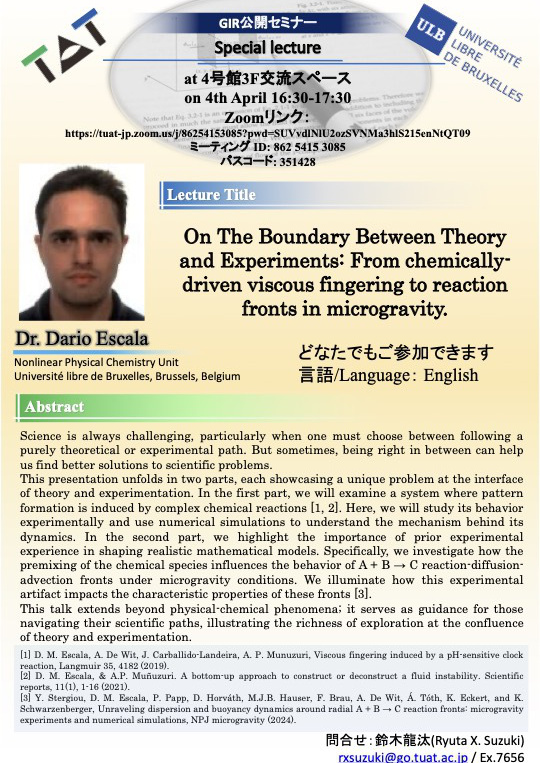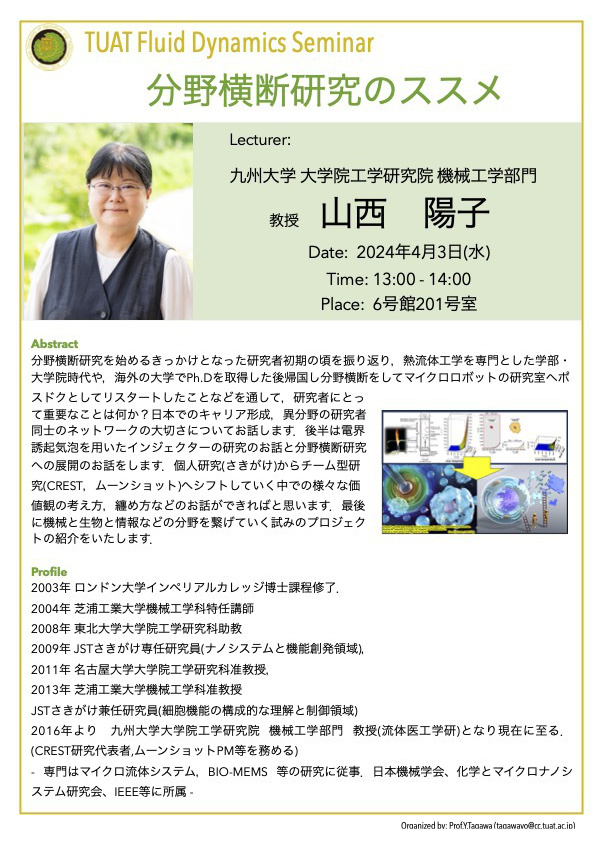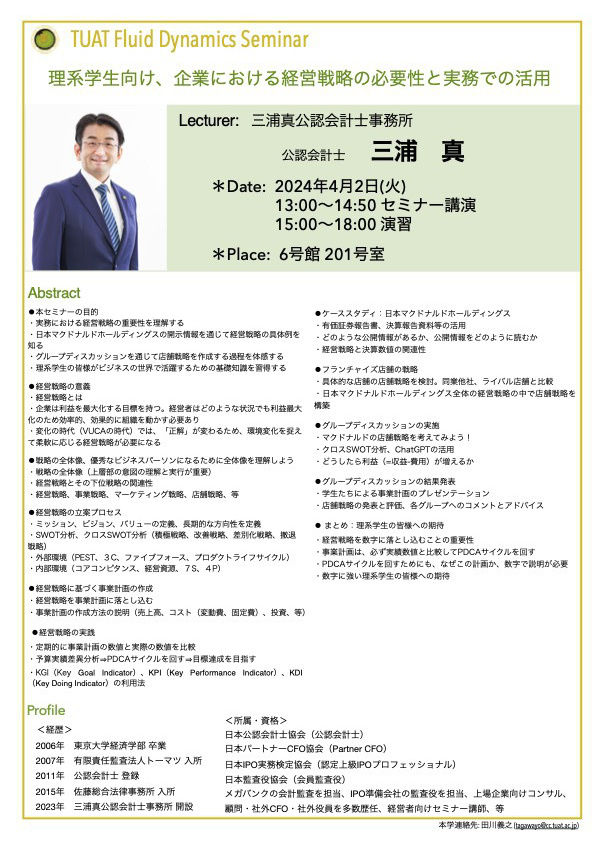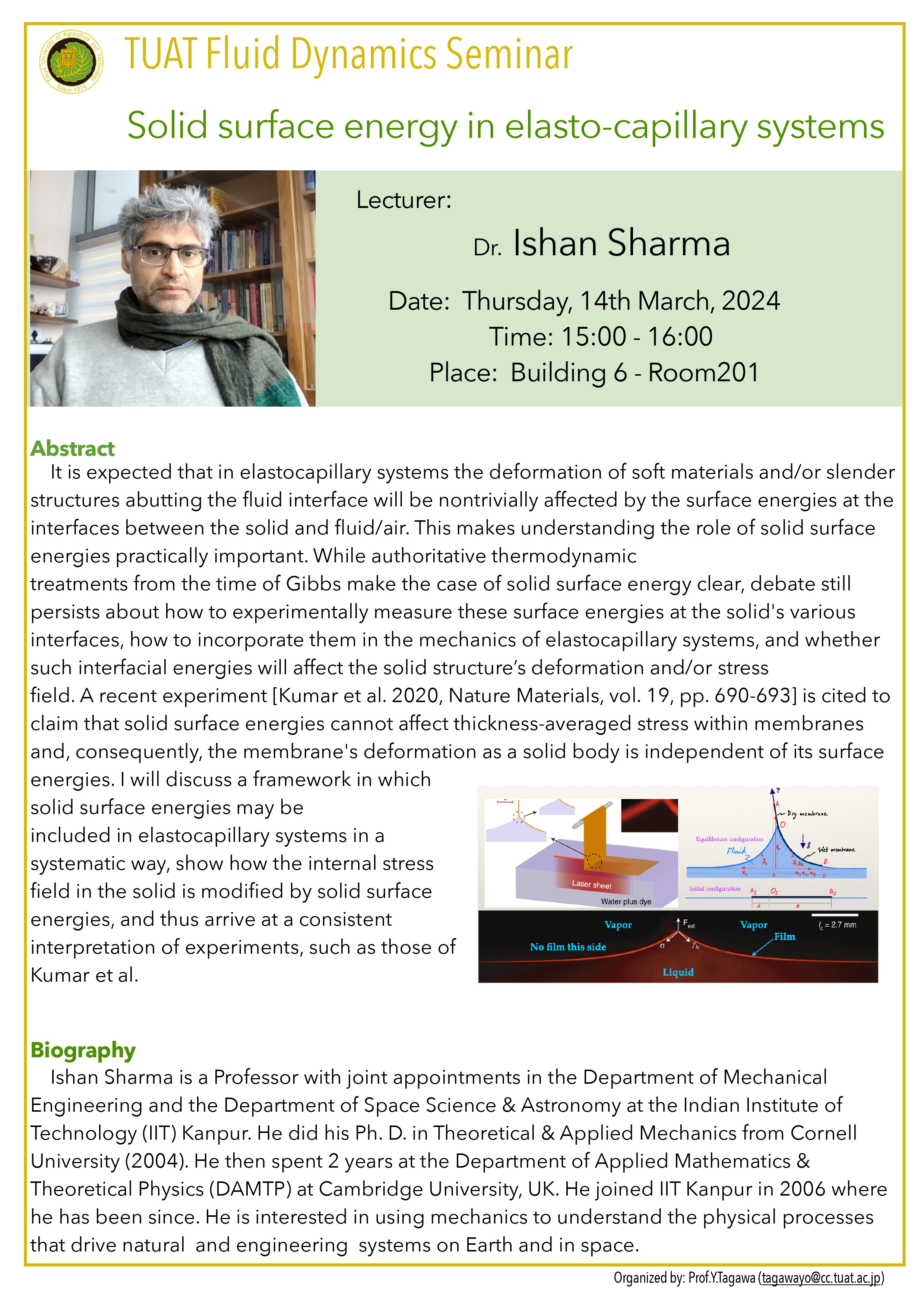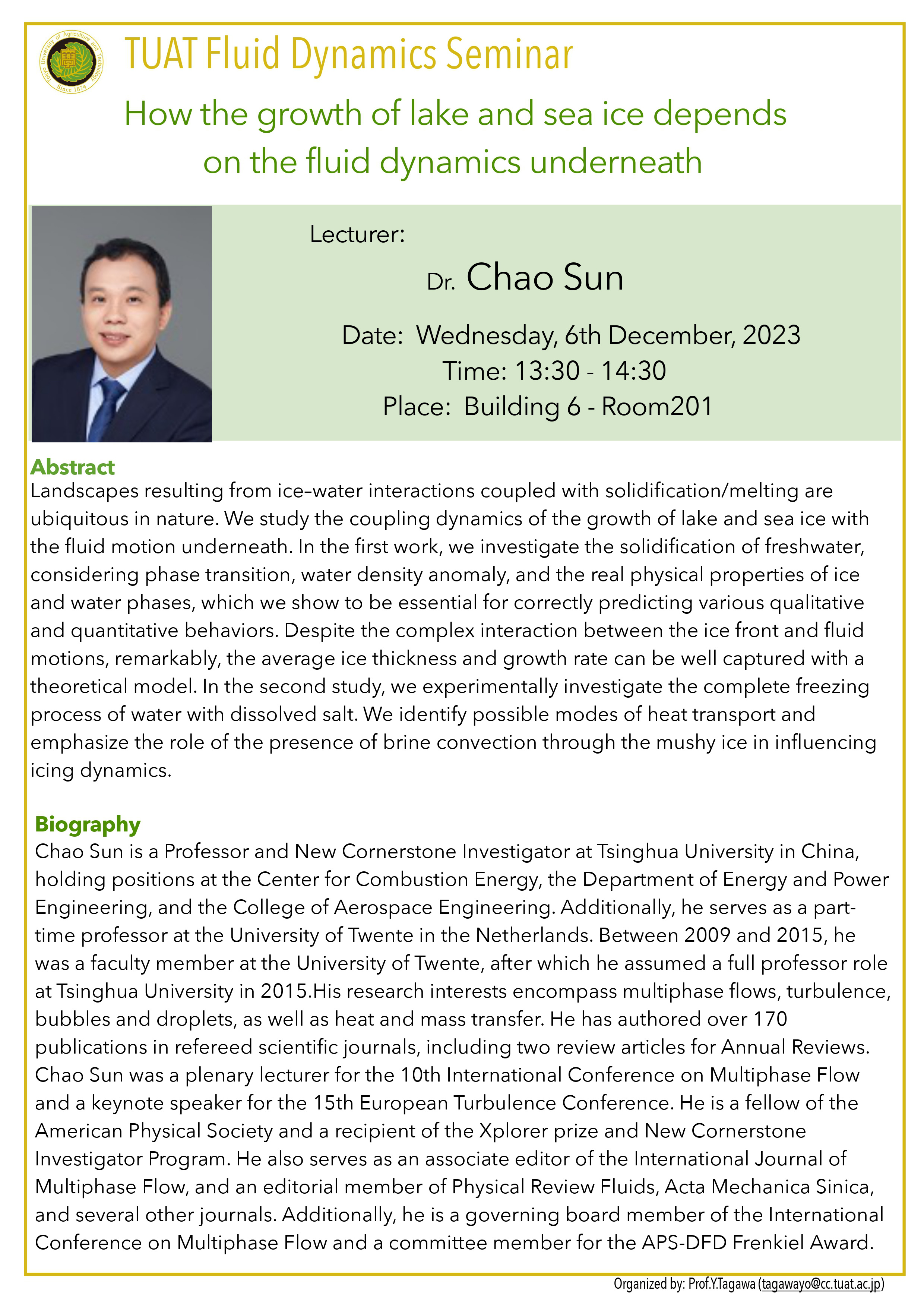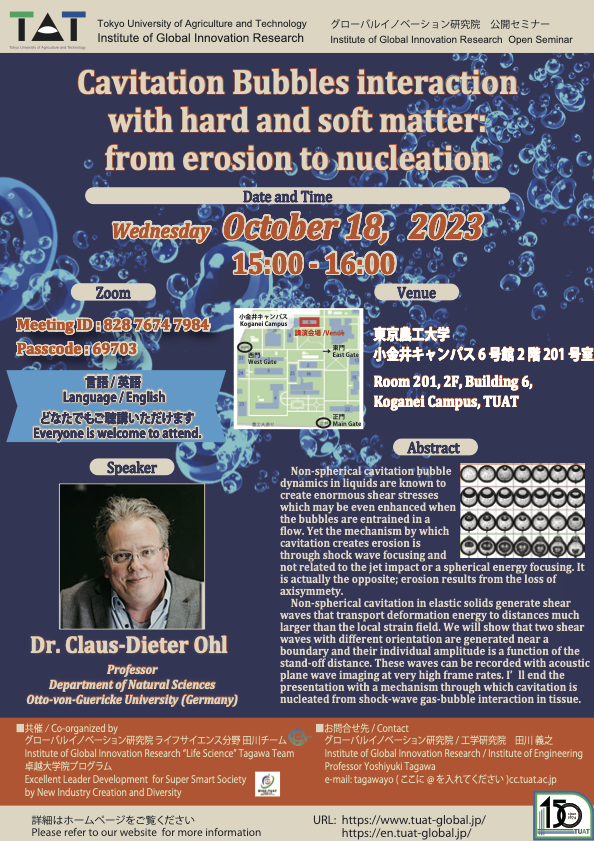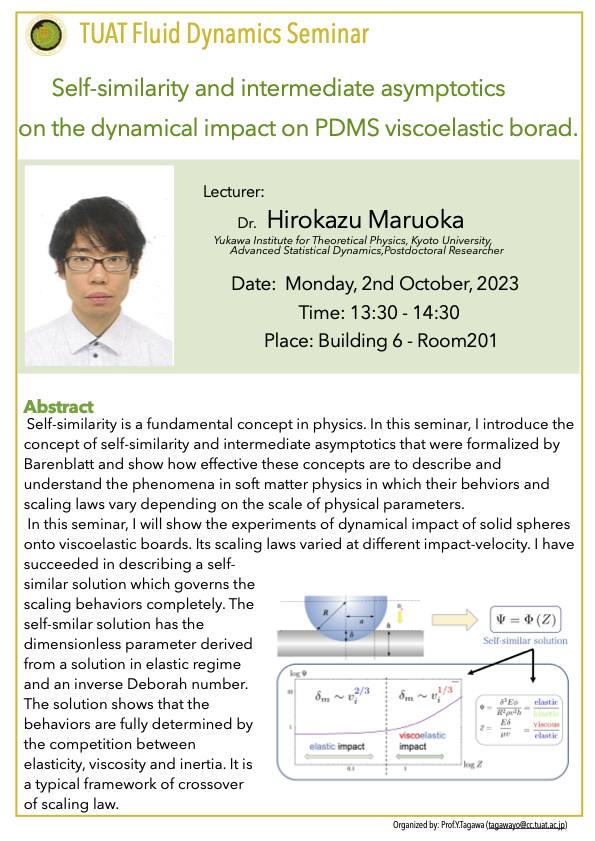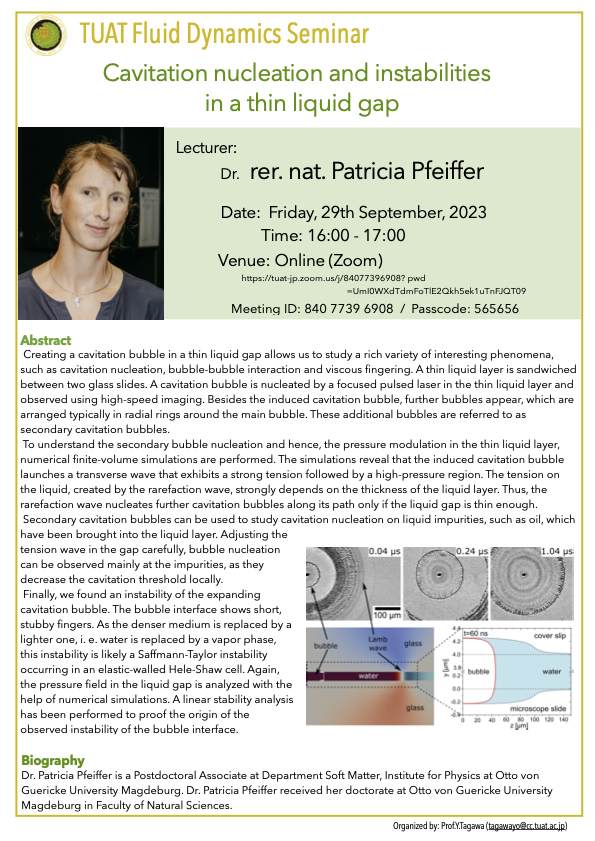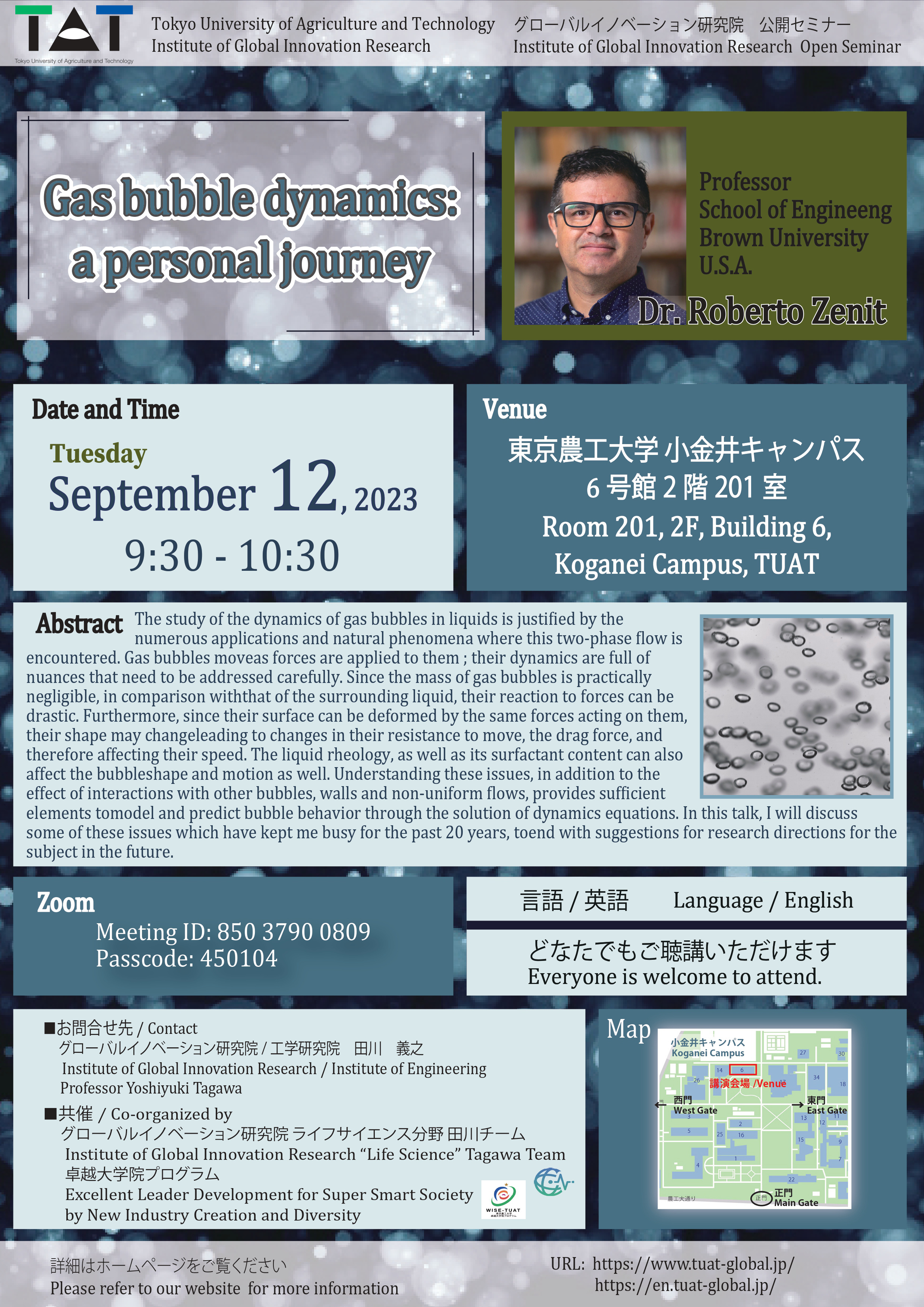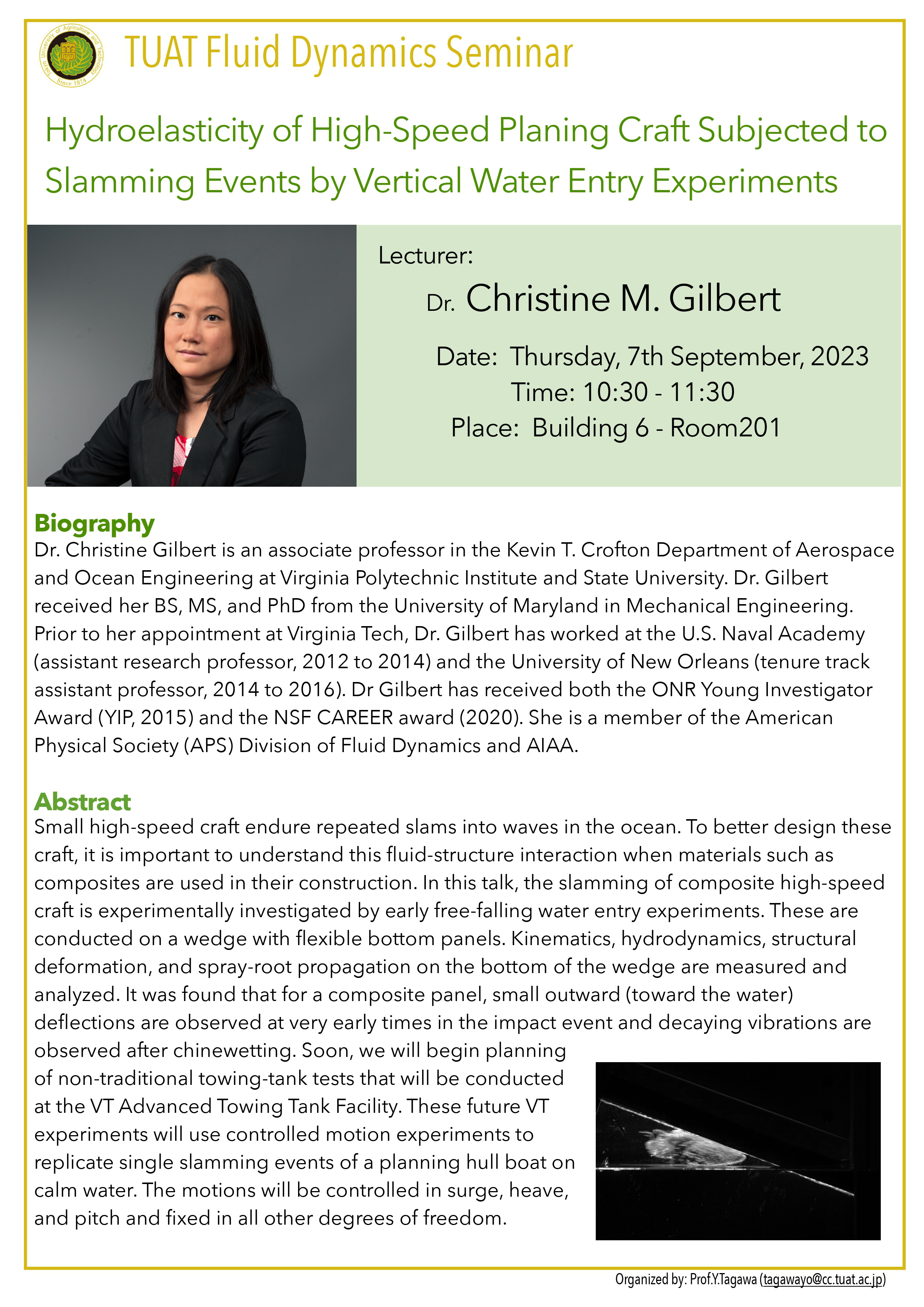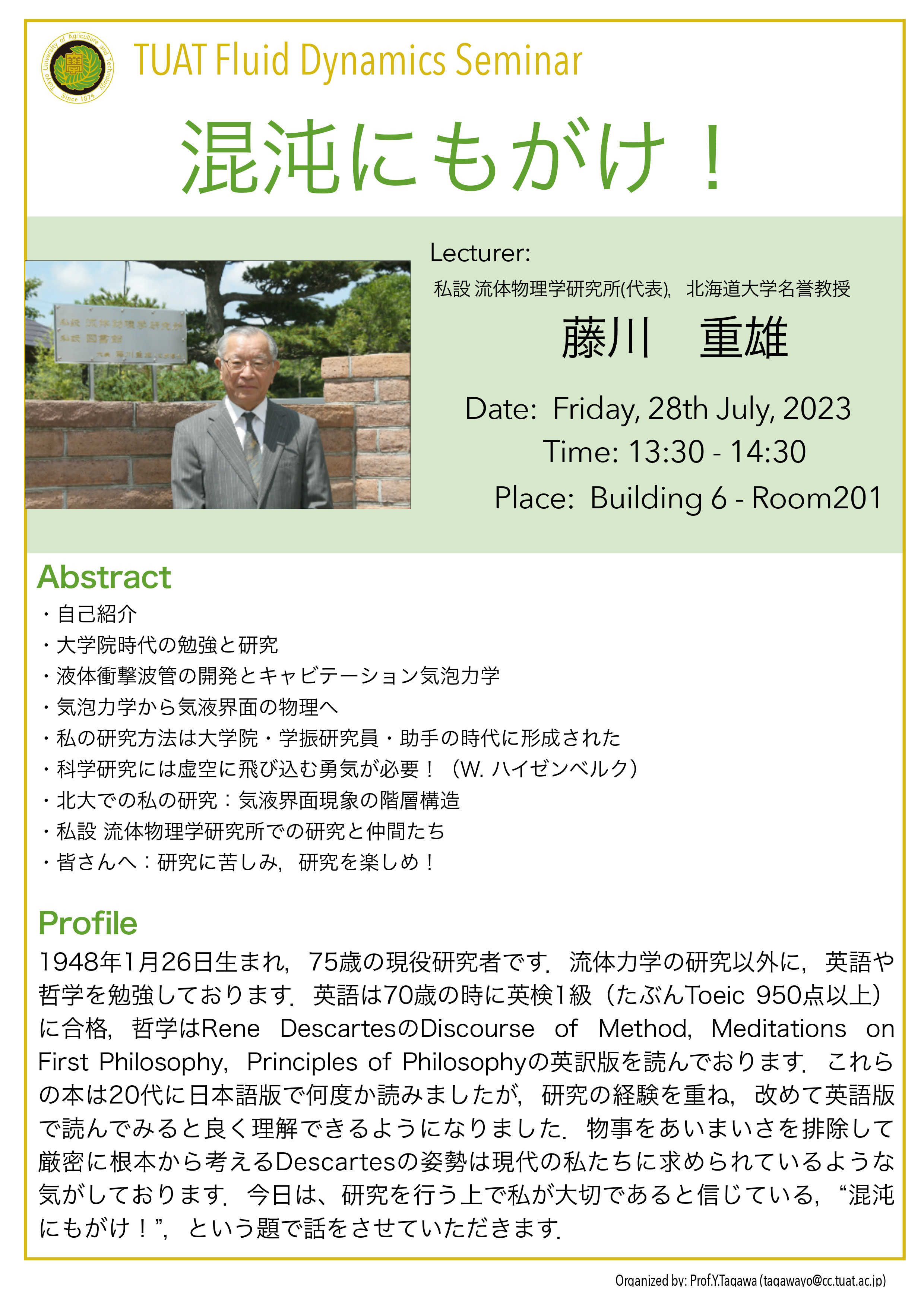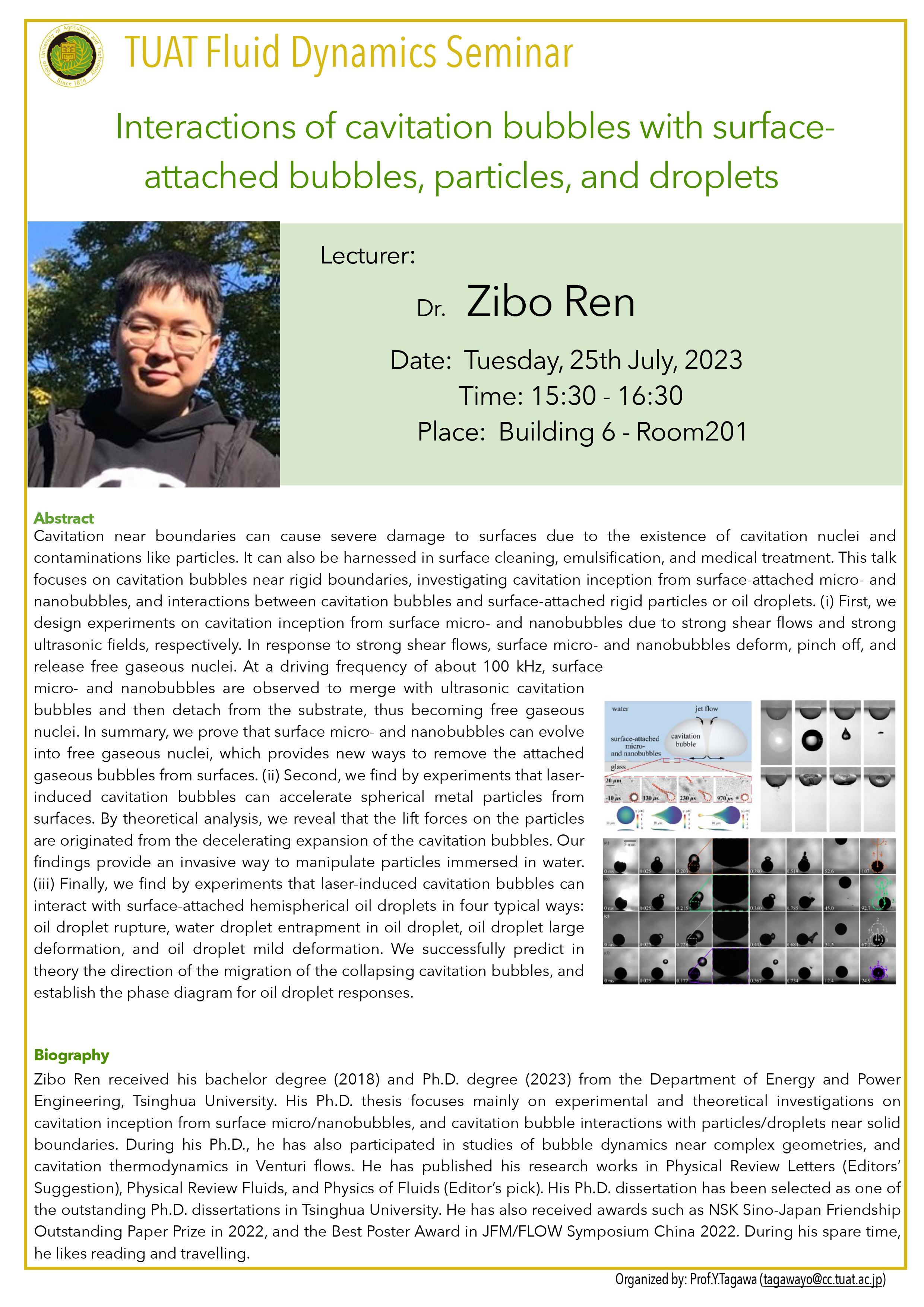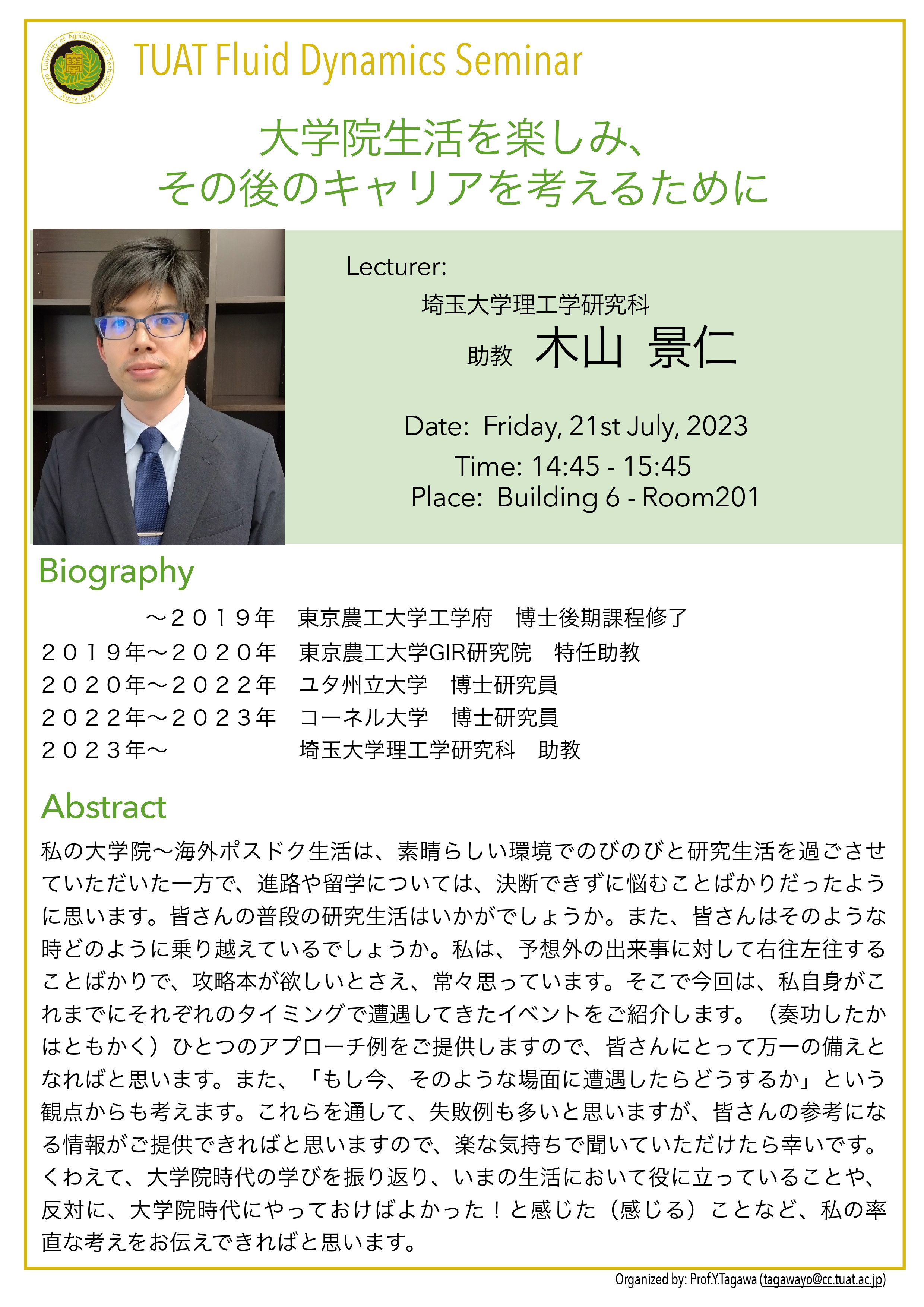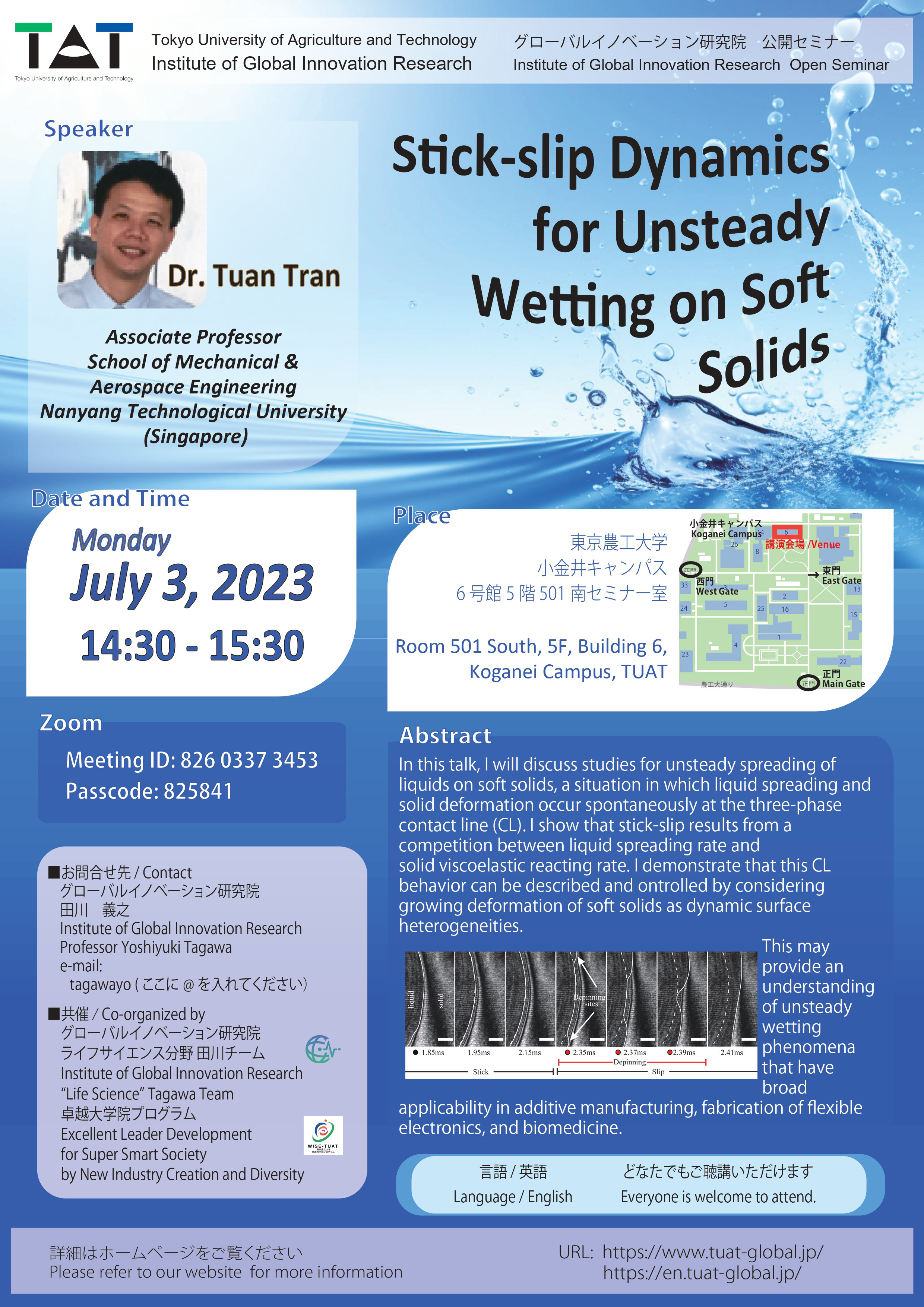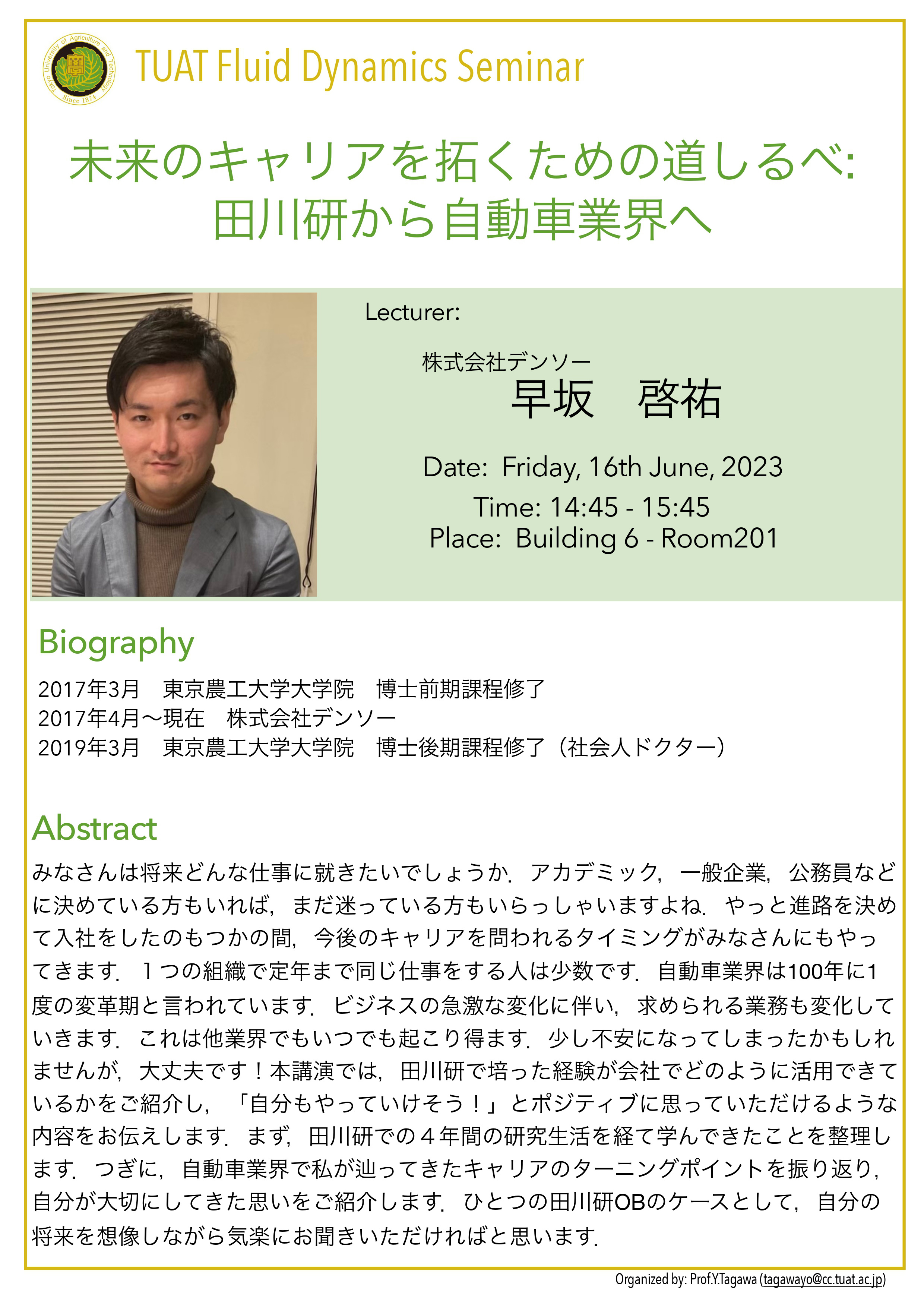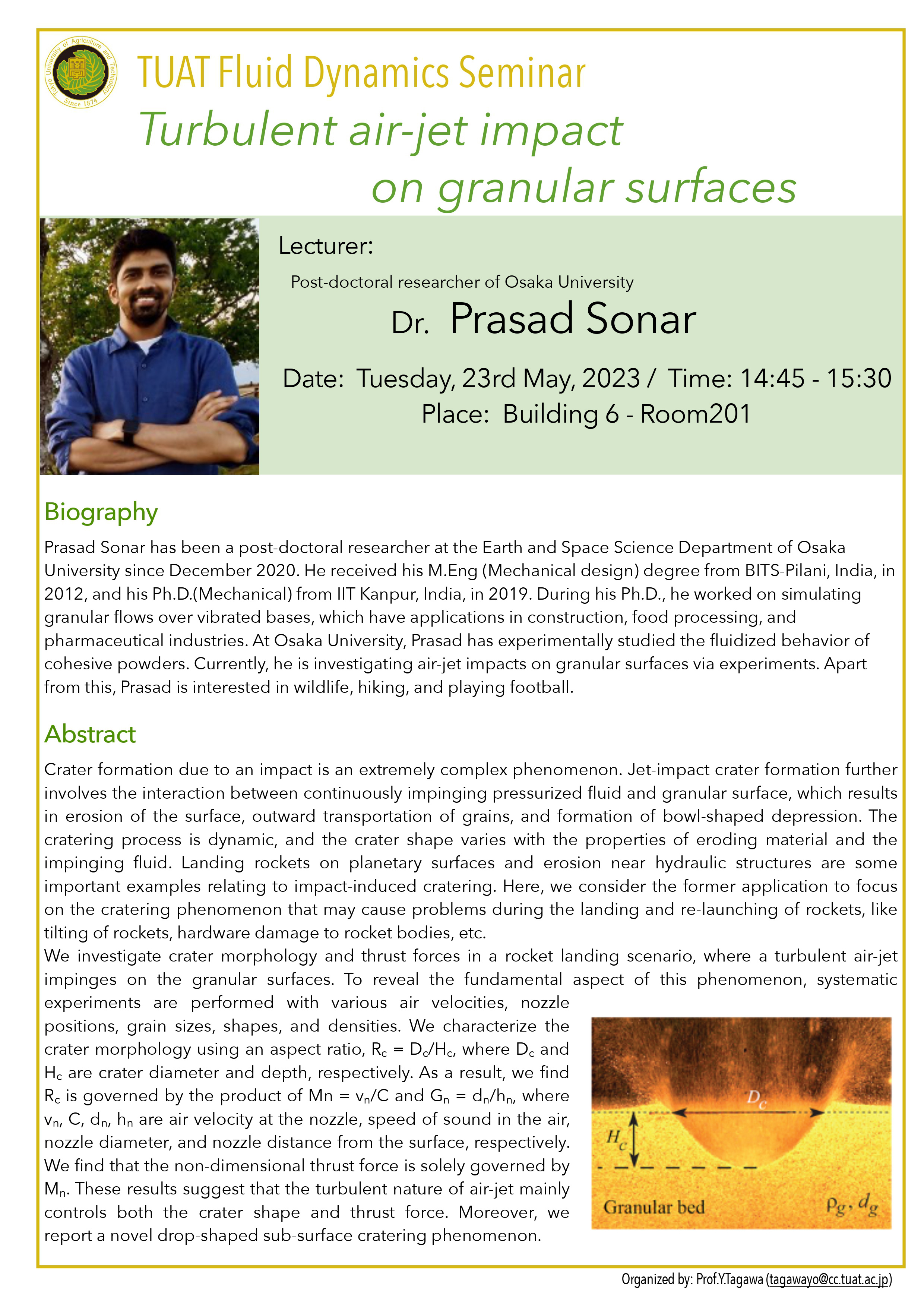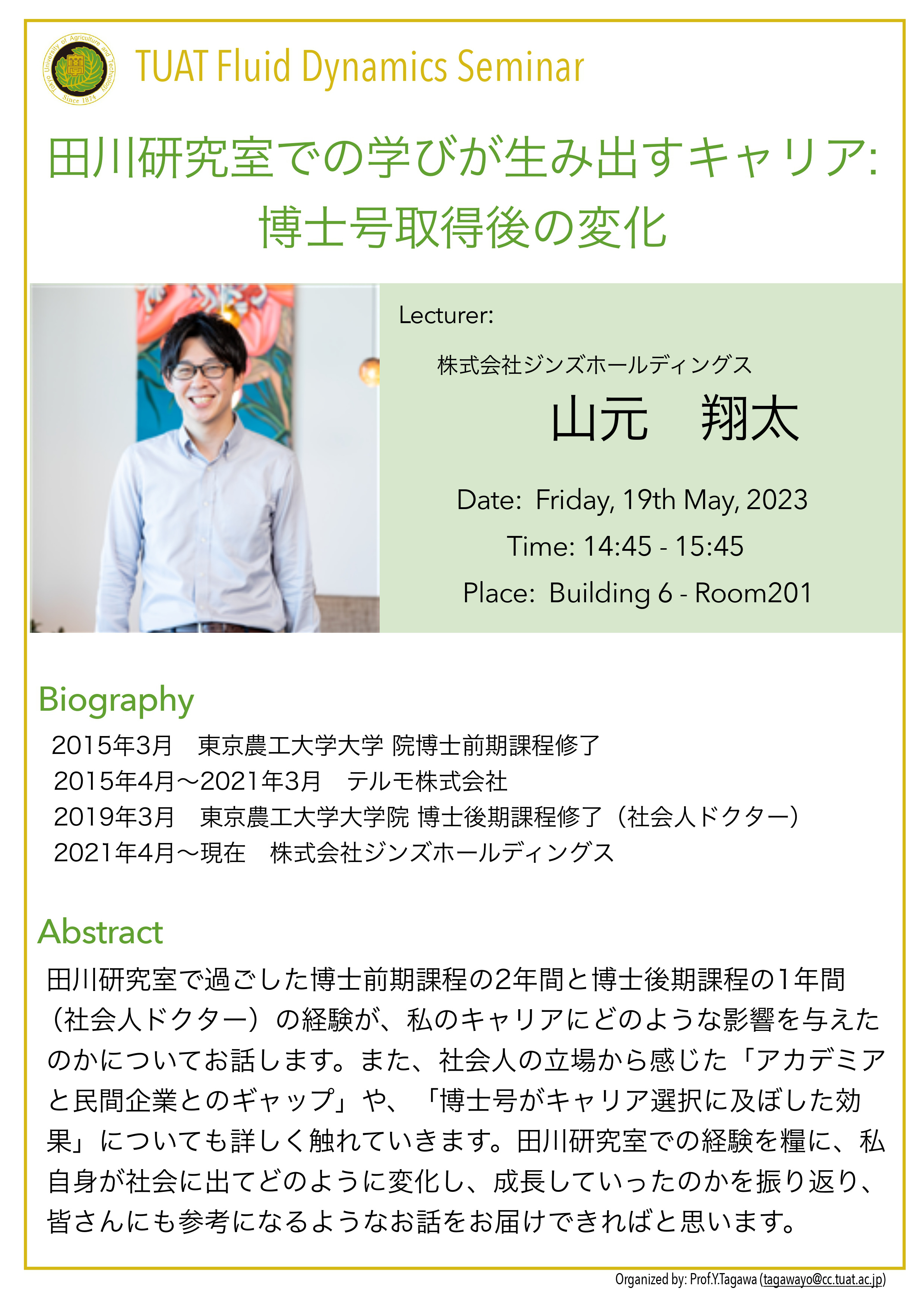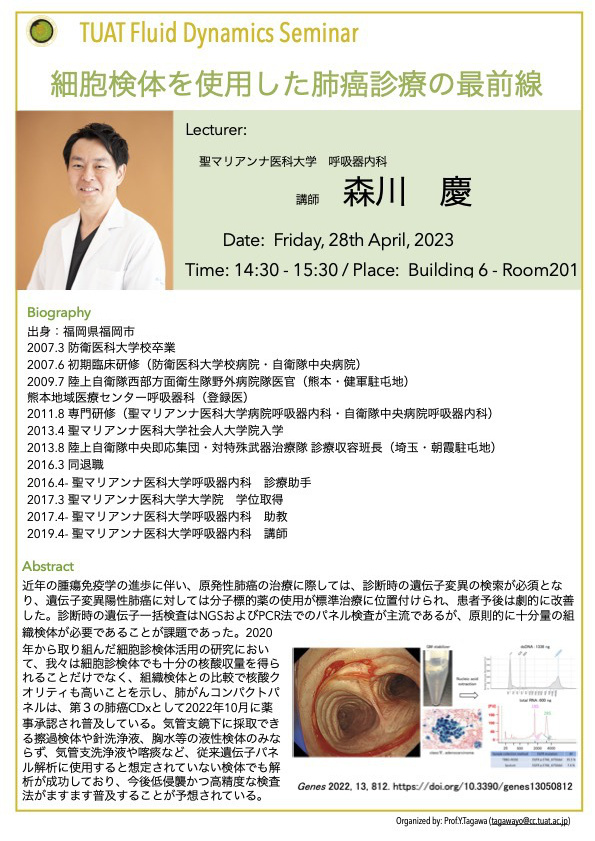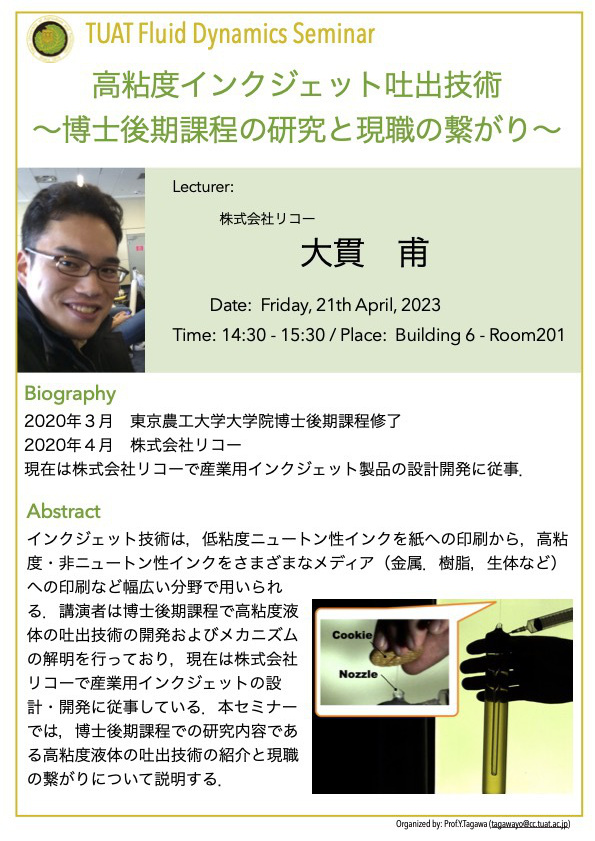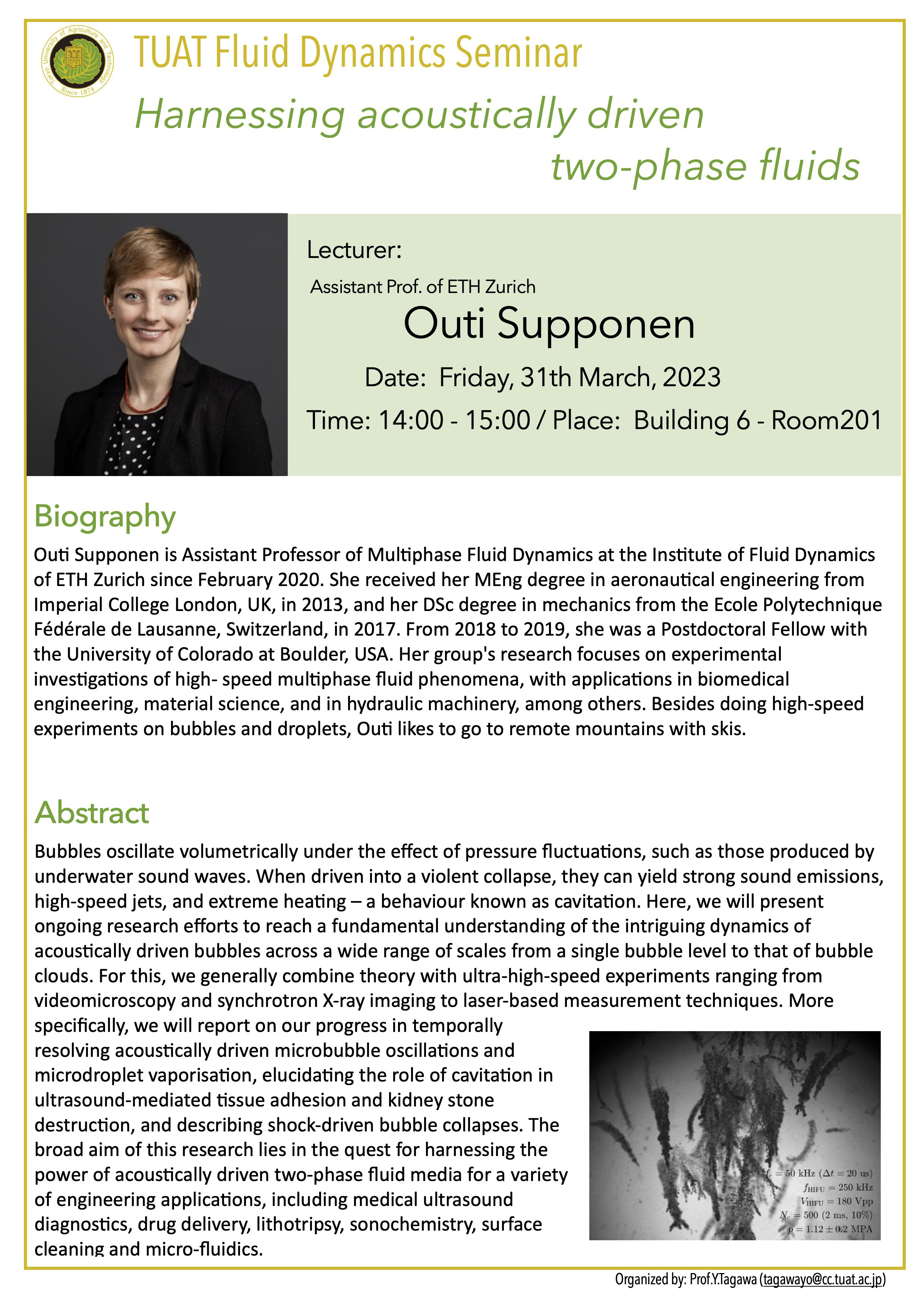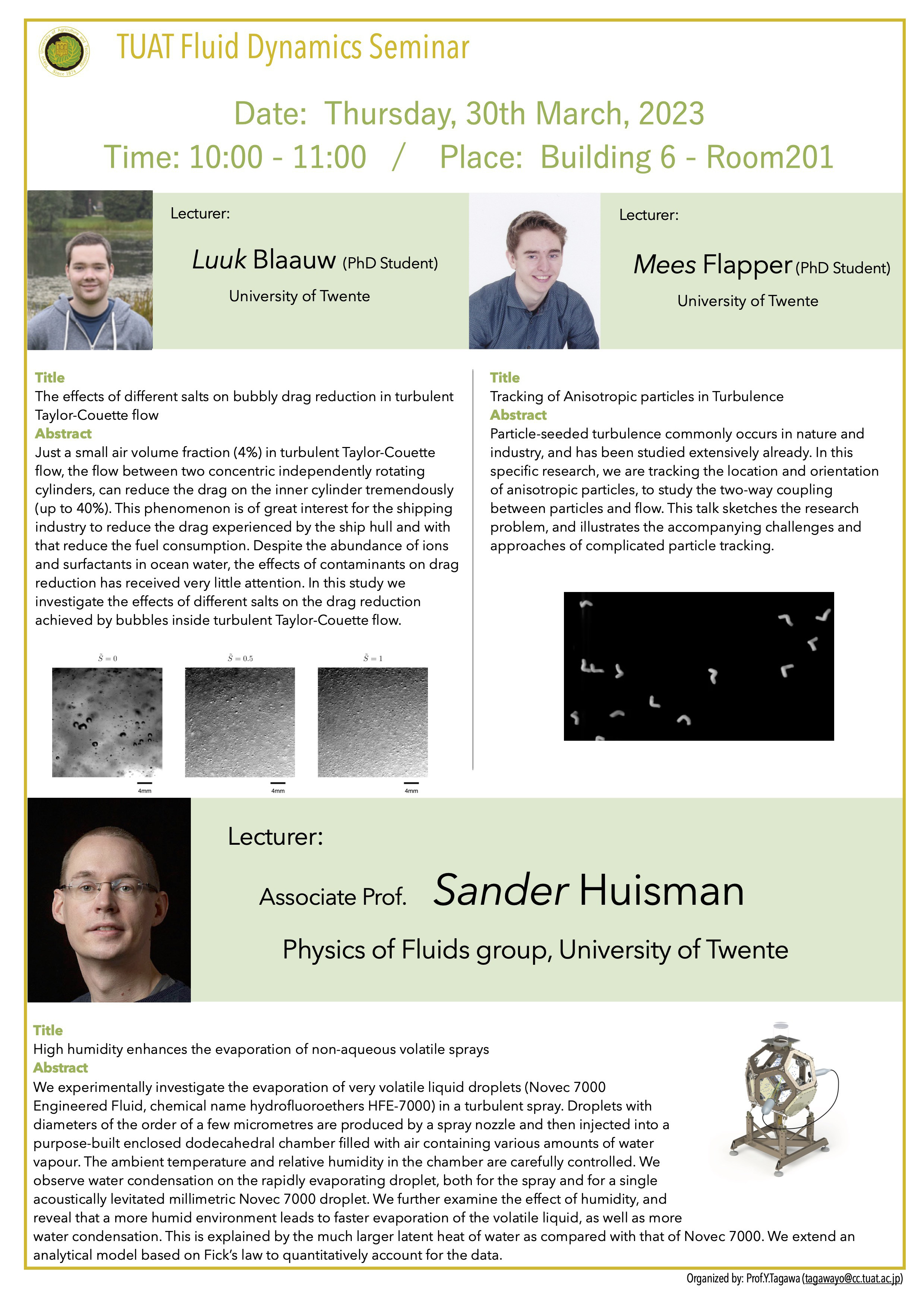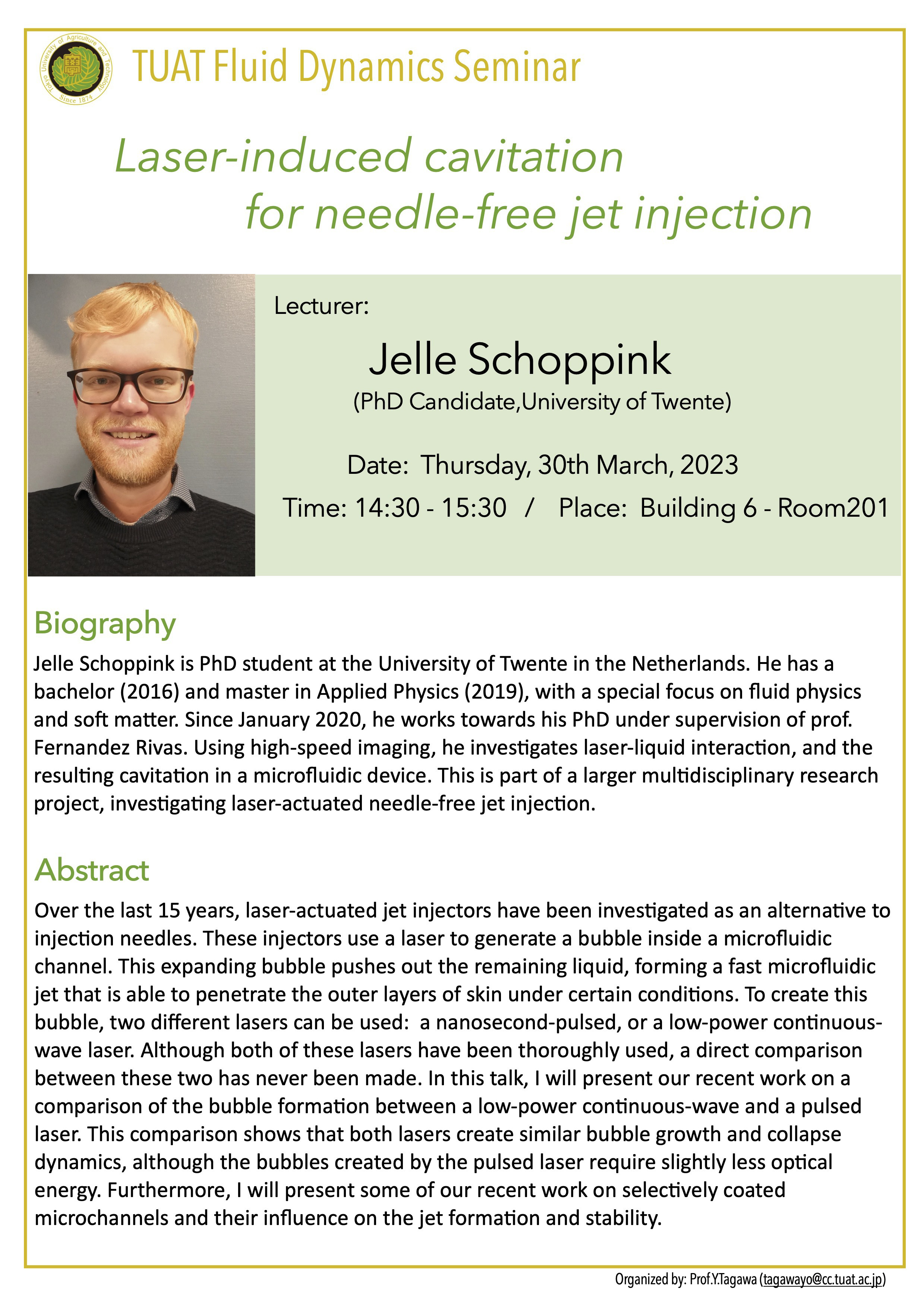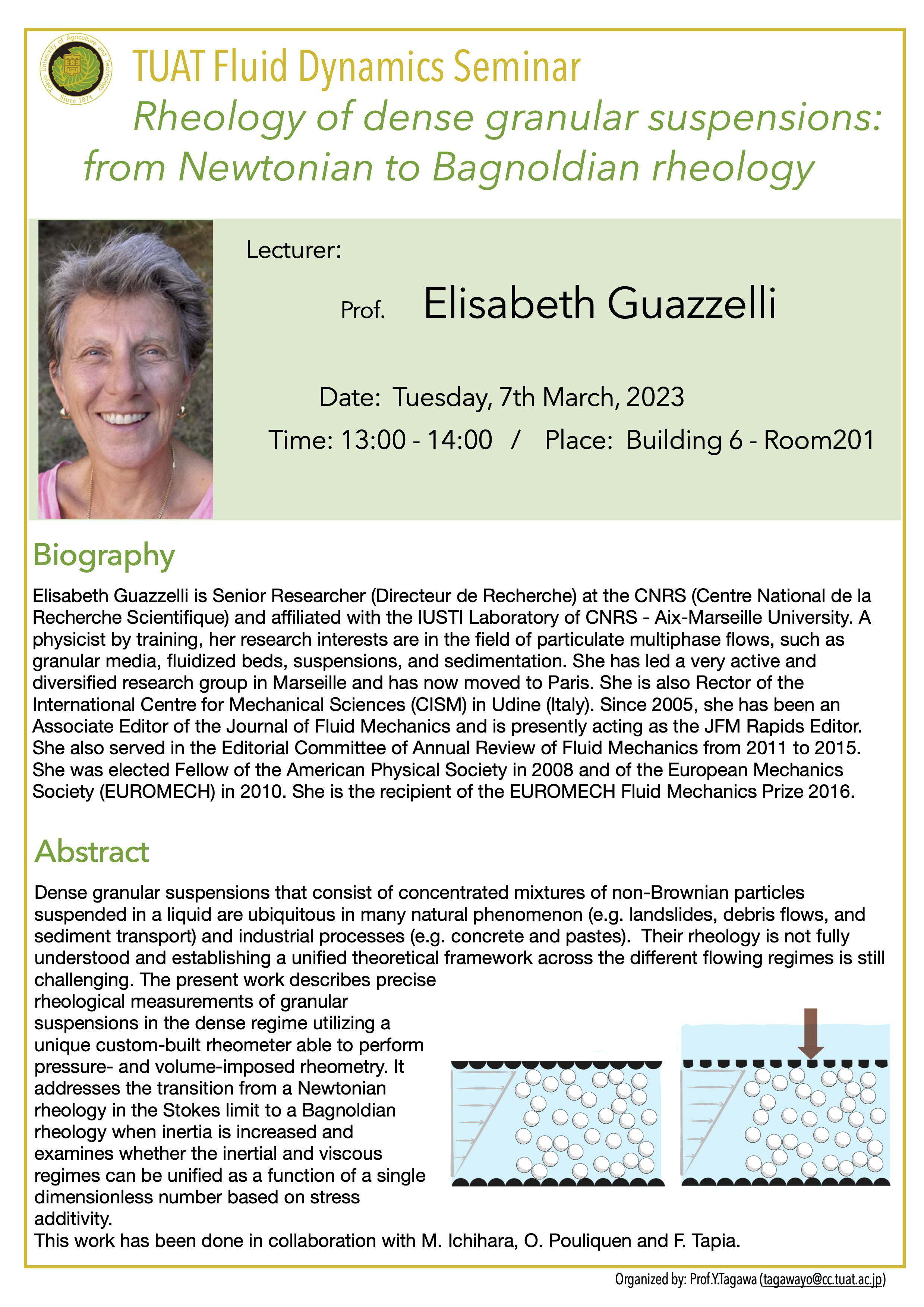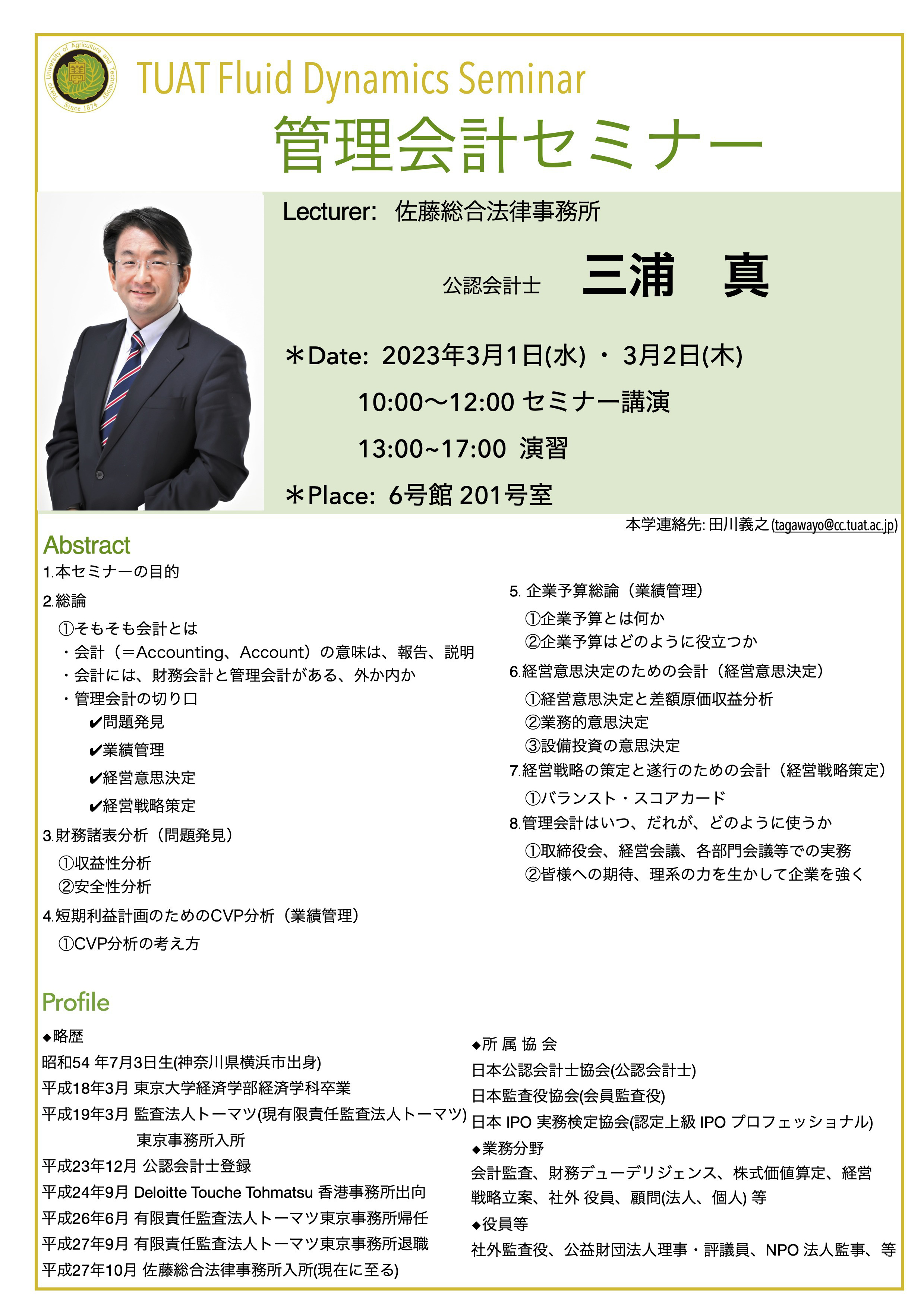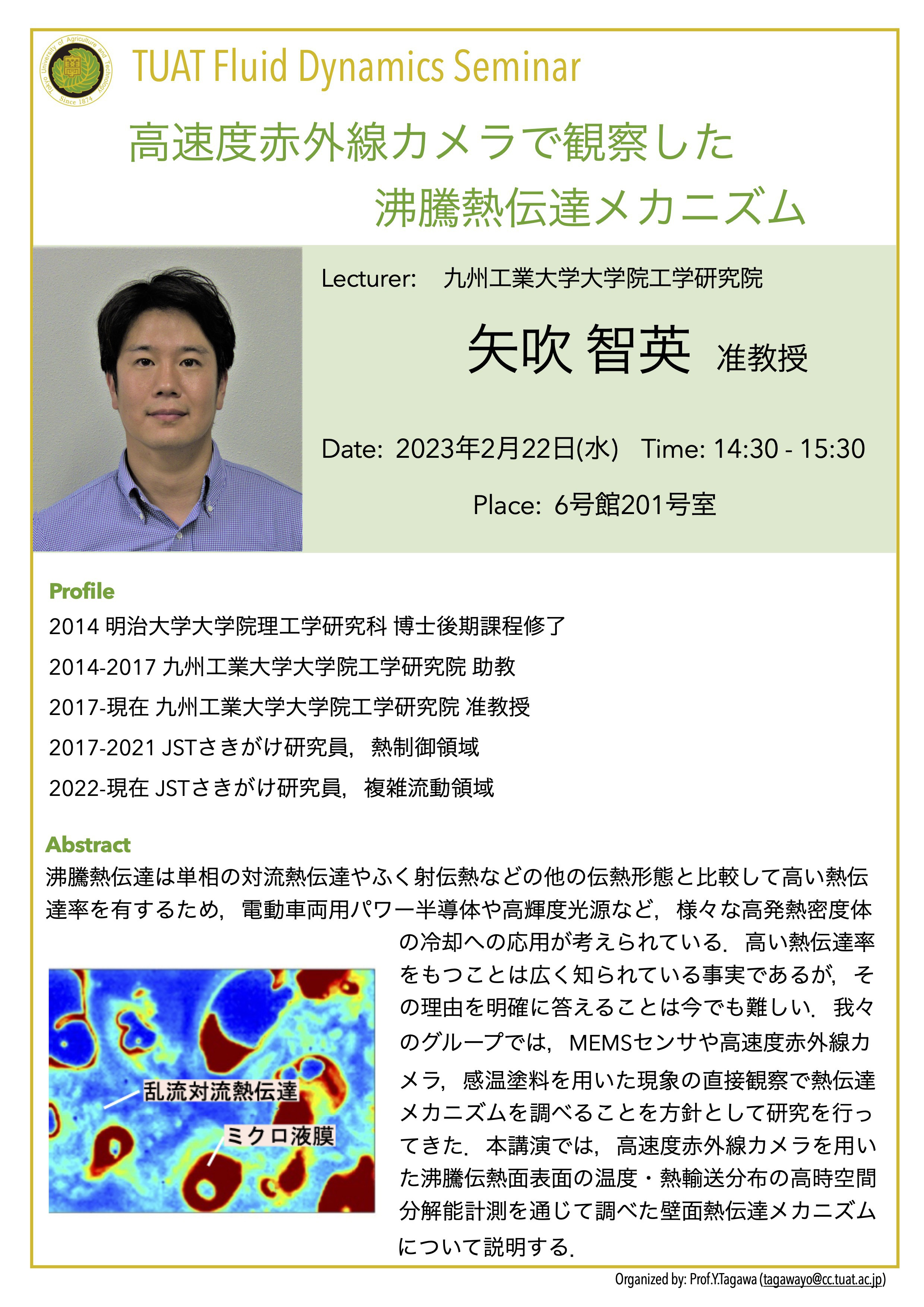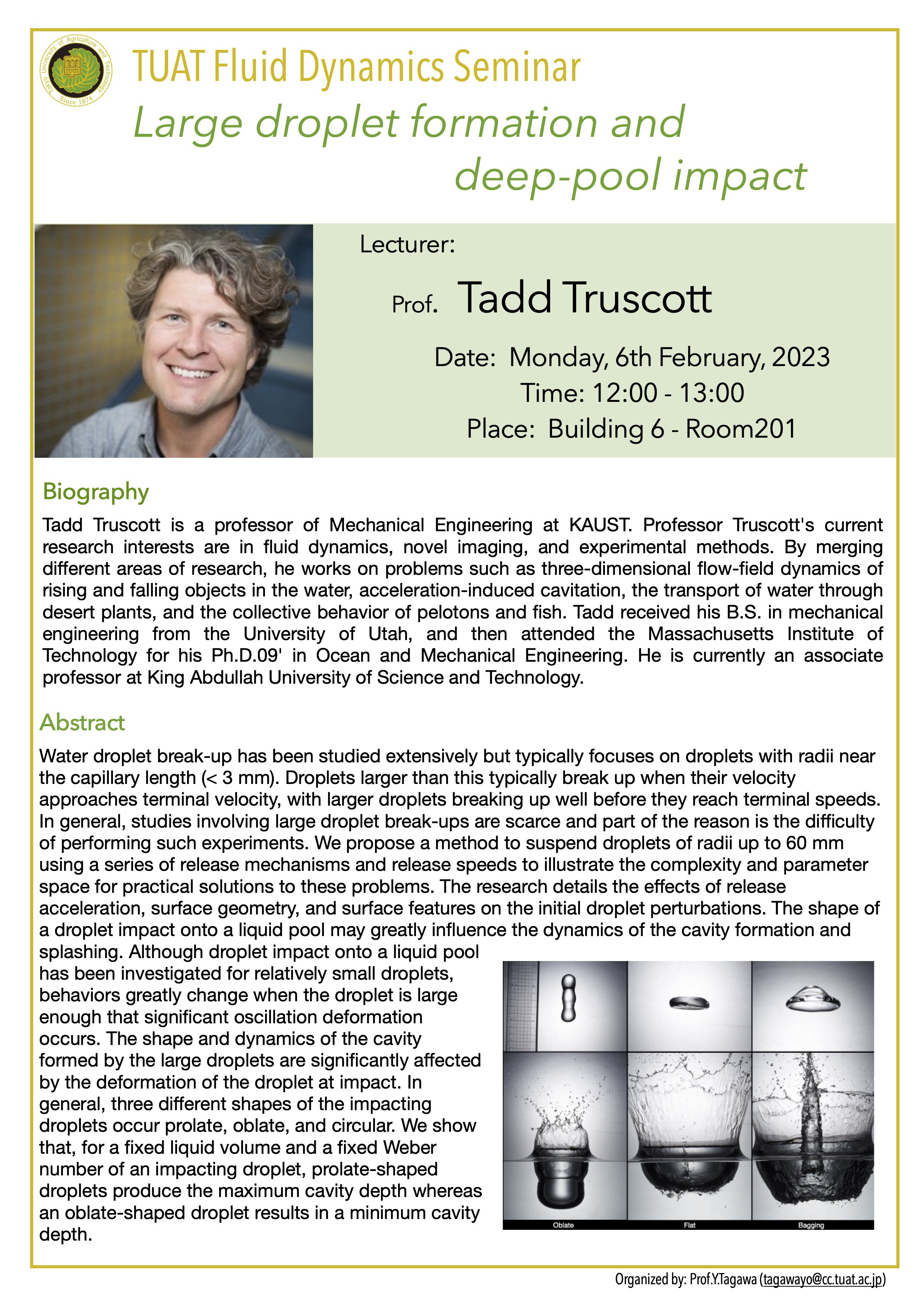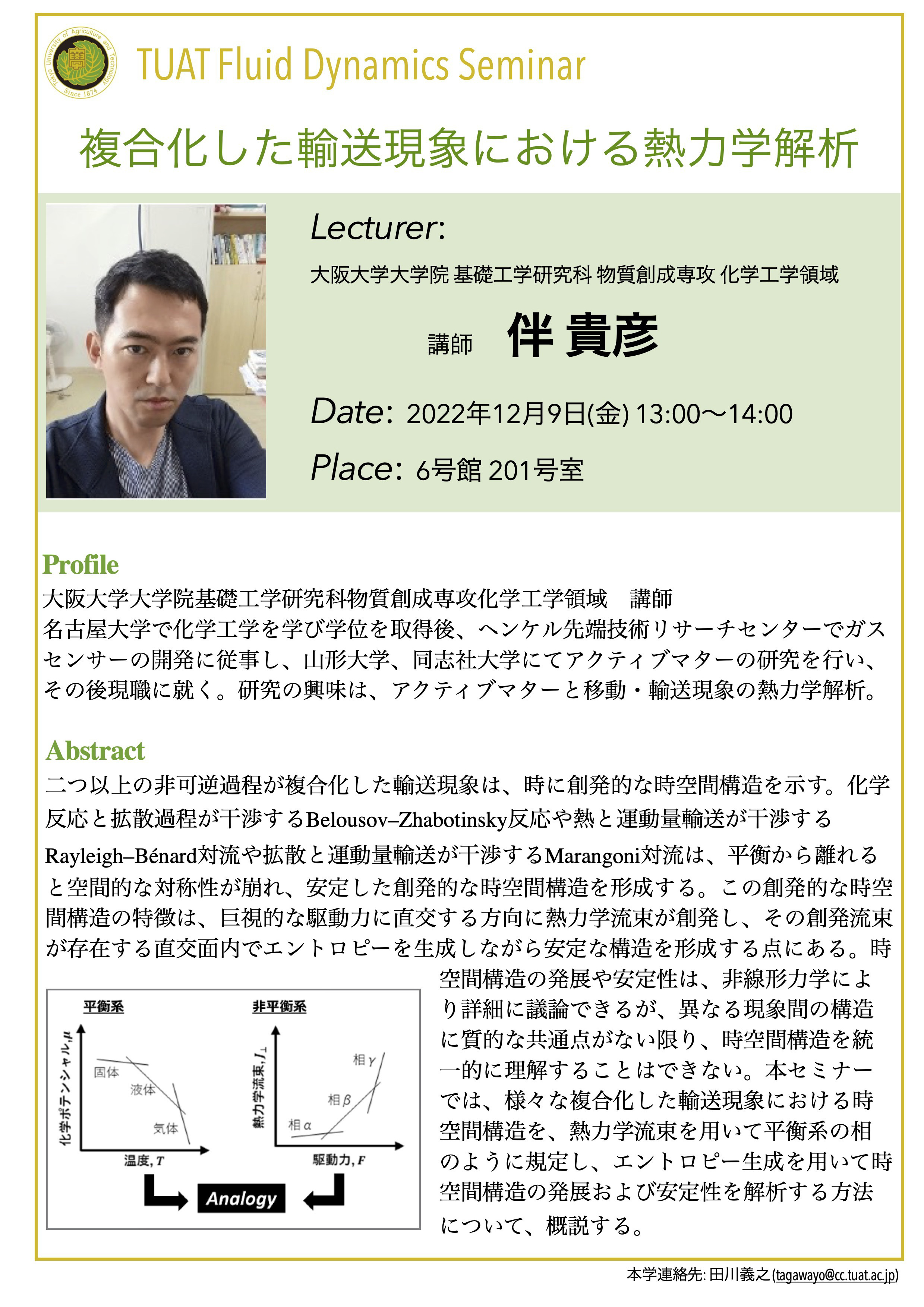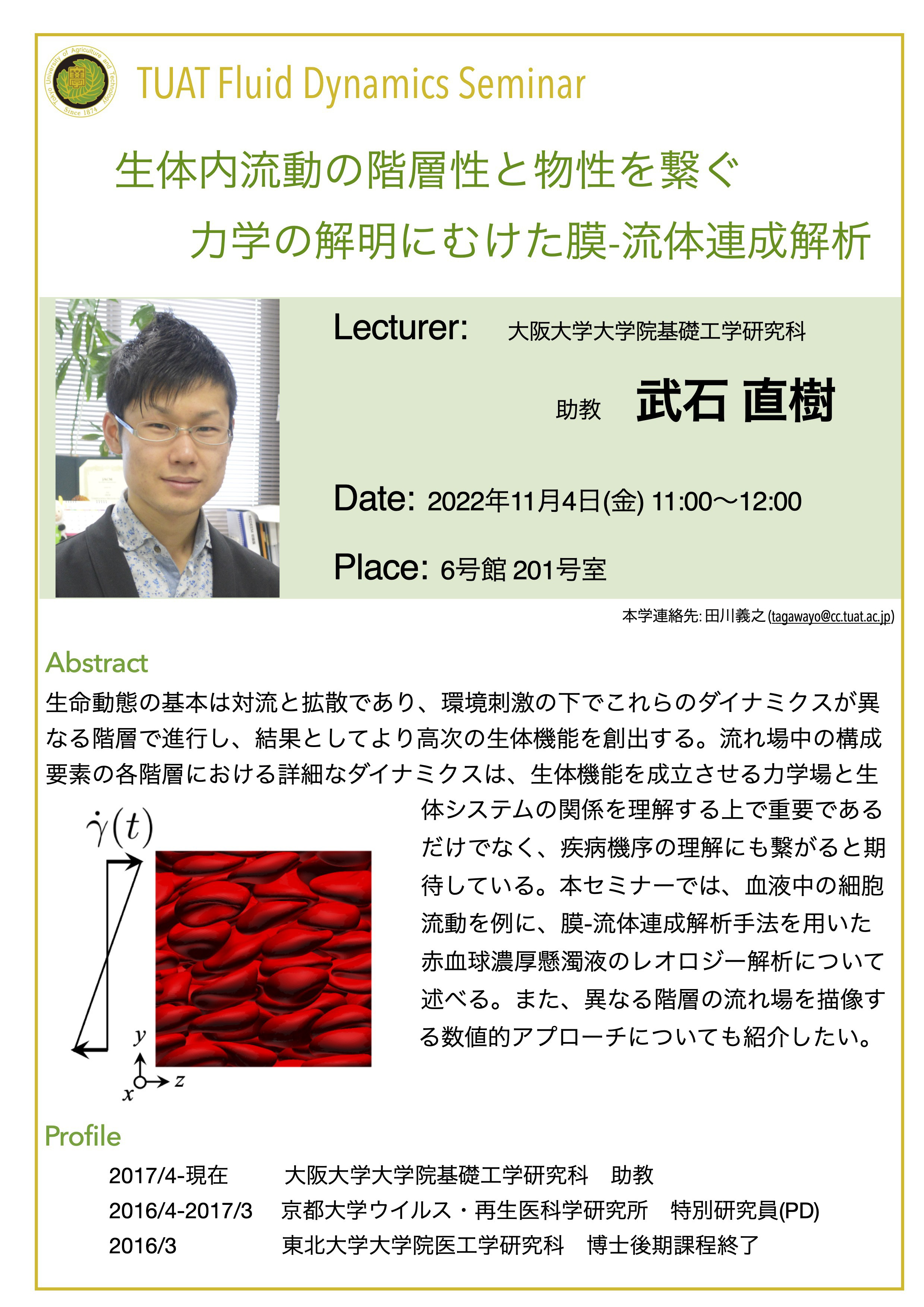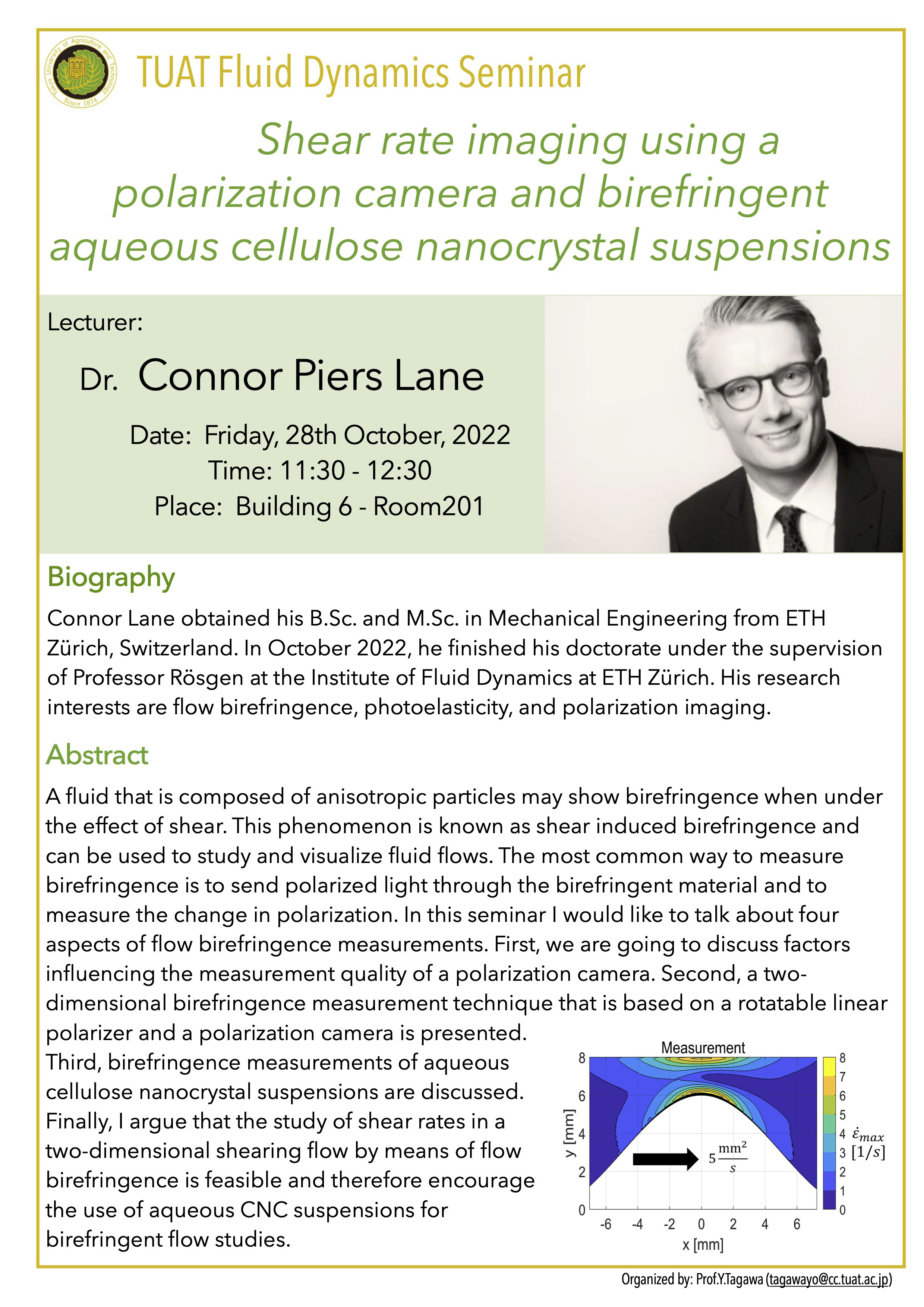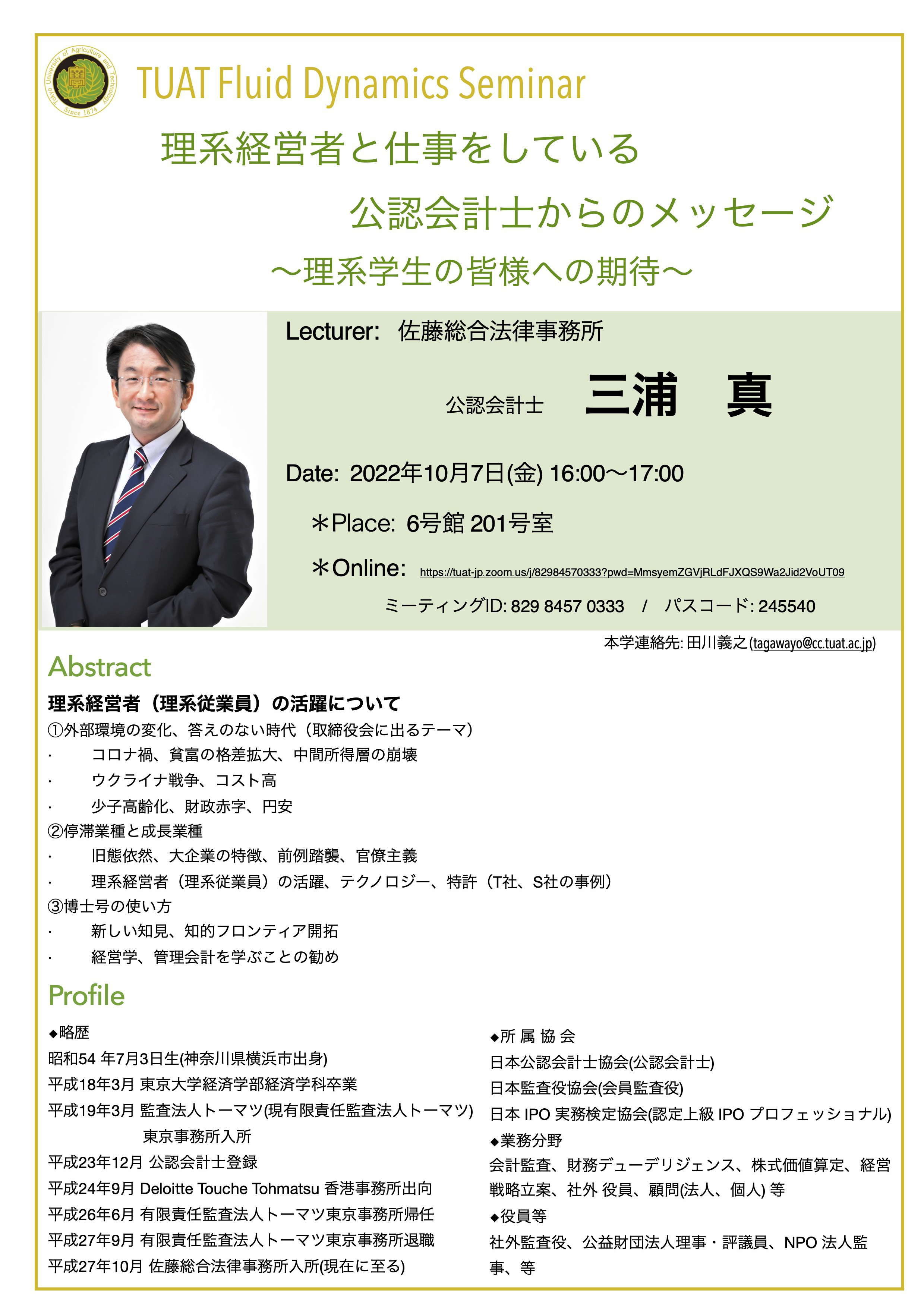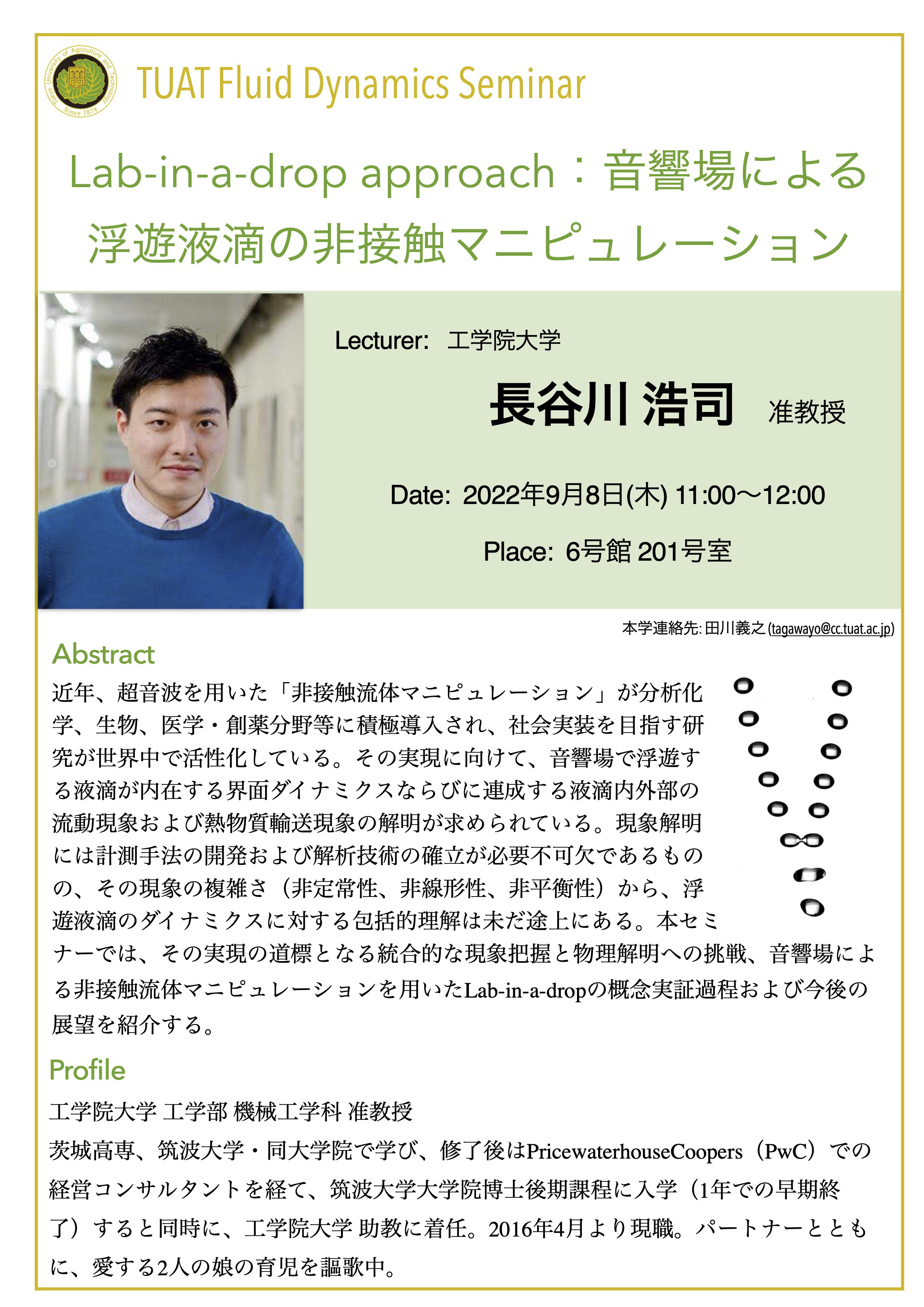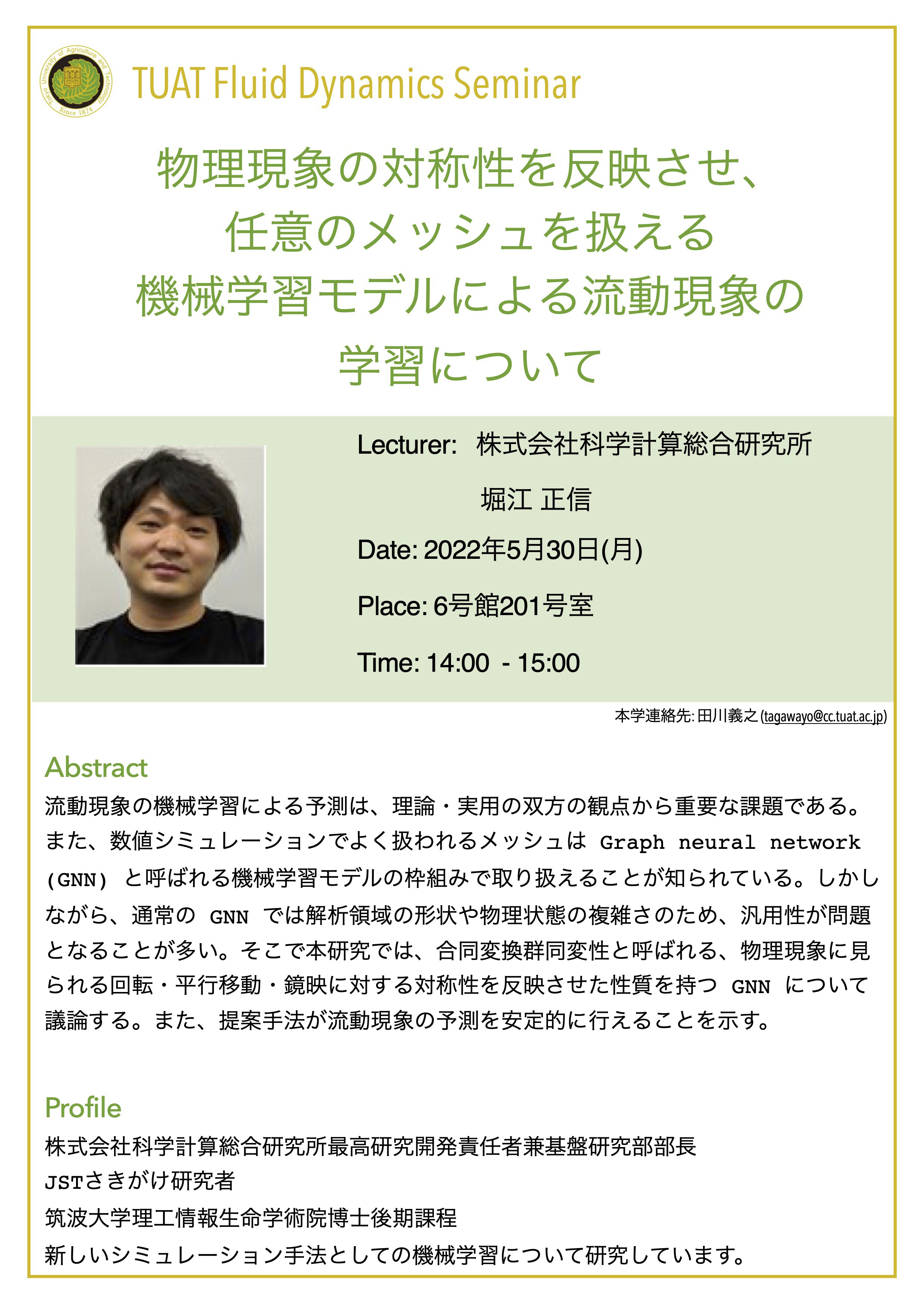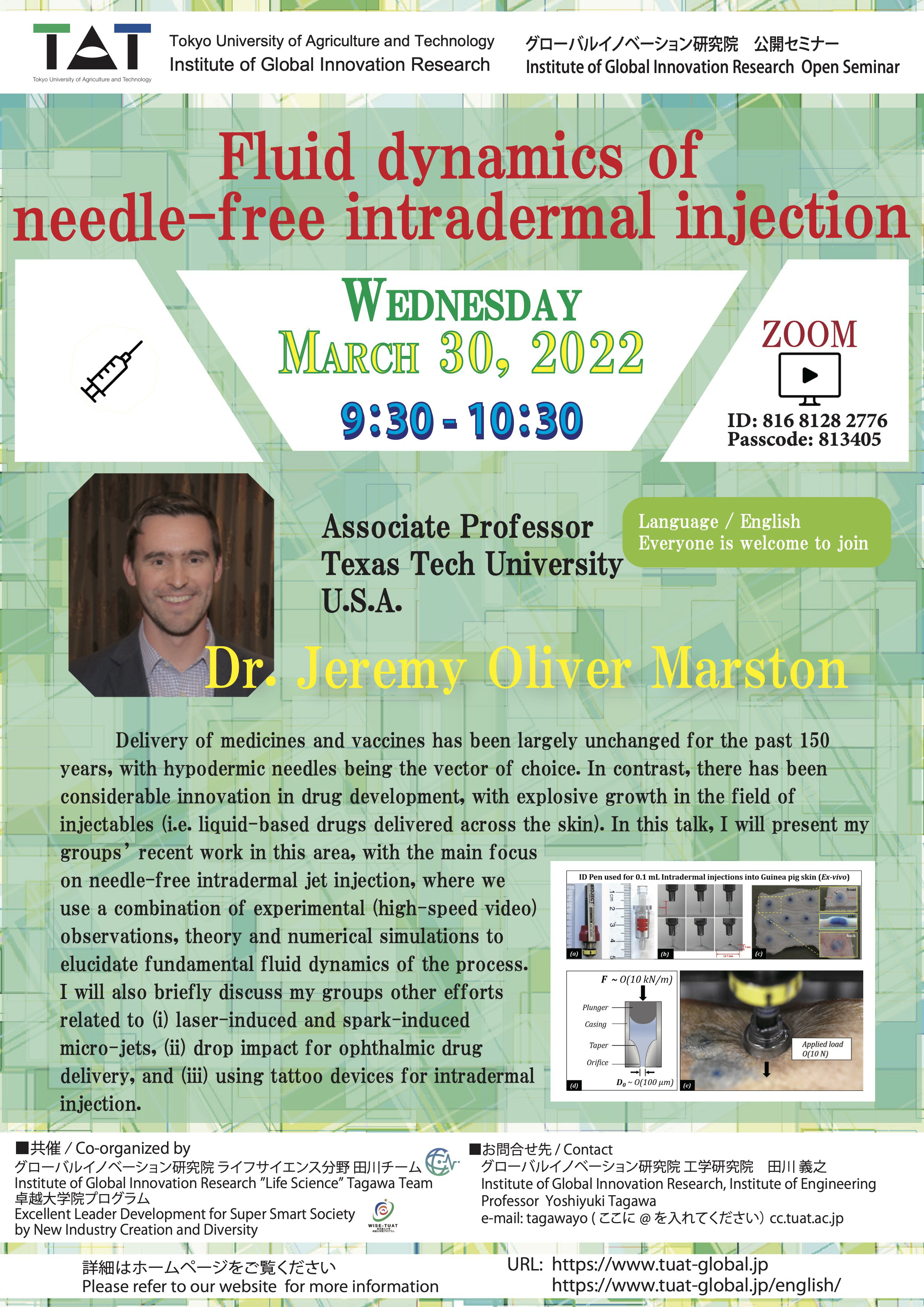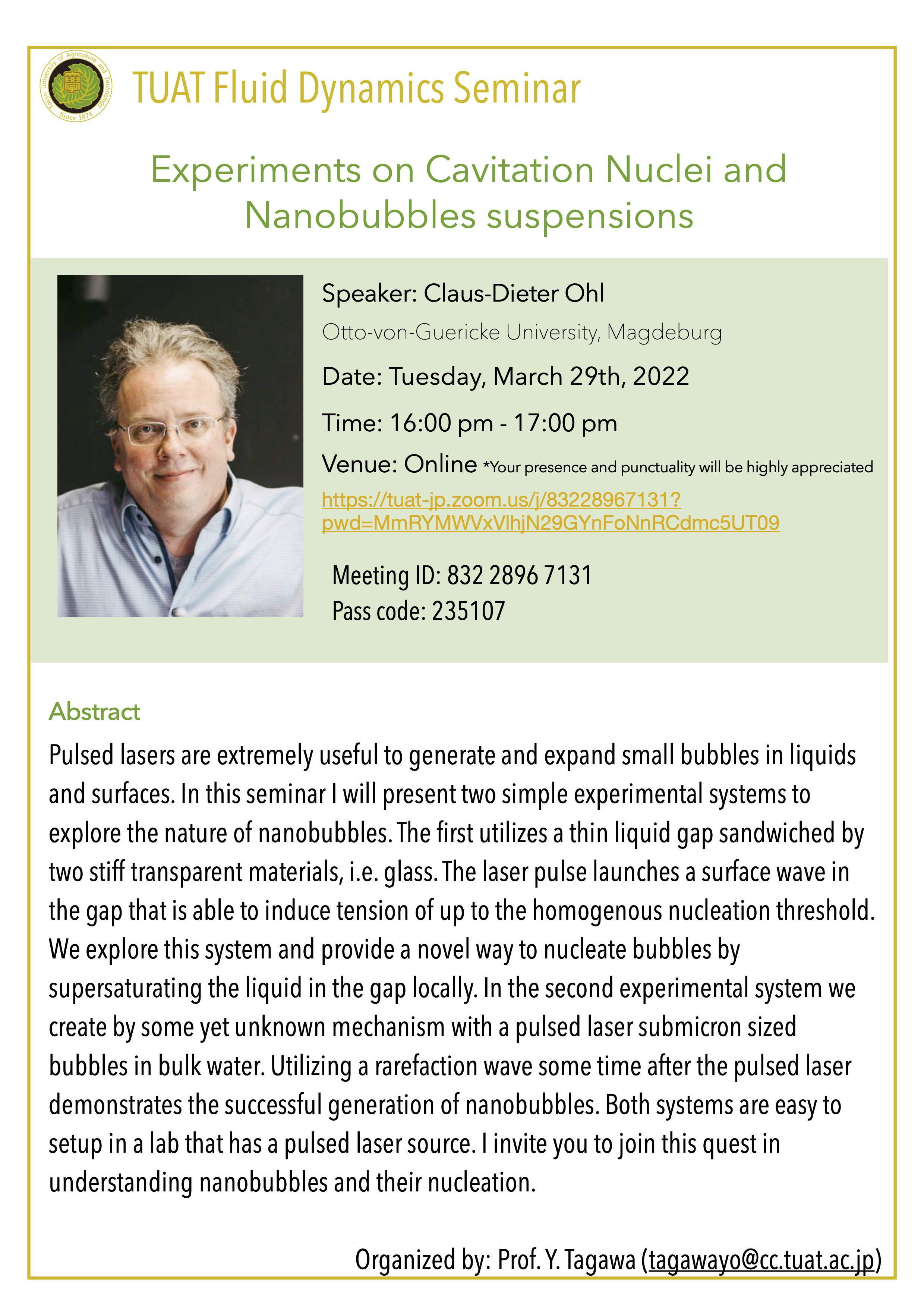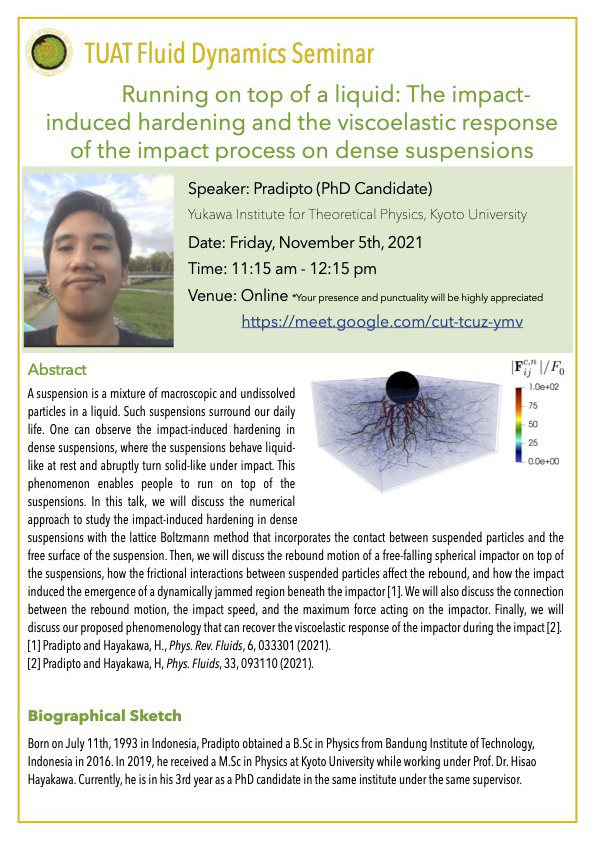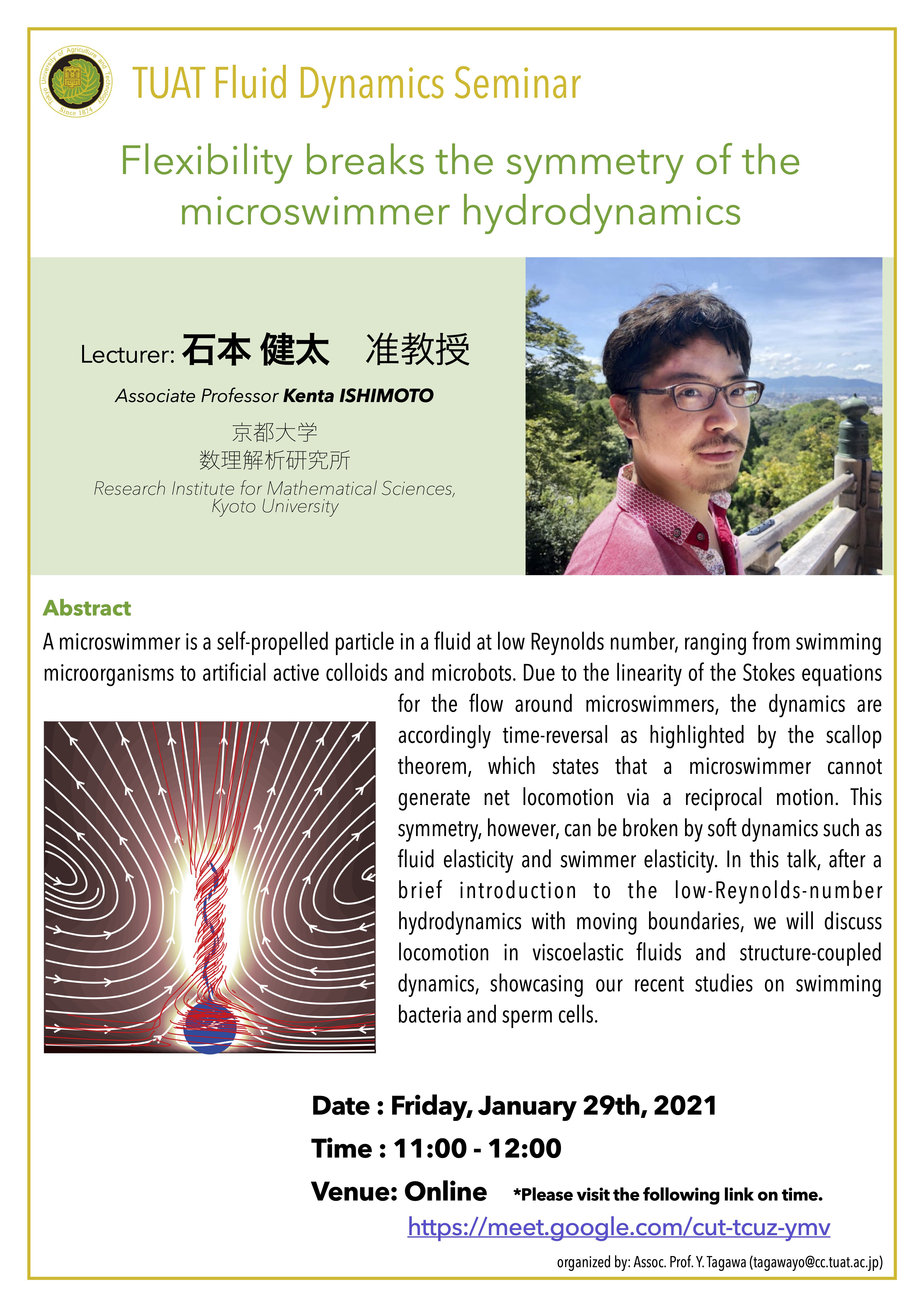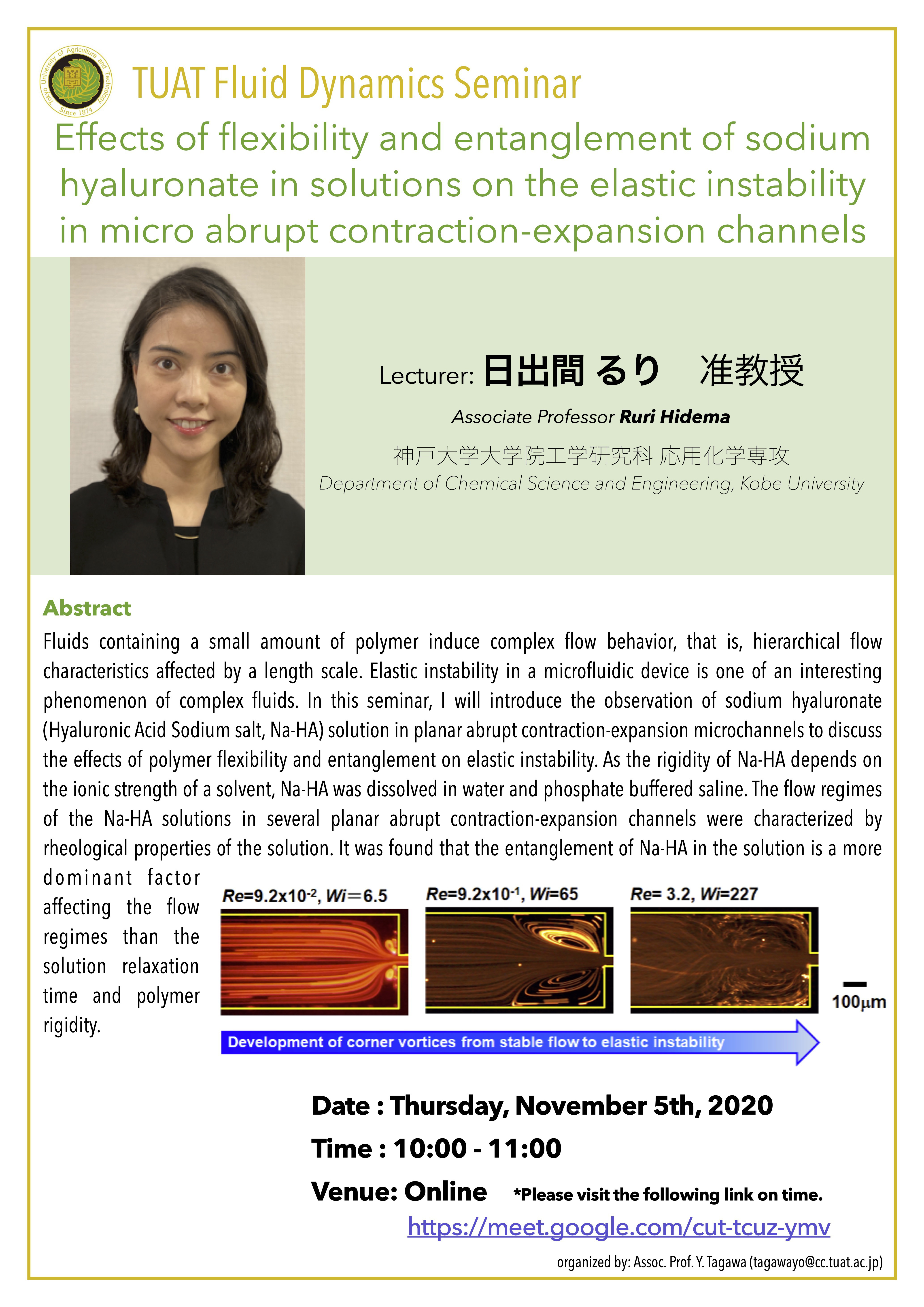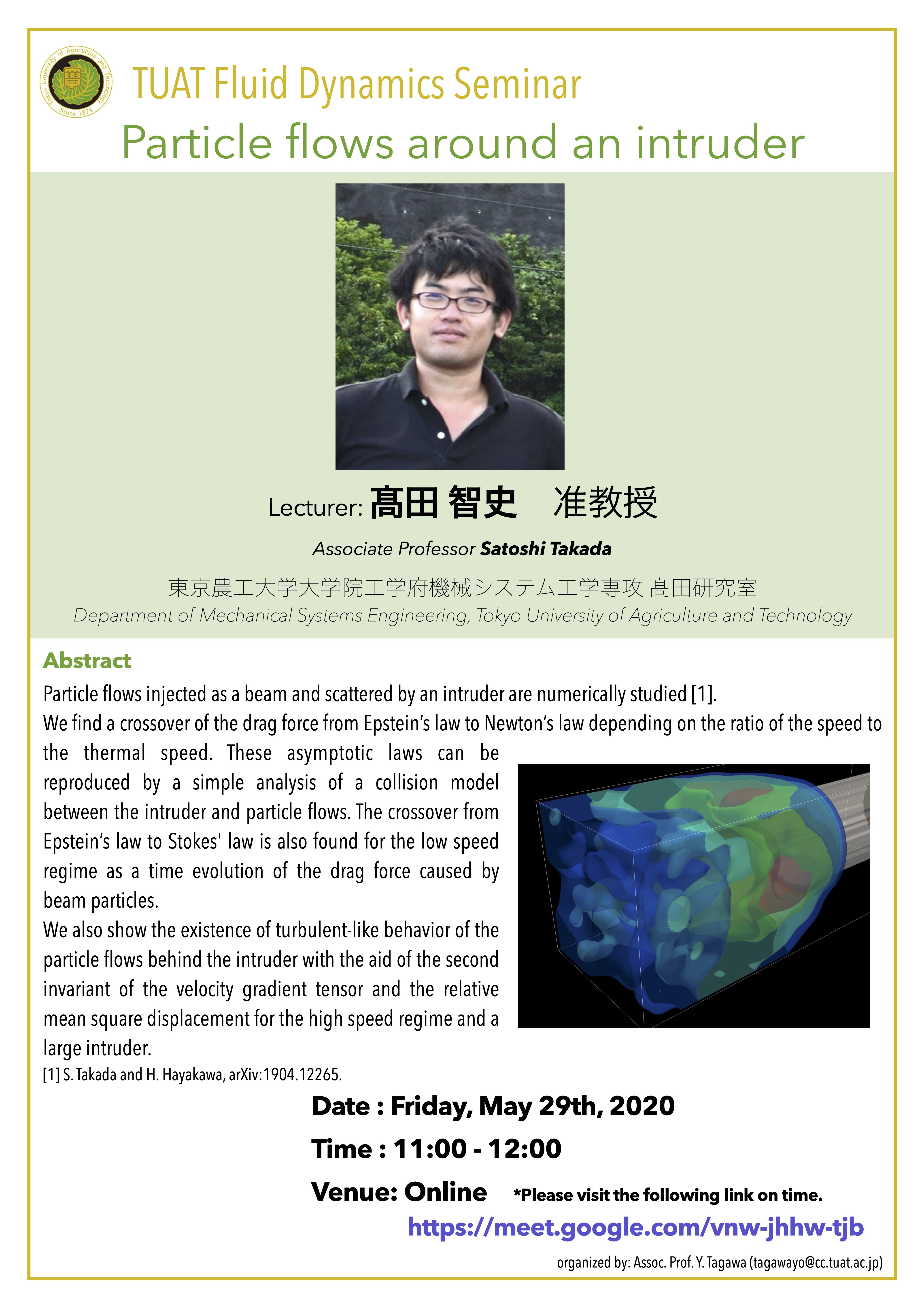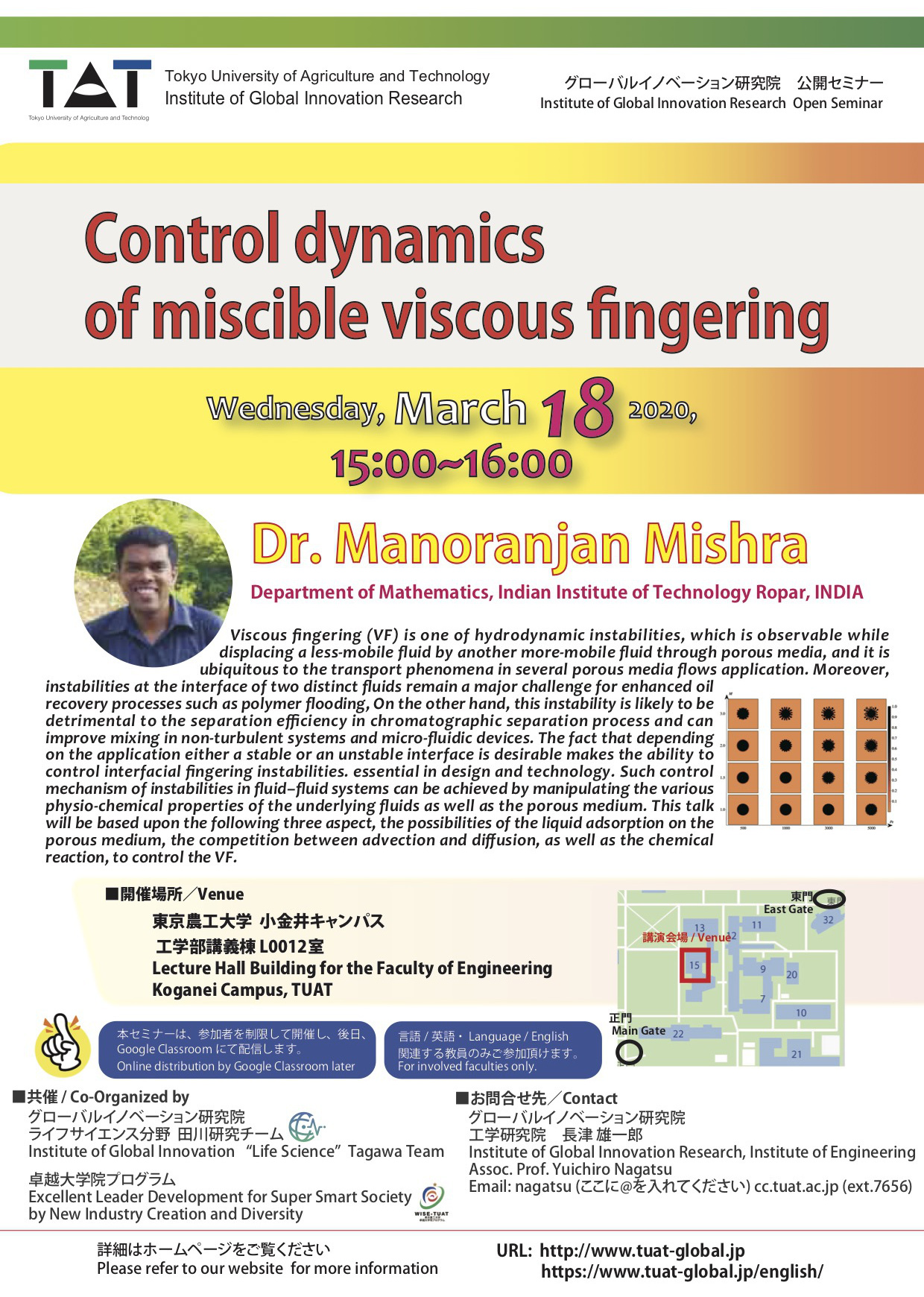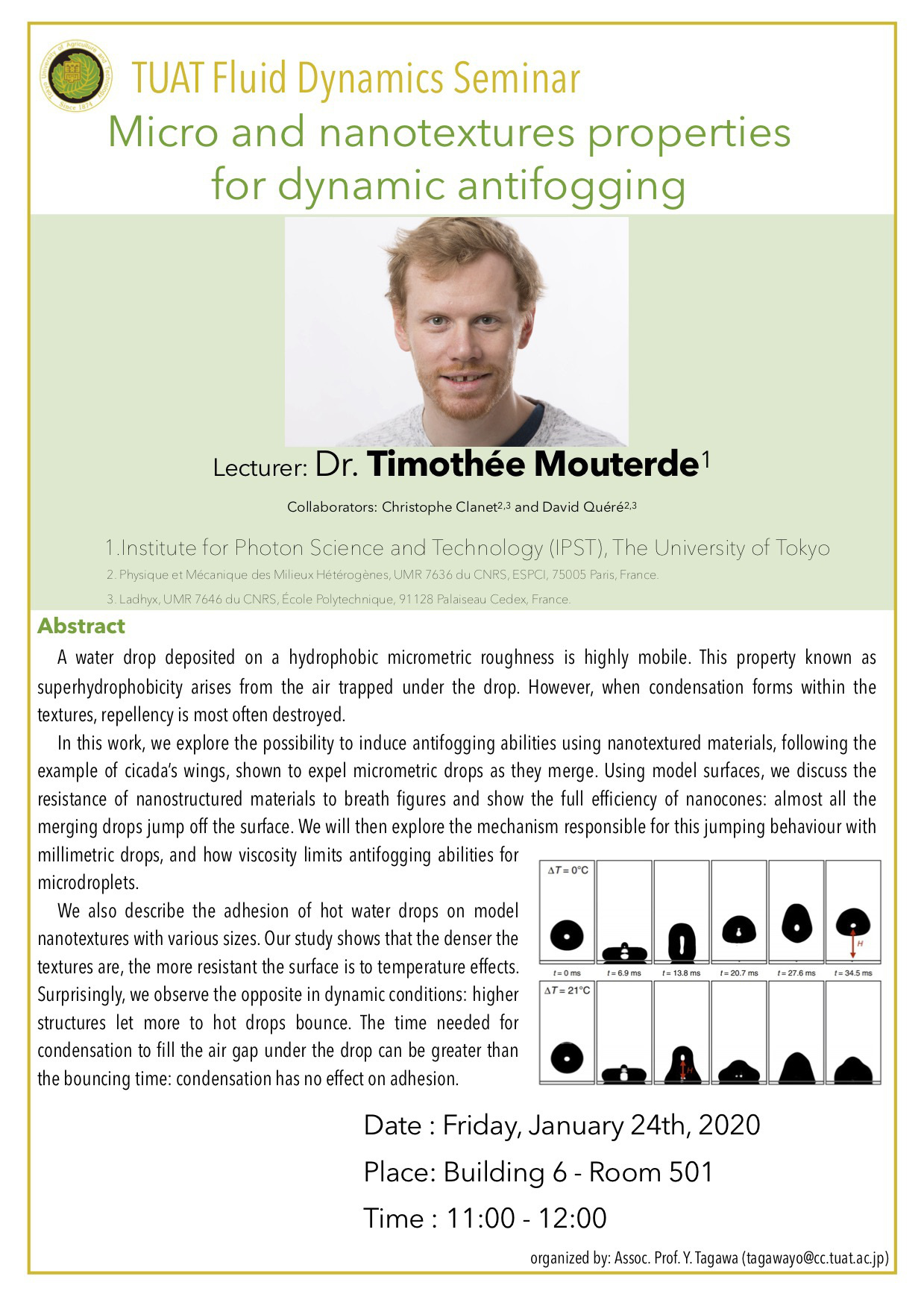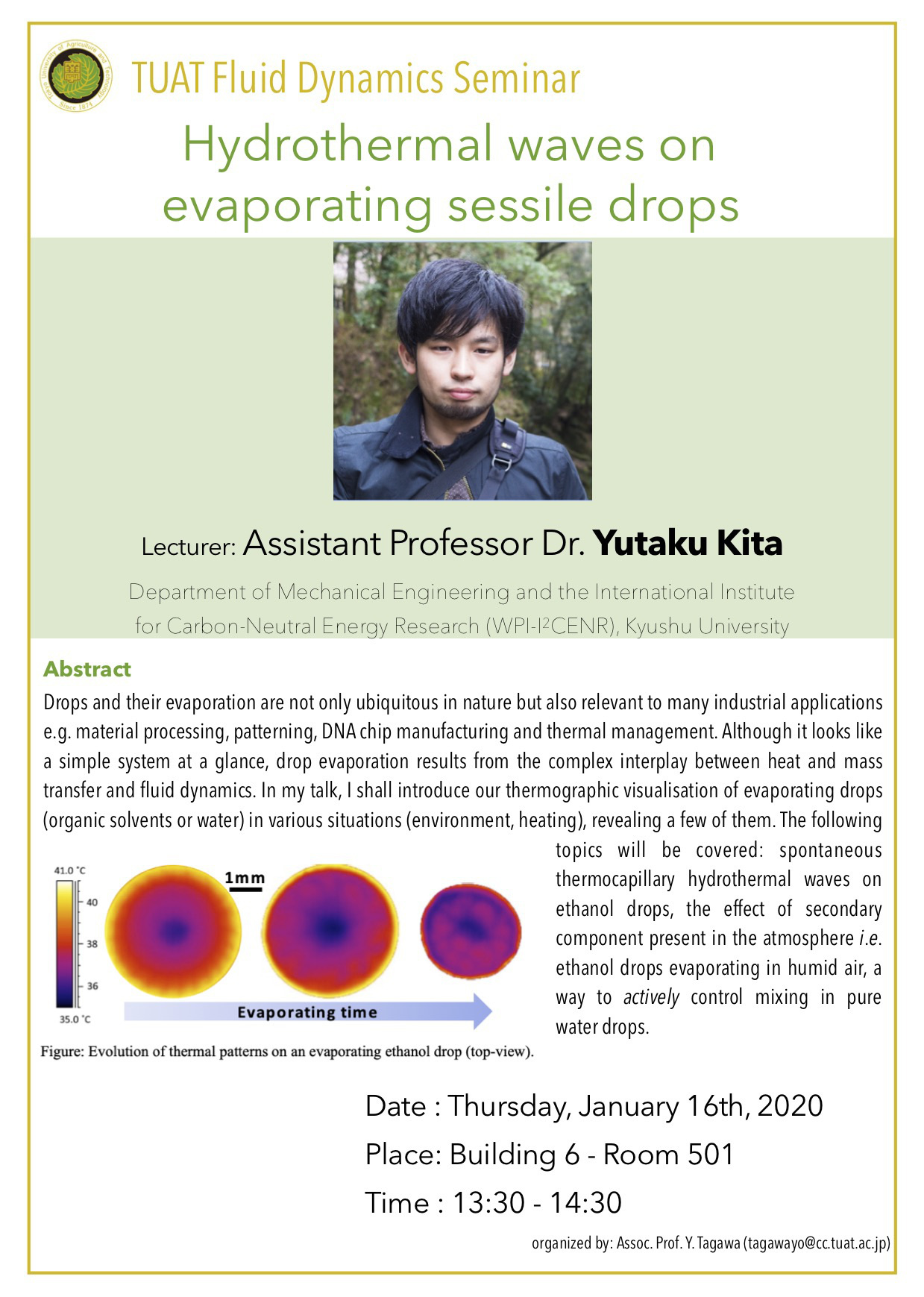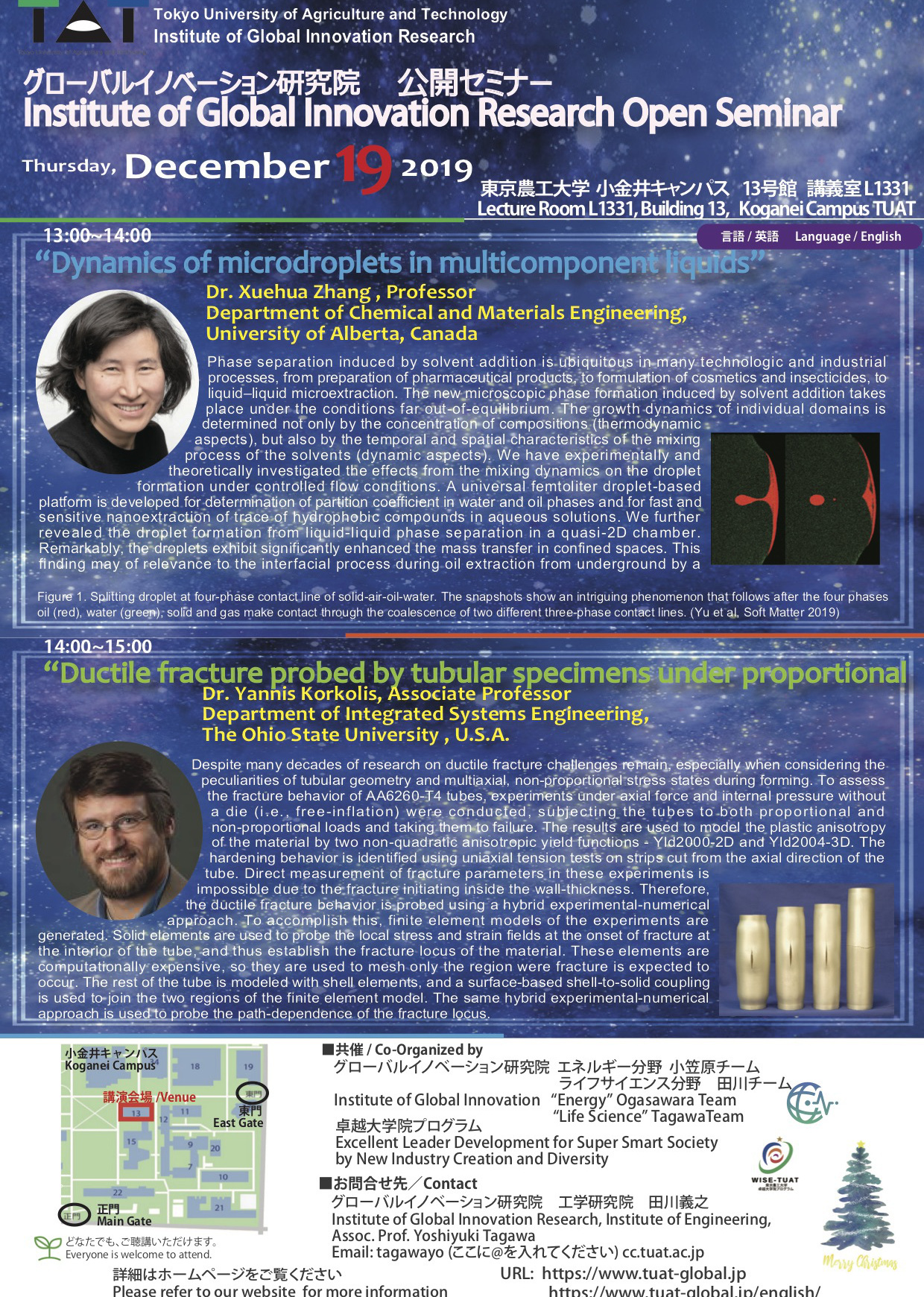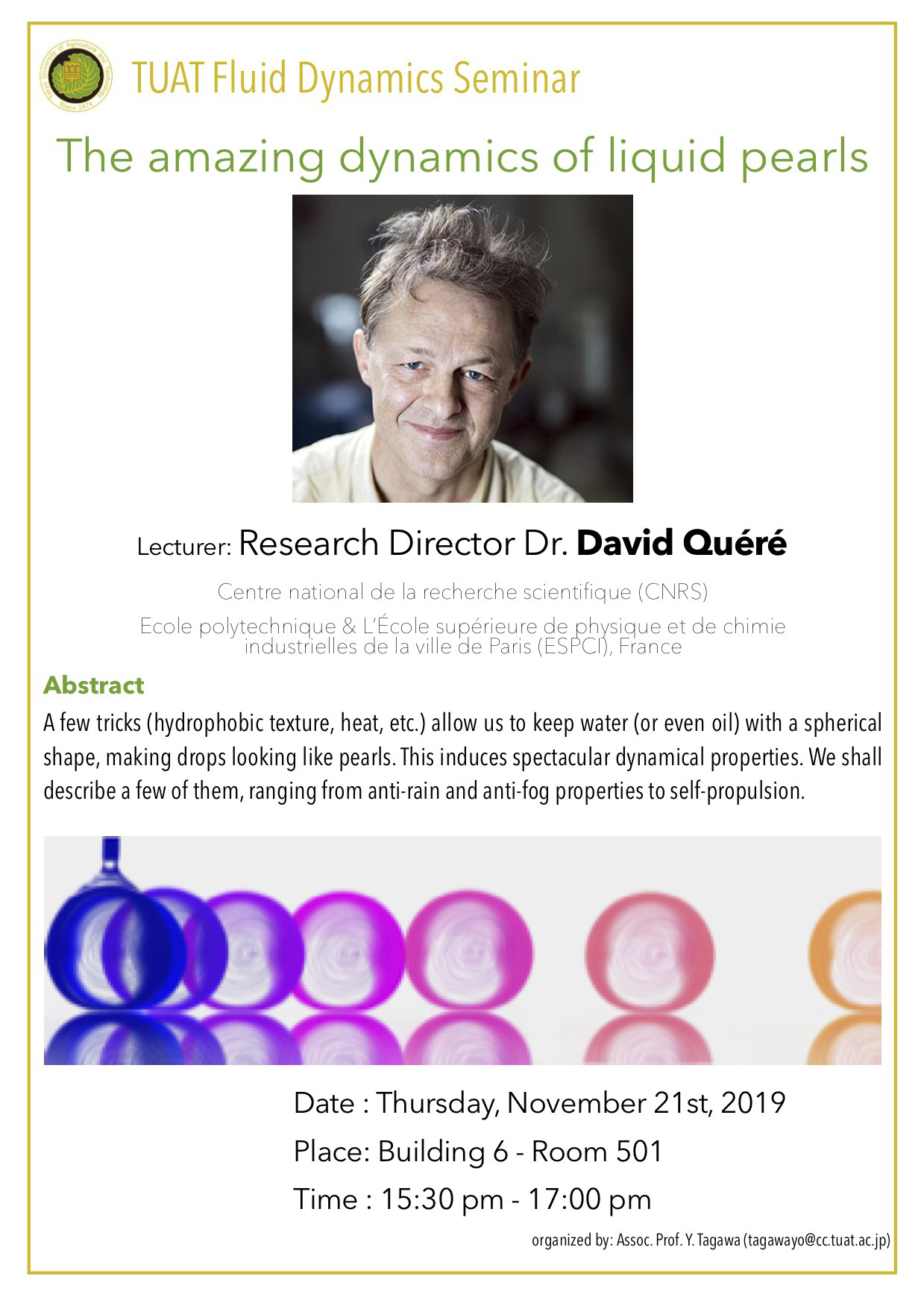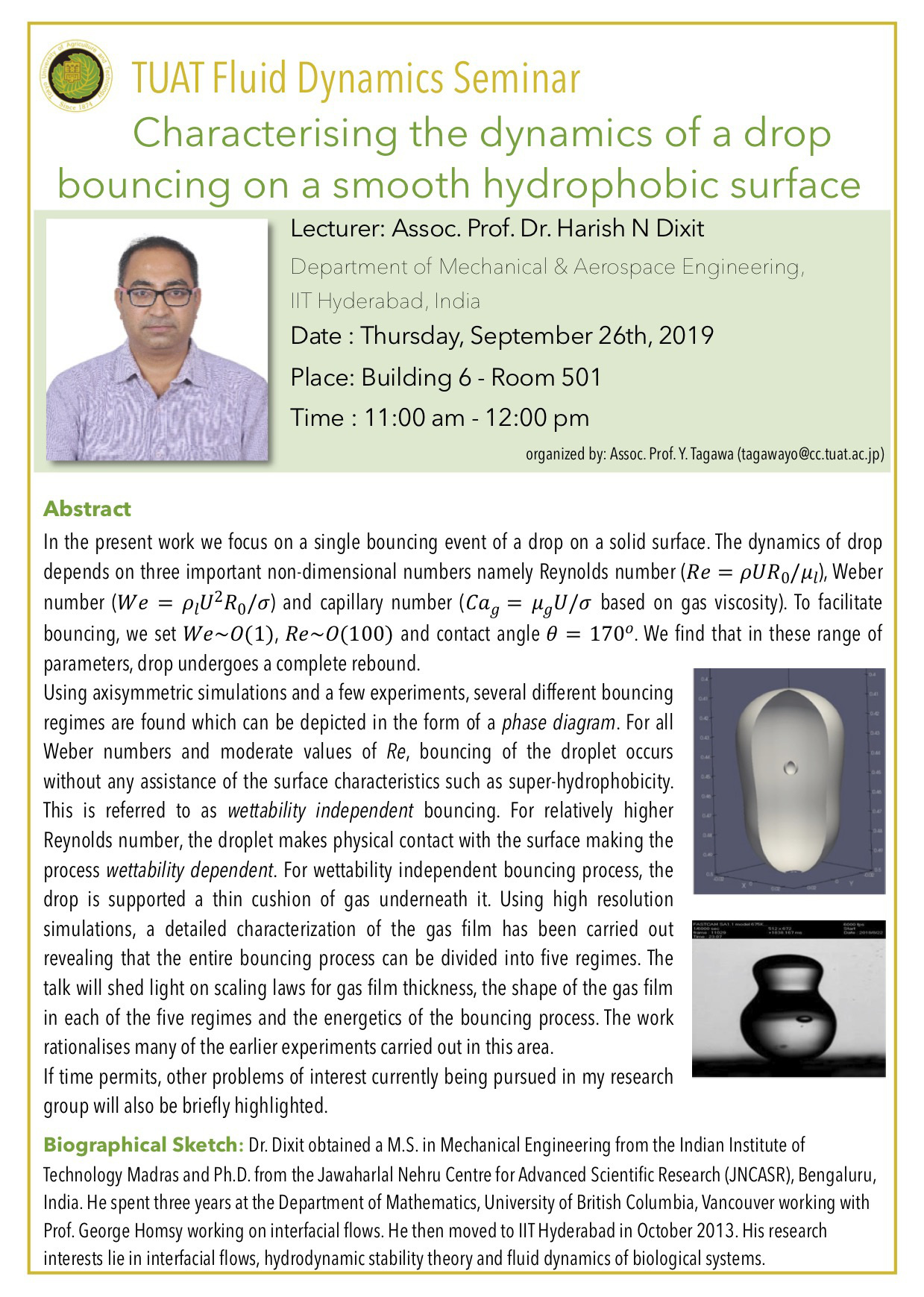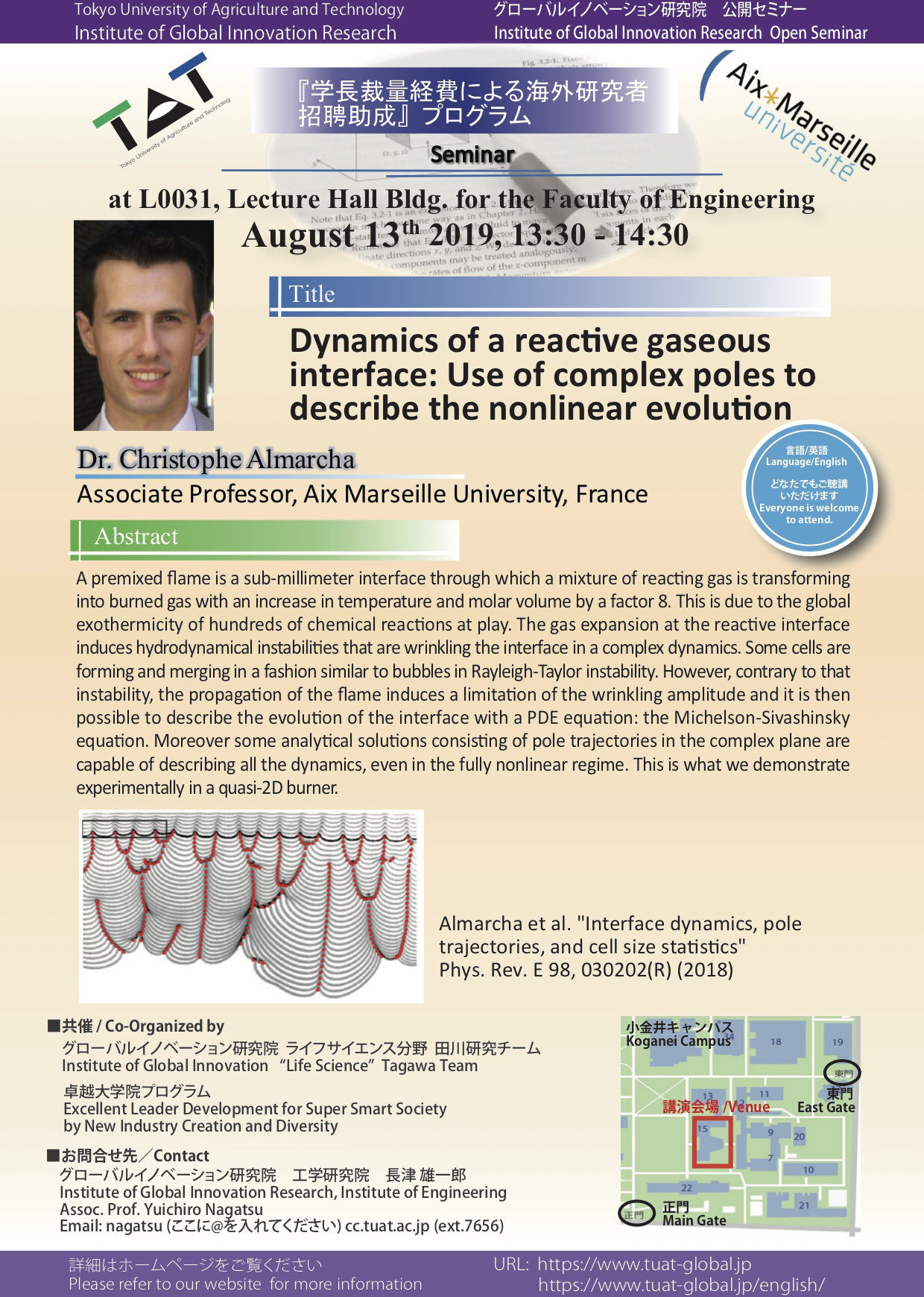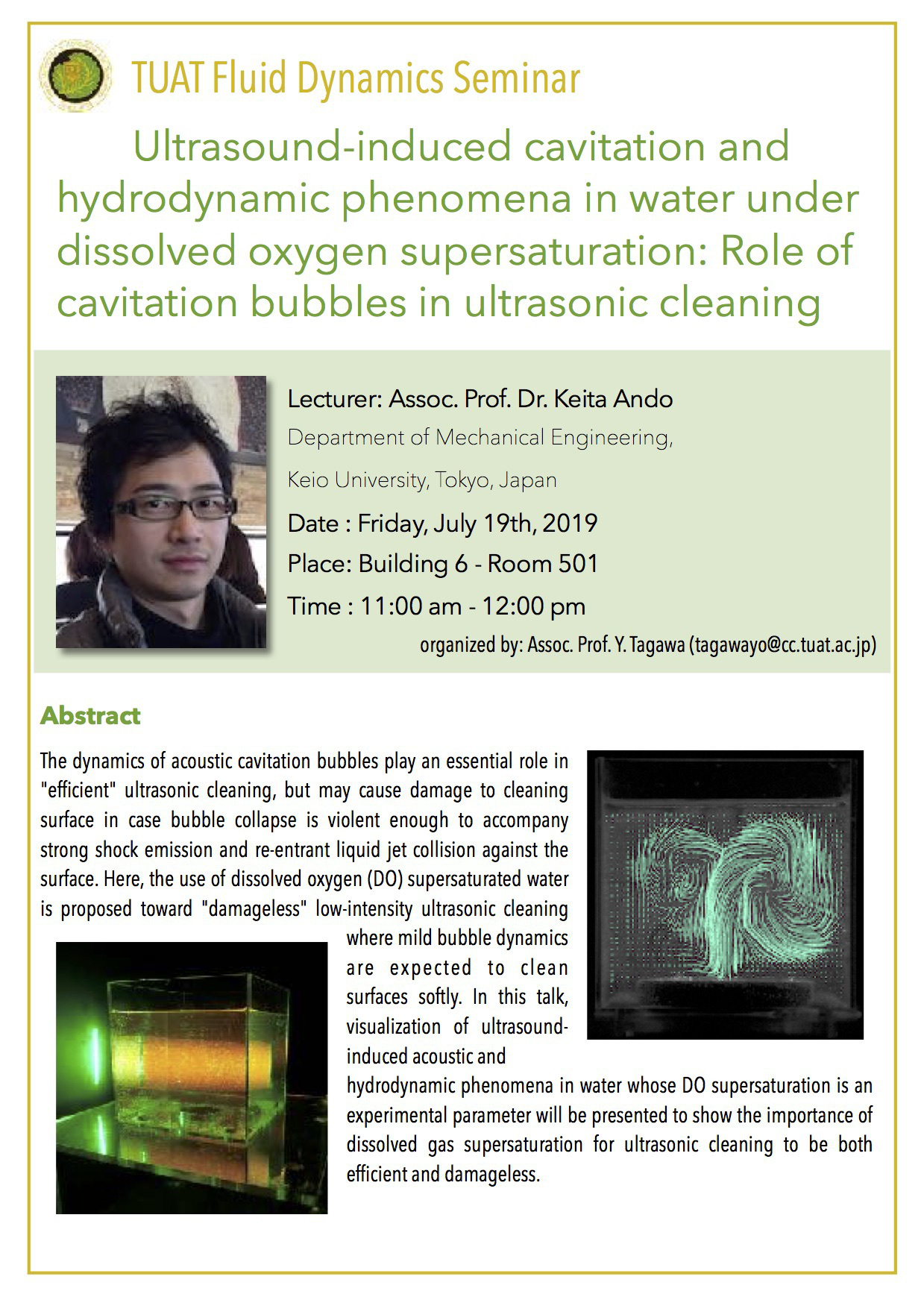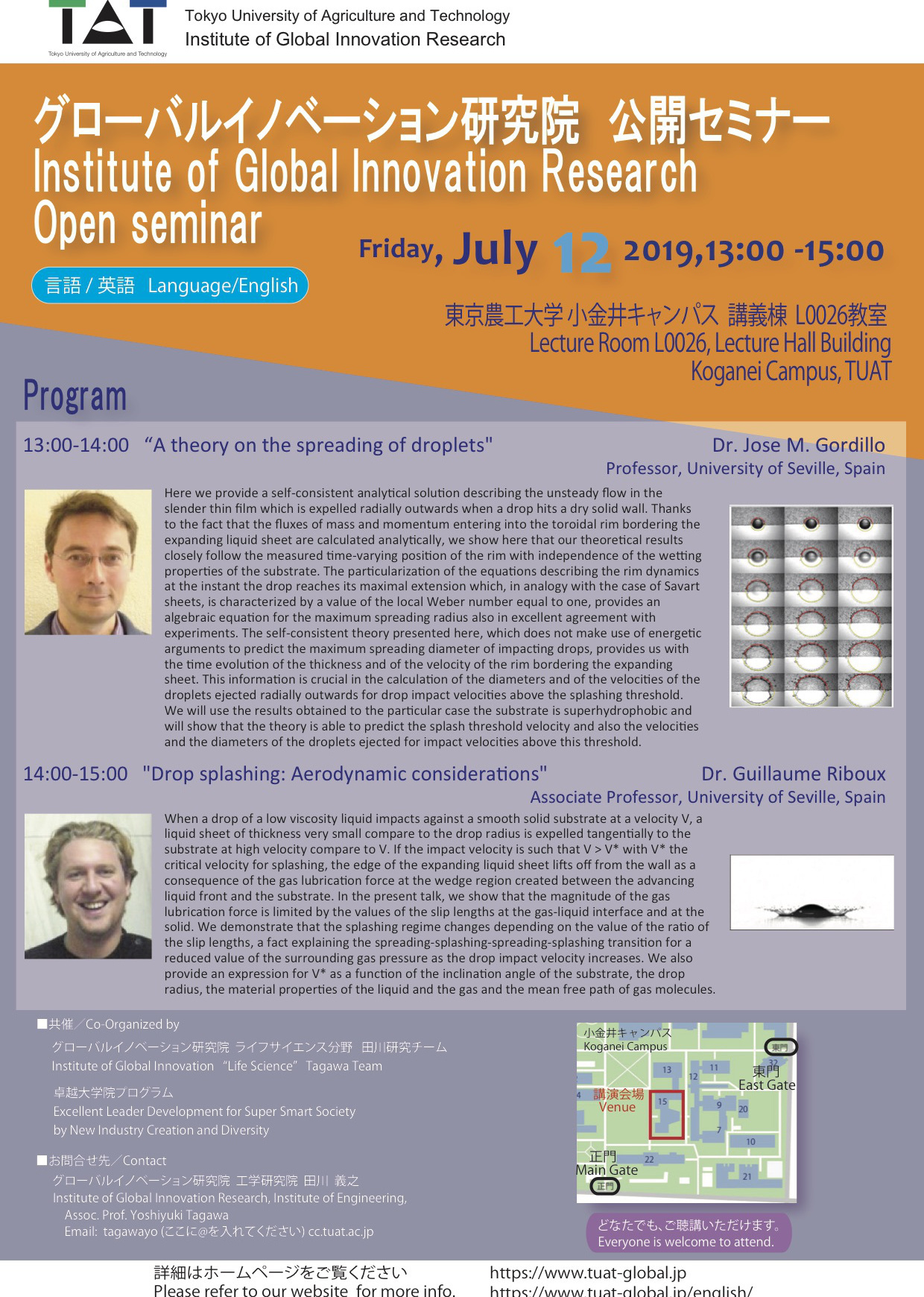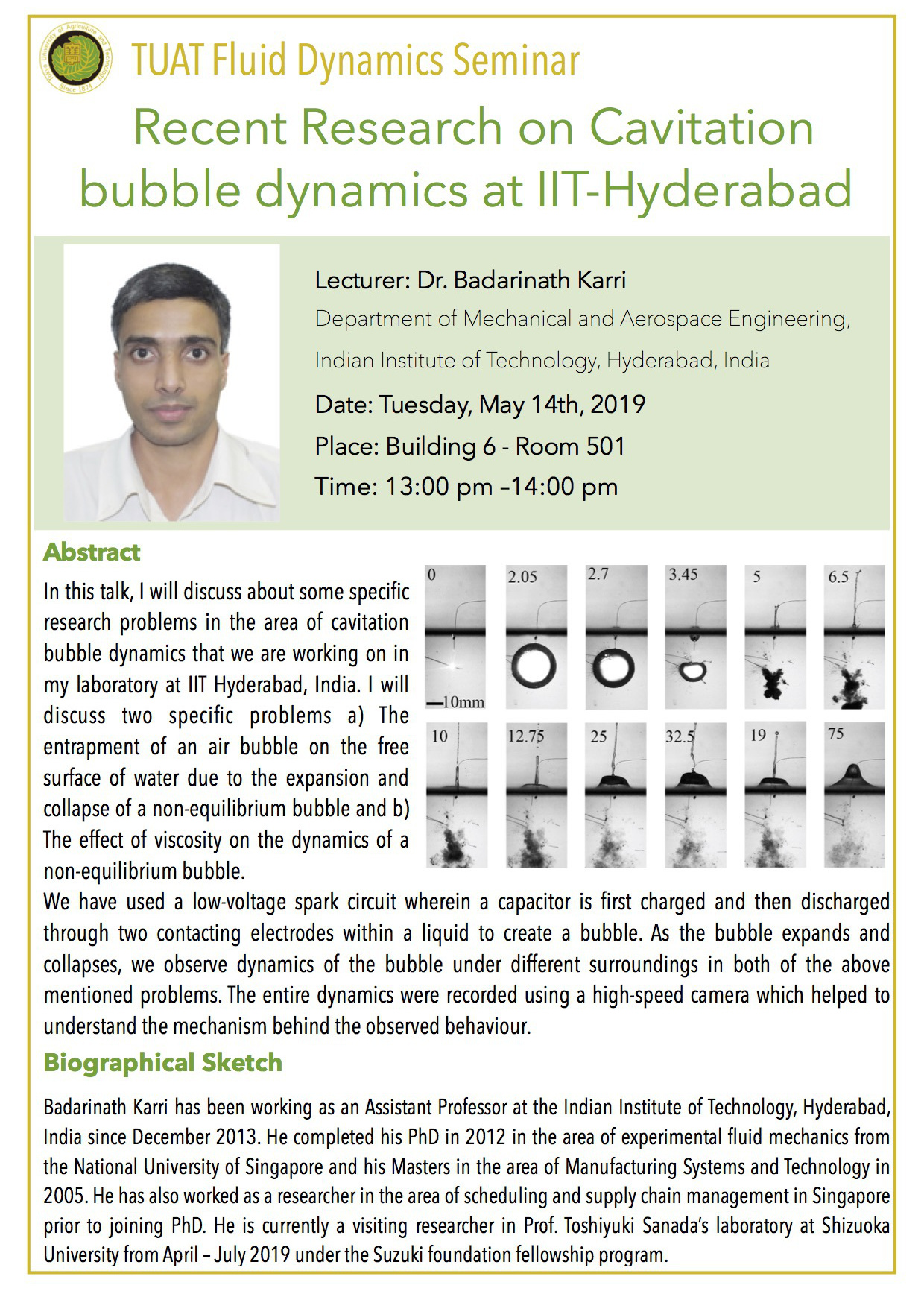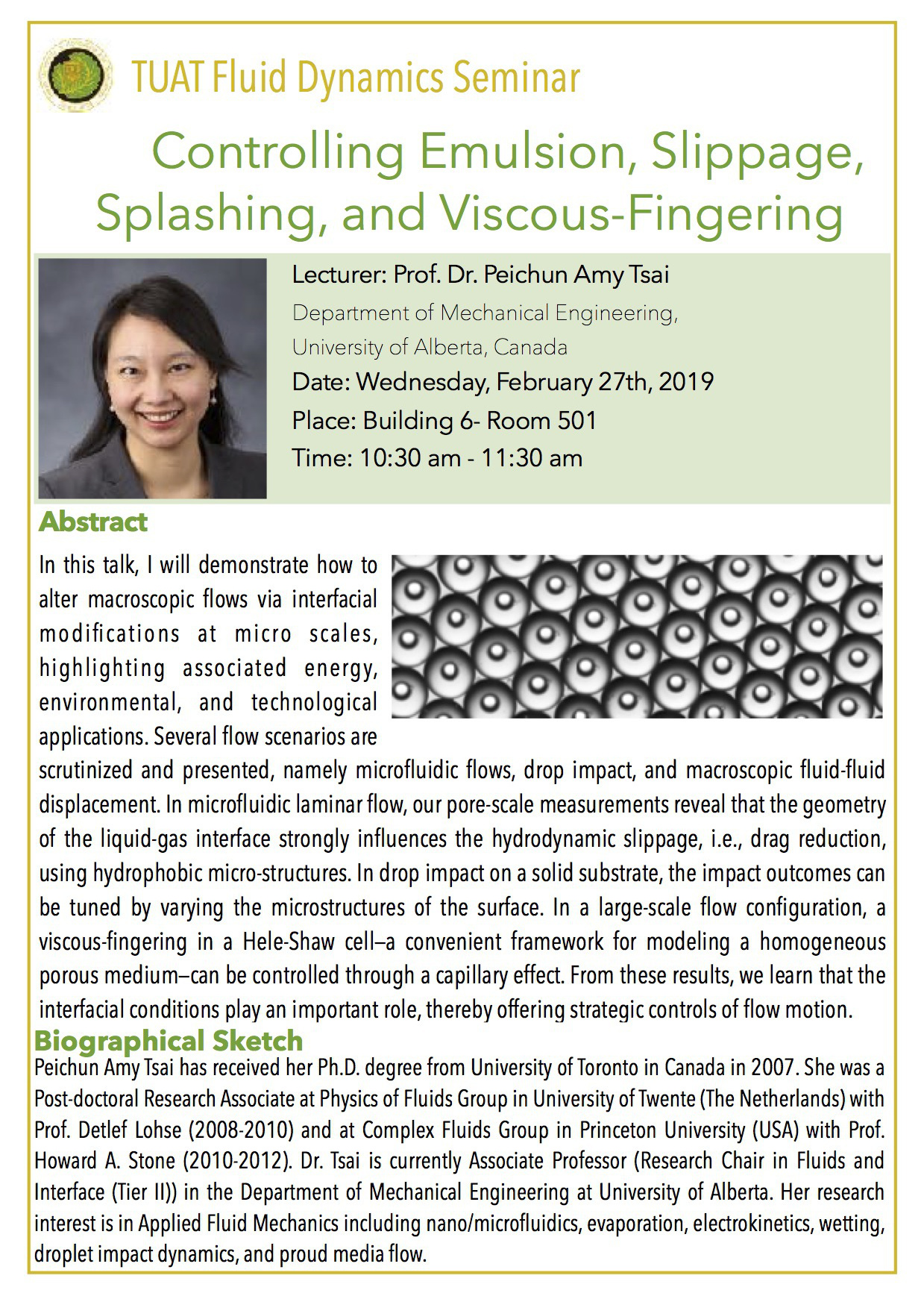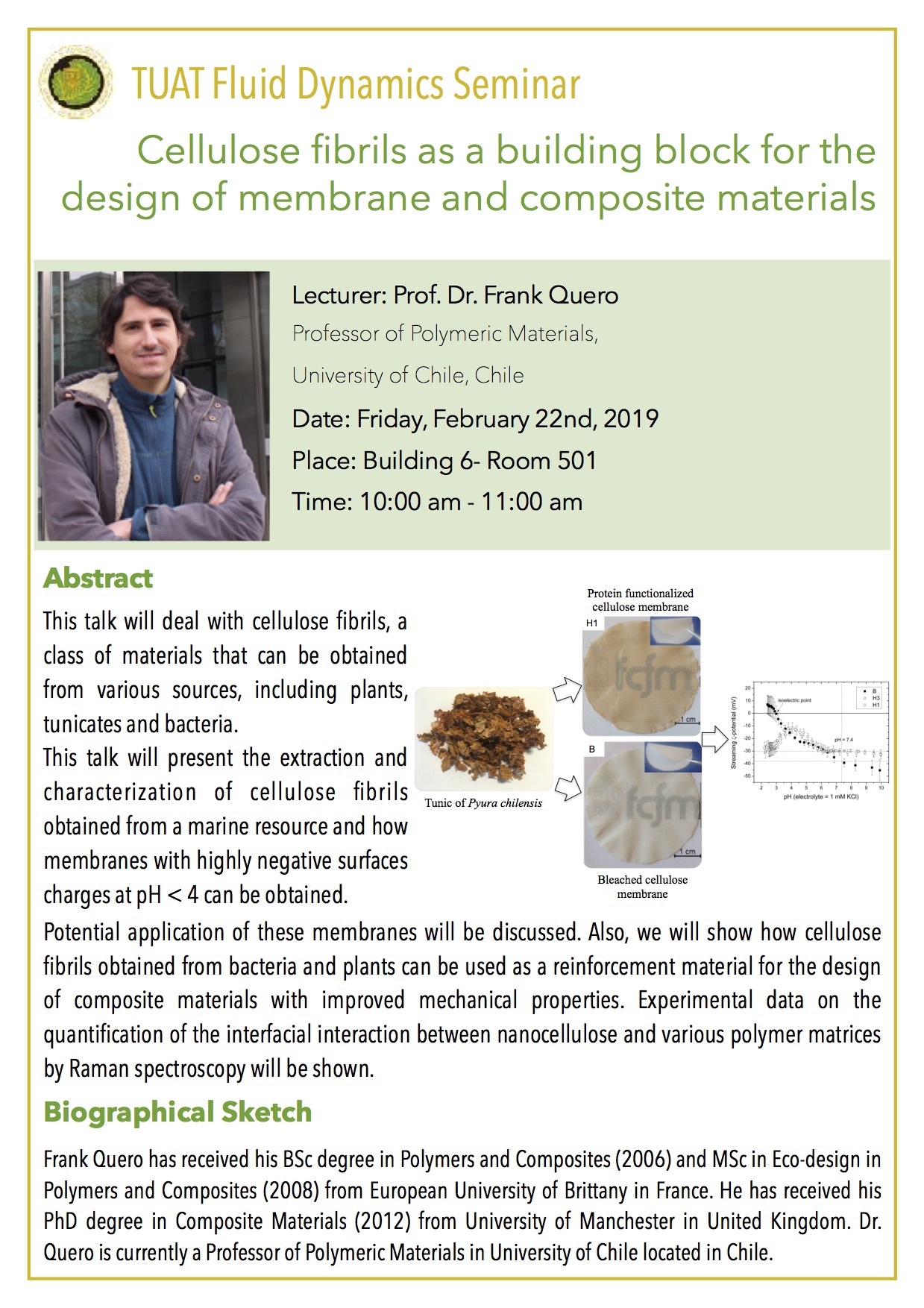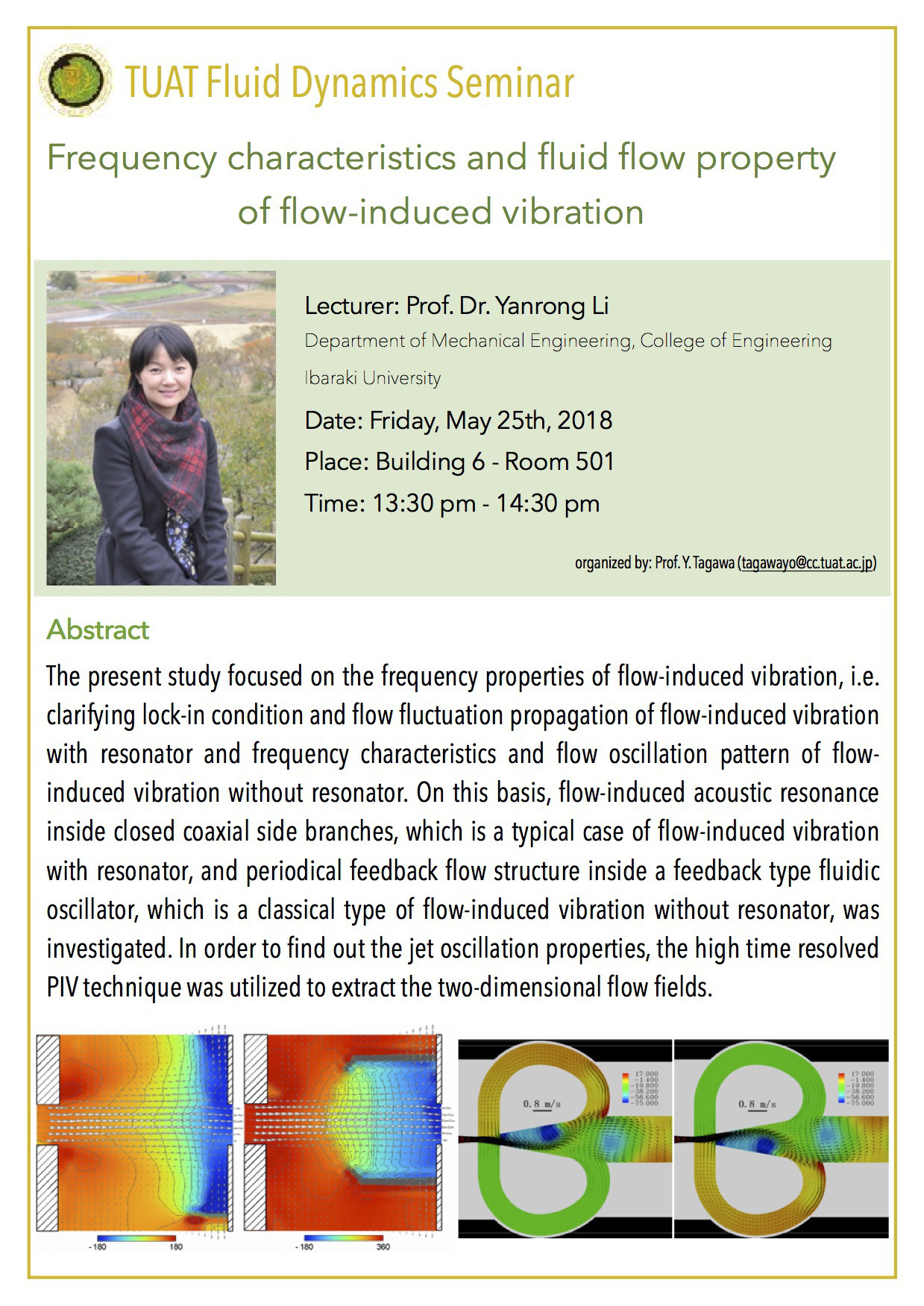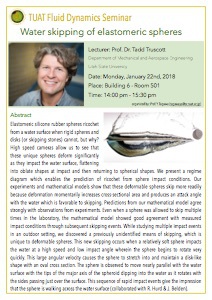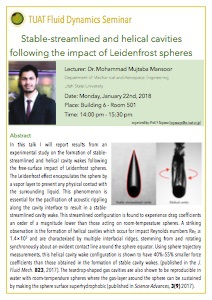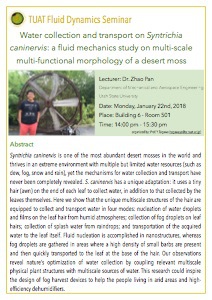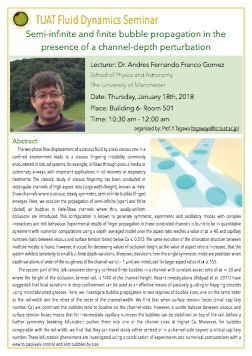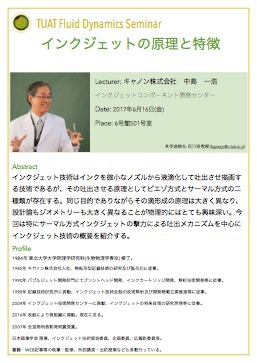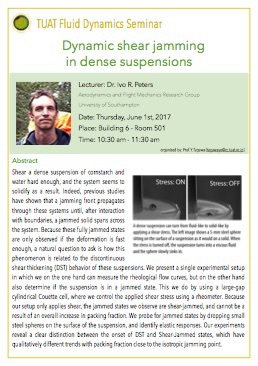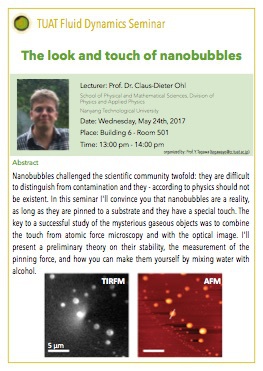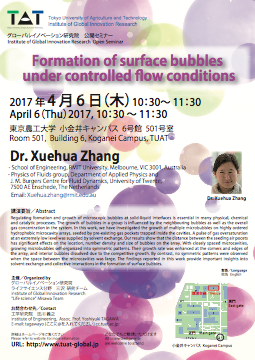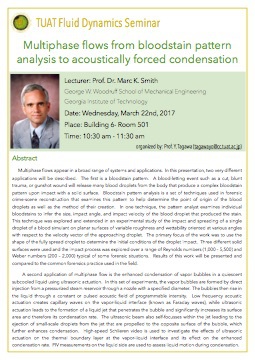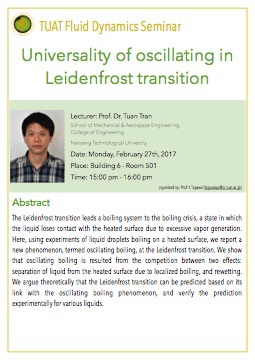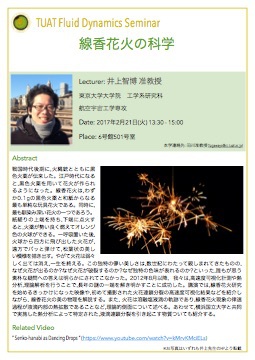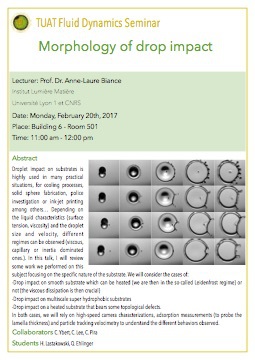2024
16:30-17:30, Thursday, April 4th, 2024
Building 4 - 3rd floor lounge
Dr. Dario Escala
Université libre de Bruxelles
On The Boundary Between Theory and Experiments: From chemicallydriven viscous fingering to reaction fronts in microgravity.
Science is always challenging, particularly when one must choose between following a purely theoretical or experimental path. But sometimes, being right in between can help us find better solutions to scientific problems. This presentation unfolds in two parts, each showcasing a unique problem at the interface of theory and experimentation. In the first part, we will examine a system where pattern formation is induced by complex chemical reactions [1, 2]. Here, we will study its behavior experimentally and use numerical simulations to understand the mechanism behind its dynamics. In the second part, we highlight the importance of prior experimental experience in shaping realistic mathematical models. Specifically, we investigate how the premixing of the chemical species influences the behavior of A + B → C reaction-diffusionadvection fronts under microgravity conditions. We illuminate how this experimental artifact impacts the characteristic properties of these fronts [3]. This talk extends beyond physical-chemical phenomena; it serves as guidance for those navigating their scientific paths, illustrating the richness of exploration at the confluence of theory and experimentation.
13:00-14:00, Wednesday, April 3rd, 2024
Building 6 - Room 201
山西陽子 教授
九州大学 大学院工学研究院 機械工学部門
分野横断研究のススメ
分野横断研究を始めるきっかけとなった研究者初期の頃を振り返り,熱流体工学を専門とした学部・ 大学院時代や,海外の大学でPh.Dを取得した後帰国し分野横断をしてマイクロロボットの研究室へポ スドクとしてリスタートしたことなどを通して,研究者にとっ て重要なことは何か?日本でのキャリア形成,異分野の研究者 同士のネットワークの大切さについてお話します.後半は電界 誘起気泡を用いたインジェクターの研究のお話と分野横断研究 への展開のお話をします.個人研究(さきがけ)からチーム型研 究(CREST,ムーンショット)へシフトしていく中での様々な価 値観の考え方,纏め方などのお話ができればと思います.最後 に機械と生物と情報などの分野を繋げていく試みのプロジェク トの紹介をいたします.
13:00-14:50, 15:00-18:00, Tuesday, April 2nd, 2024
Building 6 - Room 201
三浦 真 公認会計士
三浦真公認会計士事務所
理系学生向け、企業における経営戦略の必要性と実務での活用
●本セミナーの目的 ・実務における経営戦略の重要性を理解する ・日本マクドナルドホールディングスの開示情報を通じて経営戦略の具体例を 知る ・グループディスカッションを通じて店舗戦略を作成する過程を体感する ・理系学生の皆様がビジネスの世界で活躍するための基礎知識を習得する
●経営戦略の意義 ・経営戦略とは ・企業は利益を最大化する目標を持つ。経営者はどのような状況でも利益最大 化のため効率的、効果的に組織を動かす必要あり ・変化の時代(VUCAの時代)では、「正解」が変わるため、環境変化を捉え て柔軟に応じる経営戦略が必要になる
●戦略の全体像、優秀なビジネスパーソンになるために全体像を理解しよう ・戦略の全体像(上層部の意図の理解と実行が重要) ・経営戦略とその下位戦略の関連性 ・経営戦略、事業戦略、マーケティング戦略、店舗戦略、等
●経営戦略の立案プロセス ・ミッション、ビジョン、バリューの定義、長期的な方向性を定義 ・SWOT分析、クロスSWOT分析(積極戦略、改善戦略、差別化戦略、撤退 戦略) ・外部環境(PEST、3C、ファイブフォース、プロダクトライフサイクル) ・内部環境(コアコンピタンス、経営資源、7S、4P)
●経営戦略に基づく事業計画の作成 ・経営戦略を事業計画に落とし込む ・事業計画の作成方法の説明(売上高、コスト(変動費、固定費)、投資、等)
●経営戦略の実践 ・定期的に事業計画の数値と実際の数値を比較 ・予算実績差異分析⇒PDCAサイクルを回す⇒目標達成を目指す ・KGI(Key Goal Indicator)、KPI(Key Performance Indicator)、KDI (Key Doing Indicator)の利用法
●ケーススタディ:日本マクドナルドホールディングス ・有価証券報告書、決算報告資料等の活用 ・どのような公開情報があるか、公開情報をどのように読むか ・経営戦略と決算数値の関連性
●フランチャイズ店舗の戦略 ・具体的な店舗の店舗戦略を検討。同業他社、ライバル店舗と比較 ・日本マクドナルドホールディングス全体の経営戦略の中で店舗戦略を 構築
●グループディスカッションの実施 ・マクドナルドの店舗戦略を考えてみよう! ・クロスSWOT分析、ChatGPTの活用 ・どうしたら利益(=収益-費用)が増えるか
●グループディスカッションの結果発表 ・学生たちによる事業計画のプレゼンテーション ・店舗戦略の発表と評価、各グループへのコメントとアドバイス
● まとめ:理系学生の皆様への期待 ・経営戦略を数字に落とし込むことの重要性 ・事業計画は、必ず実績数値と比較してPDCAサイクルを回す ・PDCAサイクルを回すためにも、なぜこの計画か、数字で説明が必要 ・数字に強い理系学生の皆様への期待
15:00-16:00, Thursday, March 14th, 2024
Building 6 - Room 201
Dr. Ishan Sharma
Indian Institute of Technology
Solid surface energy in elasto-capillary systems
It is expected that in elastocapillary systems the deformation of soft materials and/or slender structures abutting the fluid interface will be nontrivially affected by the surface energies at the interfaces between the solid and fluid/air. This makes understanding the role of solid surface energies practically important. While authoritative thermodynamic treatments from the time of Gibbs make the case of solid surface energy clear, debate still persists about how to experimentally measure these surface energies at the solid's various interfaces, how to incorporate them in the mechanics of elastocapillary systems, and whether such interfacial energies will affect the solid structure’s deformation and/or stress field. A recent experiment [Kumar et al. 2020, Nature Materials, vol. 19, pp. 690-693] is cited to claim that solid surface energies cannot affect thickness-averaged stress within membranes and, consequently, the membrane's deformation as a solid body is independent of its surface energies. I will discuss a framework in which solid surface energies may be included in elastocapillary systems in a systematic way, show how the internal stress field in the solid is modified by solid surface energies, and thus arrive at a consistent interpretation of experiments, such as those of Kumar et al.
2023
13:30-14:30, Wednesday, December 6th, 2023
Building 6 - Room 201
Prof. Chao Sun
Tsinghua University (清華大学)
How the growth of lake and sea ice depends on the fluid dynamics underneath
Landscapes resulting from ice–water interactions coupled with solidification/melting are ubiquitous in nature. We study the coupling dynamics of the growth of lake and sea ice with the fluid motion underneath. In the first work, we investigate the solidification of freshwater, considering phase transition, water density anomaly, and the real physical properties of ice and water phases, which we show to be essential for correctly predicting various qualitative and quantitative behaviors. Despite the complex interaction between the ice front and fluid motions, remarkably, the average ice thickness and growth rate can be well captured with a theoretical model. In the second study, we experimentally investigate the complete freezing process of water with dissolved salt. We identify possible modes of heat transport and emphasize the role of the presence of brine convection through the mushy ice in influencing icing dynamics.

9:30-10:30, Wednesday, November 1st, 2023
Building 4 - 3rd Floor
Prof. Ranga Narayanan
University of Florida
Faraday Instability at Liquid-Fluid Interfaces- Physical Phenomena, Mechanical Modeling, Experimental Evaluation
Resonance driven instability or Faraday instability occurs when vertically stacked fluid bilayers are subject to periodic forcing in a direction that is normal to their common interface. The forcing can arise from several means, for example, by mechanical motion, by acoustic means, or even via electrostatic fields. The instability at the interface, which is manifested by ordered patterns, has its origins in the resonance between the imposed frequency and the system’s natural frequency. Our talk will focus on a comparison between theory and experiments showing remarkable agreement between the two.
We also show how and why electrostatic forced resonance is an excellent candidate to determine interfacial tension between fluids such as liquid semi-conductors and encapsulants.
15:00-16:00, Wednesday, October 18th, 2023
Building 6 - Room 201
Prof. Claus-Dieter Ohl
Otto von Guericke University, Magdeburg
Cavitation Bubble interaction with hard and soft matter: from erosion to nucleation
Non-spherical cavitation bubble dynamics in liquids are known to create enormous shear stresses which may be even enhanced when the bubbles are entrained in a low. Yet the mechanism by which cavitation creates erosion is through shock wave focusing and not related to the jet impact or a spherical energy focusing. It is actually the opposite; erosion results from the loss of axisymmety. Non-spherical cavitation in elastic solids generate shear waves that transport deformation energy to distances much larger than the local strain ield. We will show that two shear waves with different orientation are generated near a boundary and their individual amplitude is a function of the stand-off distance. These waves can be recorded with acoustic plane wave imaging at very high frame rates. I’ ll end the presentation with a mechanism through which cavitation is nucleated from shock-wave gas-bubble interaction in tissue.
13:30-14:30, Monday, October 2nd, 2023
Building 6 - Room 201
Dr. Hirokazu Maruoka
Kyoto University
Self-similarity and intermediate asymptonics on the dynamical impact on PDMS viscoelastic board
Self-similarity is a fundamental concept in physics. In this seminar, I introduce the concept of self-similarity and intermediate asymptotics that were formalized by Barenblatt and show how effective these concepts are to describe and understand the phenomena in soft matter physics in which their behviors and scaling laws vary depending on the scale of physical parameters. In this seminar, I will show the experiments of dynamical impact of solid spheres onto viscoelastic boards. Its scaling laws varied at different impact-velocity. I have succeeded in describing a self-similar solution which governs the scaling behaviors completely. The self-smilar solution has the dimensionless parameter derived from a solution in elastic regime and an inverse Deborah number. The solution shows that the behaviors are fully determined by the competition between elasticity, viscosity and inertia. It is a typical framework of crossover of scaling law.
16:00-17:00, Friday, September 29th, 2023
Building 6 - Room 201
Dr. rer. nat. Patricia Pfeiffer
Otto von Guericke University Magdeburg
Cavitation nucleation and instabilities in a thin liquid gap
Creating a cavitation bubble in a thin liquid gap allows us to study a rich variety of interesting phenomena, such as cavitation nucleation, bubble-bubble interaction and viscous fingering. A thin liquid layer is sandwiched between two glass slides. A cavitation bubble is nucleated by a focused pulsed laser in the thin liquid layer and observed using high-speed imaging. Besides the induced cavitation bubble, further bubbles appear, which are arranged typically in radial rings around the main bubble. These additional bubbles are referred to as secondary cavitation bubbles. To understand the secondary bubble nucleation and hence, the pressure modulation in the thin liquid layer, numerical finite-volume simulations are performed. The simulations reveal that the induced cavitation bubble launches a transverse wave that exhibits a strong tension followed by a high-pressure region. The tension on the liquid, created by the rarefaction wave, strongly depends on the thickness of the liquid layer. Thus, the rarefaction wave nucleates further cavitation bubbles along its path only if the liquid gap is thin enough. Secondary cavitation bubbles can be used to study cavitation nucleation on liquid impurities, such as oil, which have been brought into the liquid layer. Adjusting the tension wave in the gap carefully, bubble nucleation can be observed mainly at the impurities, as they decrease the cavitation threshold locally. Finally, we found an instability of the expanding cavitation bubble. The bubble interface shows short, stubby fingers. As the denser medium is replaced by a lighter one, i. e. water is replaced by a vapor phase, this instability is likely a Saffmann-Taylor instability occurring in an elastic-walled Hele-Shaw cell. Again, the pressure field in the liquid gap is analyzed with the help of numerical simulations. A linear stability analysis has been performed to proof the origin of the observed instability of the bubble interface.
9:30-10:30, Tuesday, September 12th, 2023
Building 6 - Room 201
Prof. Roberto Zenit
Brown University
Gas bubble dynamics: a personal journey
The study of the dynamics of gas bubbles in liquids is justiied by the numerous applications and natural phenomena where this two-phase low is encountered. Gas bubbles moveas forces are applied to them ; their dynamics are full of nuances that need to be addressed carefully. Since the mass of gas bubbles is practically negligible, in comparison withthat of the surrounding liquid, their reaction to forces can be drastic. Furthermore, since their surface can be deformed by the same forces acting on them, their shape may changeleading to changes in their resistance to move, the drag force, and therefore affecting their speed. The liquid rheology, as well as its surfactant content can also affect the bubbleshape and motion as well. Understanding these issues, in addition to the effect of interactions with other bubbles, walls and non-uniform lows, provides suficient elements tomodel and predict bubble behavior through the solution of dynamics equations. In this talk, I will discuss some of these issues which have kept me busy for the past 20 years, toend with suggestions for research directions for the subject in the future.
10:30-11:30, Thursday, September 7th, 2023
Building 6 - Room 201
Associate Prof. Christine M. Gilbert
Virginia Polytechnic Institute and State University
Hydroelasticity of High-Speed Planing Craft Subjected to Slamming Events by Vertical Water Entry Experiments
Small high-speed craft endure repeated slams into waves in the ocean. To better design these craft, it is important to understand this fluid-structure interaction when materials such as composites are used in their construction. In this talk, the slamming of composite high-speed craft is experimentally investigated by early free-falling water entry experiments. These are conducted on a wedge with flexible bottom panels. Kinematics, hydrodynamics, structural deformation, and spray-root propagation on the bottom of the wedge are measured and analyzed. It was found that for a composite panel, small outward (toward the water) deflections are observed at very early times in the impact event and decaying vibrations are observed after chinewetting. Soon, we will begin planning of non-traditional towing-tank tests that will be conducted at the VT Advanced Towing Tank Facility. These future VT experiments will use controlled motion experiments to replicate single slamming events of a planning hull boat on calm water. The motions will be controlled in surge, heave, and pitch and fixed in all other degrees of freedom.
13:30-14:30, Friday, July 28th, 2023
Building 6 - Room 201
藤川 重雄 名誉教授
私設 流体物理学研究所 (代表)
混沌にもがけ!
・自己紹介
・大学院時代の勉強と研究
・液体衝撃波管の開発とキャビテーション気泡力学
・気泡力学から気液界面の物理へ
・私の研究方法は大学院・学振研究員・助手の時代に形成された
・科学研究には虚空に飛び込む勇気が必要! (W. ハイゼンベルク)
・北大での私の研究:気液界面現象の階層構造
・私設 流体物理学研究所での研究と仲間たち
・皆さんへ:研究に苦しみ,研究を楽しめ!
15:30-16:30, Tuesday, July 25th, 2023
Building 6 - Room 201
Dr. Zibo Ren
Tsinghua University (清華大学)
Interactions of cavitation bubbles with surface-attached bubbles, particles, and droplets
Cavitation near boundaries can cause severe damage to surfaces due to the existence of cavitation nuclei and contaminations like particles. It can also be harnessed in surface cleaning, emulsification, and medical treatment. This talk focuses on cavitation bubbles near rigid boundaries, investigating cavitation inception from surface-attached micro- and nanobubbles, and interactions between cavitation bubbles and surface-attached rigid particles or oil droplets. (i) First, we design experiments on cavitation inception from surface micro- and nanobubbles due to strong shear flows and strong ultrasonic fields, respectively. In response to strong shear flows, surface micro- and nanobubbles deform, pinch off, and release free gaseous nuclei. At a driving frequency of about 100 kHz, surface micro- and nanobubbles are observed to merge with ultrasonic cavitation bubbles and then detach from the substrate, thus becoming free gaseous nuclei. In summary, we prove that surface micro- and nanobubbles can evolve into free gaseous nuclei, which provides new ways to remove the attached gaseous bubbles from surfaces. (ii) Second, we find by experiments that laser- induced cavitation bubbles can accelerate spherical metal particles from surfaces. By theoretical analysis, we reveal that the lift forces on the particles are originated from the decelerating expansion of the cavitation bubbles. Our findings provide an invasive way to manipulate particles immersed in water. (iii) Finally, we find by experiments that laser-induced cavitation bubbles can interact with surface-attached hemispherical oil droplets in four typical ways: oil droplet rupture, water droplet entrapment in oil droplet, oil droplet large deformation, and oil droplet mild deformation. We successfully predict in theory the direction of the migration of the collapsing cavitation bubbles, and establish the phase diagram for oil droplet responses.
14:45-15:45, Friday, July 21st, 2023
Building 6 - Room 201
木山 景仁 助教
埼玉大学理工学研究科
大学院生活を楽しみ、その後のキャリアを考えるために
私の大学院〜海外ポスドク生活は、素晴らしい環境でのびのびと研究生活を過ごさせていただいた一方で、進路や留学については、決断できずに悩むことばかりだったように思います。皆さんの普段の研究生活はいかがでしょうか。また、皆さんはそのような時どのように乗り越えているでしょうか。私は、予想外の出来事に対して右往左往する ことばかりで、攻略本が欲しいとさえ、常々思っています。そこで今回は、私自身がこれまでにそれぞれのタイミングで遭遇してきたイベントをご紹介します。(奏功したかはともかく)ひとつのアプローチ例をご提供しますので、皆さんにとって万一の備えとなればと思います。また、「もし今、そのような場面に遭遇したらどうするか」という観点からも考えます。これらを通して、失敗例も多いと思いますが、皆さんの参考になる情報がご提供できればと思いますので、楽な気持ちで聞いていただけたら幸いです。くわえて、大学院時代の学びを振り返り、いまの生活において役に立っていることや、 反対に、大学院時代にやっておけばよかった!と感じた(感じる)ことなど、私の率直な考えをお伝えできればと思います。
14:30-15:30, Monday, July 3rd, 2023
Building 6 - Room 501
Associate Prof. Tuan Tran
School of Mechanical & Aerospace Engineering, Nanyang Technological University
Stick-slip Dynamics for Unsteady Wetting on Soft Solids
In this talk, I will discuss studies for unsteady spreading of liquids on soft solids, a situation in which liquid spreading and solid deformation occur spontaneously at the three-phase contact line (CL). I show that stick-slip results from a competition between liquid spreading rate and solid viscoelastic reacting rate. I demonstrate that this CL behavior can be described and ontrolled by considering growing deformation of soft solids as dynamic surface heterogeneities. This may provide an understanding of unsteady wetting phenomena that have broad applicability in additive manufacturing, fabrication of flexible electronics, and biomedicine.
14:45-15:45, Friday, June 16th, 2023
Building 6 - Room 201
早坂 啓祐
株式会社デンソー
未来のキャリアを拓くための道しるべ: 田川研から自動車業界へ
みなさんは将来どんな仕事に就きたいでしょうか.アカデミック,一般企業,公務員などに決めている方もいれば,まだ迷っている方もいらっしゃいますよね.やっと進路を決めて入社をしたのもつかの間,今後のキャリアを問われるタイミングがみなさんにもやってきます.1つの組織で定年まで同じ仕事をする人は少数です.自動車業界は100年に1 度の変革期と言われています.ビジネスの急激な変化に伴い,求められる業務も変化していきます.これは他業界でもいつでも起こり得ます.少し不安になってしまったかもしれませんが,大丈夫です!本講演では,田川研で培った経験が会社でどのように活用できているかをご紹介し,「自分もやっていけそう!」とポジティブに思っていただけるような内容をお伝えします.まず,田川研での4年間の研究生活を経て学んできたことを整理します.つぎに,自動車業界で私が辿ってきたキャリアのターニングポイントを振り返り,自分が大切にしてきた思いをご紹介します.ひとつの田川研OBのケースとして,自分の将来を想像しながら気楽にお聞きいただければと思います.
14:45-15:30, Tuesday, May 23rd, 2023
Building 6 - Room 201
Dr. Prasad Sonar
Post-doctoral researcher of Osaka University
Turbulent air-jet impact on granular surfaces
Crater formation due to an impact is an extremely complex phenomenon. Jet-impact crater formation further involves the interaction between continuously impinging pressurized fluid and granular surface, which results in erosion of the surface, outward transportation of grains, and formation of bowl-shaped depression. The cratering process is dynamic, and the crater shape varies with the properties of eroding material and the impinging fluid. Landing rockets on planetary surfaces and erosion near hydraulic structures are some important examples relating to impact-induced cratering. Here, we consider the former application to focus on the cratering phenomenon that may cause problems during the landing and re-launching of rockets, like tilting of rockets, hardware damage to rocket bodies, etc. We investigate crater morphology and thrust forces in a rocket landing scenario, where a turbulent air-jet impinges on the granular surfaces. To reveal the fundamental aspect of this phenomenon, systematic experiments are performed with various air velocities, nozzle positions, grain sizes, shapes, and densities. We characterize the crater morphology using an aspect ratio, Rc = Dc/Hc, where Dc and Hc are crater diameter and depth, respectively. As a result, we find Rc is governed by the product of Mn = vn/C and Gn = dn/hn, where vn, C, dn, hn are air velocity at the nozzle, speed of sound in the air, nozzle diameter, and nozzle distance from the surface, respectively. We find that the non-dimensional thrust force is solely governed by Mn. These results suggest that the turbulent nature of air-jet mainly controls both the crater shape and thrust force. Moreover, we report a novel drop-shaped sub-surface cratering phenomenon.
14:45-15:45, Friday, May 19th, 2023
Building 6 - Room 201
山元 翔太
株式会社ジンズホールディングス
田川研究室での学びが生み出すキャリア: 博士号取得後の変化
田川研究室で過ごした博士前期課程の2年間と博士後期課程の1年間 (社会人ドクター)の経験が、私のキャリアにどのような影響を与えたのかについてお話します。また、社会人の立場から感じた「アカデミア と民間企業とのギャップ」や、「博士号がキャリア選択に及ぼした効 果」についても詳しく触れていきます。田川研究室での経験を糧に、私 自身が社会に出てどのように変化し、成長していったのかを振り返り、 皆さんにも参考になるようなお話をお届けできればと思います。
14:30-15:30, Friday, Apr 28th, 2023
Building 6 - Room 201
森川 慶 講師
聖マリアンナ医科大学 呼吸器内科
細胞検体を利用した肺癌診療の最前線
近年の腫瘍免疫学の進歩に伴い、原発性肺癌の治療に際しては、診断時の遺伝子変異の検索が必須となり、遺伝子変異陽性肺癌に対しては分子標的薬の使用が標準治療に位置付けられ、患者予後は劇的に改善した。診断時の遺伝子一括検査はNGSおよびPCR法でのパネル検査が主流であるが、原則的に十分量の組織検体が必要であることが課題であった。2020年から取り組んだ細胞診検体活用の研究において、我々は細胞診検体でも十分の核酸収量を得られることだけでなく、組織検体との比較で核酸クオリティも高いことを示し、肺がんコンパクトパネルは、第3の肺癌CDxとして2022年10月に薬事承認され普及している。気管支鏡下に採取できる擦過検体や針洗浄液、胸水等の液性検体のみならず、気管支洗浄液や喀痰など、従来遺伝子パネル解析に使用すると想定されていない検体でも解析が成功しており、今後低侵襲かつ高精度な検査法がますます普及することが予想されている。
14:30-15:30, Friday, Apr 21st, 2023
Building 6 - Room 201
大貫 甫
株式会社リコー
高粘度インクジェット吐出技術
~博士後期課程の研究と現職の繋がり~
インクジェット技術は,低粘度ニュートン性インクを紙への印刷から,高粘度・非ニュートン性インクをさまざまなメディア(金属,樹脂,生体など)への印刷など幅広い分野で用いられる.講演者は博士後期課程で高粘度液体の吐出技術の開発およびメカニズムの解明を行っており,現在は株式会社リコーで産業用インクジェットの設計・開発に従事している.本セミナーでは,博士後期課程での研究内容である高粘度液体の吐出技術の紹介と現職の繋がりについて説明する.
14:00-15:00, Friday, Mar 31st, 2023
Bluiding 6 - Room 201
Assistant Prof. Outi Supponen
ETH Zurich
Harnessing acousitically driven two-phase fluids
Bubbles oscillate volumetrically under the effect of pressure fluctuations, such as those produced by underwater sound waves. When driven into a violent collapse, they can yield strong sound emissions, high-speed jets, and extreme heating – a behaviour known as cavitation. Here, we will present ongoing research efforts to reach a fundamental understanding of the intriguing dynamics of acoustically driven bubbles across a wide range of scales from a single bubble level to that of bubble clouds. For this, we generally combine theory with ultra-high-speed experiments ranging from videomicroscopy and synchrotron X-ray imaging to laser-based measurement techniques. More specifically, we will report on our progress in temporally resolving acoustically driven microbubble oscillations and microdroplet vaporisation, elucidating the role of cavitation in ultrasound-mediated tissue adhesion and kidney stone destruction, and describing shock-driven bubble collapses. The broad aim of this research lies in the quest for harnessing the power of acoustically driven two-phase fluid media for a variety of engineering applications, including medical ultrasound diagnostics, drug delivery, lithotripsy, sonochemistry, surface cleaning and micro-fluidics.
10:00-11:00, Thursday, Mar 30th, 2023
Bluiding 6 - Room 201
Associate Prof. Sander Huisman
Physics of Fluids group, University of Twente
High humidity enhances the evaporation of non-aqueous volatile sprays
We experimentally investigate the evaporation of very volatile liquid droplets (Novec 7000 Engineered Fluid, chemical name hydrofluoroethers HFE-7000) in a turbulent spray. Droplets with diameters of the order of a few micrometres are produced by a spray nozzle and then injected into a purpose-built enclosed dodecahedral chamber filled with air containing various amounts of water vapour. The ambient temperature and relative humidity in the chamber are carefully controlled. We observe water condensation on the rapidly evaporating droplet, both for the spray and for a single acoustically levitated millimetric Novec 7000 droplet. We further examine the effect of humidity, and reveal that a more humid environment leads to faster evaporation of the volatile liquid, as well as more water condensation. This is explained by the much larger latent heat of water as compared with that of Novec 7000. We extend an analytical model based on Fick’s law to quantitatively account for the data.
14:30-15:30, Thursday, Mar 30th, 2023
Bluiding 6 - Room 201
Mr. Jelle Schoppink
PhD Canditate, University of Twente
Laser-induced cavitation for needle-free jet injection
Over the last 15 years, laser-actuated jet injectors have been investigated as an alternative to injection needles. These injectors use a laser to generate a bubble inside a microfluidic channel. This expanding bubble pushes out the remaining liquid, forming a fast microfluidic jet that is able to penetrate the outer layers of skin under certain conditions. To create this bubble, two different lasers can be used: a nanosecond-pulsed, or a low-power continuous- wave laser. Although both of these lasers have been thoroughly used, a direct comparison between these two has never been made. In this talk, I will present our recent work on a comparison of the bubble formation between a low-power continuous-wave and a pulsed laser. This comparison shows that both lasers create similar bubble growth and collapse dynamics, although the bubbles created by the pulsed laser require slightly less optical energy. Furthermore, I will present some of our recent work on selectively coated microchannels and their influence on the jet formation and stability.
13:00-14:00, Tuesday, Mar 7th, 2023
Bluiding 6 - Room 201
Prof. Elisabeth Guazzelli
Cetre National de la Recherche Scientifique
Rheoloy of dense granular suspensions: from Newtonian to Bagnoldian rheology
Dense granular suspensions that consist of concentrated mixtures of non Brownian particles suspended in a liquid are ubiquitous in many natural phenomenon (e.g. landslides, debris flows, and sediment transport) and industrial processes (e.g. concrete and pastes). Their rheology is not fully understood and establishing a unified theoretical framework across the different flowing regimes is still challenging. The present work describes precise rheological measurements of granular suspensions in the dense regime utilizing a unique custom-built rheometer able to perform pressure- and volume-imposed rheometry. It addresses the transition from a Newtonian rheology in the Stokes limit to a Bagnoldian rheology when inertia is increased and examines whether the inertial and viscous regimes can be unified as a function of a single dimensionless number based on stress additivity. This work has been done in collaboration with M. Ichihara, O. Pouliquen and F. Tapia.
10:00-17:00, Wednesday and Thursday, Mar 1st and 2nd, 2023
Bluiding 6 - Room 201
三浦 真 公認会計士
佐藤総合法律事務所
管理会計セミナー
>会計とは?
・会計の意味は,報告,説明すること
・財務会計と管理会計がある,外か内か
・会計では
・管理会計の切り口
>財務諸表分析
・収益性分析
・安全性分析
・キャッシュフロー分析
14:30-15:30, Wednesday, Feb 22nd, 2023
Bluiding 6 - Room 201
矢吹 智英 准教授
九州工業大学大学大学院工学研究院
高速度赤外線カメラで観察した沸騰熱伝熱メカニズム
沸騰熱伝熱は単相の対流熱伝熱やふく射伝熱などの他の伝熱形態と比較して高い熱伝熱率を有するため,電動車両用パワー半導体や高輝度光源など,さまざまな高発熱密度体への冷却への応用が考えられている.高い熱伝熱率をもつことは広く知られている事実であるが,その理由を明確に答えることは今でも難しい.我々のグループでは,MEMSセンサや高速度赤外線カメラ,感温塗料を用いた現象の直せいつ観察で熱伝達メカニズムを調べることを方針として研究を行ってきた.本講演では,高速度赤外線カメラを用いた沸騰伝熱面表面の温度・熱輸送分布の高時空間分解能計測を通じて調べた壁面熱伝達メカニズムについて説明する.
12:00-13:00, Monday, Feb 6th, 2023
Bluiding 6 - Room 201
Prof. Tadd Truscott
King Abfullah University of Science and Technology
Large droplet formation and deep-pool impact
Water droplet break-up has been studied extensively but typically focuses on droplets with radii near the capillary length (< 3 mm). Droplets larger than this typically break up when their velocity approaches terminal velocity, with larger droplets breaking up well before they reach terminal speeds. In general, studies involving large droplet break-ups are scarce and part of the reason is the difficulty of performing such experiments. We propose a method to suspend droplets of radii up to 60 mm using a series of release mechanisms and release speeds to illustrate the complexity and parameter space for practical solutions to these problems. The research details the effects of release acceleration, surface geometry, and surface features on the initial droplet perturbations. The shape of a droplet impact onto a liquid pool may greatly influence the dynamics of the cavity formation and splashing. Although droplet impact onto a liquid pool
has been investigated for relatively small droplets, behaviors greatly change when the droplet is large enough that significant oscillation deformation occurs. The shape and dynamics of the cavity formed by the large droplets are significantly affected by the deformation of the droplet at impact. In general, three different shapes of the impacting droplets occur prolate, oblate, and circular. We show that, for a fixed liquid volume and a fixed Weber number of an impacting droplet, prolate-shaped droplets produce the maximum cavity depth whereas an oblate-shaped droplet results in a minimum cavity depth.
2022
13:00-14:00, Friday, Dec 9th, 2022
6号館 201号室
伴 貴彦 講師
大阪大学大学院 基礎工学研究科
複合化した輸送現象における熱力学解析
二つ以上の非可逆過程が複合化した輸送現象は、時に創発的な時空間構造を示す。化学反応と拡散過程が干渉するBelousov–Zhabotinsky反応や熱と運動量輸送が干渉するRayleigh–Bénard対流や拡散と運動量輸送が干渉するMarangoni対流は、平衡から離れると空間的な対称性が崩れ、安定した創発的な時空間構造を形成する。この創発的な時空 間構造の特徴は、巨視的な駆動力に直交する方向に熱力学流束が創発し、その創発流束が存在する直交面内でエントロピーを生成しながら安定な構造を形成する点にある。時空間構造の発展や安定性は、非線形力学により詳細に議論できるが、異なる現象間の構造に質的な共通点がない限り、時空間構造を統一的に理解することはできない。本セミナーでは、様々な複合化した輸送現象における時空間構造を、熱力学流束を用いて平衡系の相のように規定し、エントロピー生成を用いて時空間構造の発展および安定性を解析する方法について、概説する。
11:00-12:00, Friday, Nov 4th, 2022
6号館 201号室
武石 直樹 助教
大阪大学大学院基礎工学研究科
生体内流動の階層性と物性を繋ぐ
力学の解明にむけた膜-流体連成解析
生命動態の基本は対流と拡散であり、環境刺激の下でこれらのダイナミクスが異なる階層で進行し、結果としてより高次の生体機能を創出する。流れ場中の構成要素の各階層における詳細なダイナミクスは、生体機能を成立させる力学場と生体システムの関係を理解する上で重要であるだけでなく、疾病機序の理解にも繋がると期待している。本セミナーでは、血液中の細胞流動を例に、膜-流体連成解析手法を用いた
赤血球濃厚懸濁液のレオロジー解析について述べる。また、異なる階層の流れ場を描像する数値的アプローチについても紹介したい。
11:30-12:30, Friday, Oct 28th, 2022
Building 6 - Room 201
Dr. Connor Piers Lane
Shear rate imaging usin a polarization camera and birefringent aqueous cellulose nanocrystal suspensions
A fluid that is composed of anisotropic particles may show birefringence when under the effect of shear. This phenomenon is known as shear induced birefringence and can be used to study and visualize fluid flows. The most common way to measure birefringence is to send polarized light through the birefringent material and to measure the change in polarization. In this seminar I would like to talk about four aspects of flow birefringence measurements. First, we are going to discuss factors influencing the measurement quality of a polarization camera. Second, a two-dimensional birefringence measurement technique that is based on a rotatable linear polarizer and a polarization camera is presented. Third, birefringence measurements of aqueous cellulose nanocrystal suspensions are discussed. Finally, I argue that the study of shear rates in a two-dimensional shearing flow by means of flow birefringence is feasible and therefore encourage the use of aqueous CNC suspensions for birefringent flow studies.
16:00-17:00, Friday, Oct 7th, 2022
6号館 201号室
公認会計士 三浦 真
佐藤総合法律事務所
理系経営者と仕事をしている
公認会計士からのメッセージ
〜理系学生への皆様への期待〜
理系経営者(理系従業員)の活躍について
①外部環境の変化、答えのない時代(取締役会に出るテーマ)
· コロナ禍、貧富の格差拡大、中間所得層の崩壊
· ウクライナ戦争、コスト高
· 少子高齢化、財政赤字、円安
②停滞業種と成長業種
· 旧態依然、大企業の特徴、前例踏襲、官僚主義
· 理系経営者(理系従業員)の活躍、テクノロジー、特許(T社、S社の事例)
③博士号の使い方
· 新しい知見、知的フロンティア開拓
· 経営学、管理会計を学ぶことの勧め
11:00-12:00, Thursday, Sep 8th, 2022
6号館 201号室
長谷川 浩司 准教授
工学院大学
Lab-in-a-drop approach: 音響場における浮遊液滴の非接触マニピュレーション
近年、超音波を用いた「非接触流体マニピュレーション」が分析化学、生物、医学・創薬分野等に積極導入され、社会実装を目指す研究が世界中で活性化している。その実現に向けて、音響場で浮遊する液滴が内在する界面ダイナミクスならびに連成する液滴内外部の流動現象および熱物質輸送現象の解明が求められている。現象解明には計測手法の開発および解析技術の確立が必要不可欠であるものの、その現象の複雑さ(非定常性、非線形性、非平衡性)から、浮遊液滴のダイナミクスに対する包括的理解は未だ途上にある。本セミナーでは、その実現の道標となる統合的な現象把握と物理解明への挑戦、音響場による非接触流体マニピュレーションを用いたLab-in-a-dropの概念実証過程および今後の展望を紹介する。
14:00-15:00, Monday, May 30th, 2022
6号館 201号室
堀江 正信
株式会社化学計算総合研究所
物理現象の対称性を反映させ,任意のメッシュを扱える機械学習モデルによる流動現象の学習について
流動現象の機械学習による予測は、理論・実用の双方の観点から重要な課題である。 また、数値シミュレーションでよく扱われるメッシュは Graph neural network (GNN) と呼ばれる機械学習モデルの枠組みで取り扱えることが知られている。しかし ながら、通常の GNN では解析領域の形状や物理状態の複雑さのため、汎用性が問題 となることが多い。そこで本研究では、合同変換群同変性と呼ばれる、物理現象に見 られる回転・平行移動・鏡映に対する対称性を反映させた性質を持つ GNN について 議論する。また、提案手法が流動現象の予測を安定的に行えることを示す。
9:30-10:30, Wednesday, March 30th, 2022
Online *Please visit the zoom on time.
Zoom
ID: 816 8128 2776
Passcode: 813405
Associate Professor, Dr. Jeremy Oliver Marston
Texas Tech University
Fluid dynamics of needle-free intradermal injection
Delivery of medicines and vaccines has been largely unchanged for the past 150 years, with hypodermic needles being the vector of choice. In contrast, there has been considerable innovation in drug development, with explosive growth in the field of injectables (i.e. liquid-based drugs delivered across the skin). In this talk, I will present my groups’recent work in this area, with the main focus on needle-free intradermal jet injection, where we use a combination of experimental (high-speed video) observations, theory and numerical simulations to elucidate fundamental fluid dynamics of the process. I will also briefly discuss my groups other efforts related to (i) laser-induced and spark-induced micro-jets, (ii) drop impact for ophthalmic drug delivery, and (iii) using tattoo devices for intradermal injection.
16:00-17:00, Uesday, March 29th, 2022
Online *Please visit the zoom on time.
Zoom
ID: 832 2896 7131
Passcode: 235107
Professor, Dr. Claus-Dieter Ohl
Otto-von-Guericke University
Experiments on Cavitation Nuclei and Nanobubbles suspensions
Pulsed lasers are extremely useful to generate and expand small bubbles in liquids and surfaces. In this seminar I will present two simple experimental systems to explore the nature of nanobubbles. The first utilizes a thin liquid gap sandwiched by two stiff transparent materials, i.e. glass. The laser pulse launches a surface wave in the gap that is able to induce tension of up to the homogenous nucleation threshold. We explore this system and provide a novel way to nucleate bubbles by supersaturating the liquid in the gap locally. In the second experimental system we create by some yet unknown mechanism with a pulsed laser submicron sized bubbles in bulk water. Utilizing a rarefaction wave some time after the pulsed laser demonstrates the successful generation of nanobubbles. Both systems are easy to setup in a lab that has a pulsed laser source. I invite you to join this quest in understanding nanobubbles and their nucleation.
9:30-10:30, Wednesday, March 23rd, 2022
Online *Please visit the zoom on time.
Zoom
ID: 815 9218 8092
Passcode: 964857
Professor, Dr. John W. Bush
Applied Mathmatics Depertment of MIT
Beyond Six Feet: Respiratory flows and airborne disease transmission
We first describe respiratory flows associated with breathing, coughing and sneezing, giving particular attention to both the liquid and gas phases. We demonstrate that the widely implemented 6-foot-rule safety guideline for COVID-19 was based on a physical picture in which the gas-phase was neglected. Consideration of the gas-phase flows makes clear that the range of droplet-borne pathogen may greatly exceed 6 feet, and introduces the possibility of long-range airborne transmission. Evidence is presented that airborne transmission was the dominant mode of transmission of COVID-19. We develop a guideline for mitigating airborne disease transmission that provides a limit for the time spent in indoor spaces with infected individuals. We further demonstrate that carbon- dioxide may serve as a proxy for concentration of airborne pathogen; thus, carbon-dioxide monitoring allows for a real-time assessment of the risk of COVID-19 in indoor settings.
2021
11:15-12:15, Friday, November 5th, 2021
Online *Please visit the following link on time.
https://meet.google.com/cut-tcuz-ymv
PhD Candidate, Pradipto
Yukawa Institute for Theoretical Physics, Kyoto University
Running on top of a liquid: The impact-induced hardening and the viscoelastic response of the impact process on dense suspensions
A suspension is a mixture of macroscopic and undissolved particles in a liquid. Such suspensions surround our daily life. One can observe the impact-induced hardening in dense suspensions, where the suspensions behave liquid-like at rest and abruptly turn solid-like under impact. This phenomenon enables people to run on top of the suspensions. In this talk, we will discuss the numerical approach to study the impact-induced hardening in dense suspensions with the lattice Boltzmann method that incorporates the contact between suspended particles and the free surface of the suspension. Then, we will discuss the rebound motion of a free falling spherical impactor on top of the suspensions, how the frictional interactions between suspended particles affect the rebound, and how the impact induced the emergence of a dynamically jammed region beneath the impactor [1]. We will also discuss the connection between the rebound motion, the impact speed, and the maximum force acting on the impactor. Finally, we will discuss our proposed phenomenology that can recover the viscoelastic response of the impactor during the impact [2].
[1] Pradipto and Hayakawa, Phys. Rev. Fluids 6, 033301 (2021).
[2] Pradipto and Hayakawa, Phys. Fluids 33, 093110 (2021).
11:00-12:00, Friday, January 29th, 2021
Online *Please visit the following link on time.
https://meet.google.com/cut-tcuz-ymv
Associate Professor, Kenta ISHIMOTO
Research Institute for Mathematical Sciences, Kyoto University
Flexibility breaks the symmetry of the microswimmer hydrodynamics
A microswimmer is a self-propelled particle in a fluid at low Reynolds number, ranging from swimming microorganisms to artificial active colloids and microbots. Due to the linearity of the Stokes equations for the flow around microswimmers, the dynamics are accordingly time-reversal as highlighted by the scallop theorem, which states that a microswimmer cannot generate net locomotion via a reciprocal motion. This symmetry, however, can be broken by soft dynamics such as fluid elasticity and swimmer elasticity. In this talk, after a brief introduction to the low-Reynolds-number hydrodynamics with moving boundaries, we will discuss locomotion in viscoelastic fluids and structure-coupled dynamics, showcasing our recent studies on swimming bacteria and sperm cells.
2020
10:00-11:00, Thursday, November 5th, 2020
Online *Please visit the following link on time.
https://meet.google.com/cut-tcuz-ymv
Associate Professor Ruri Hidema
Department of Chemical Science and Engineering, Kobe University
Effects of flexibility and entanglement of sodium hyaluronate in solutions on the elastic instability in micro abrupt contraction-expansion channels
Fluids containing a small amount of polymer induce complex flow behavior, that is, hierarchical flow characteristics affected by a length scale. Elastic instability in a microfluidic device is one of an interesting phenomenon of complex fluids. In this seminar, I will introduce the observation of sodium hyaluronate (Hyaluronic Acid Sodium salt, Na-HA) solution in planar abrupt contraction-expansion microchannels to discuss the effects of polymer flexibility and entanglement on elastic instability. As the rigidity of Na-HA depends on the ionic strength of a solvent, Na-HA was dissolved in water and phosphate buffered saline. The flow regimes of the Na-HA solutions in several planar abrupt contraction-expansion channels were characterized by rheological properties of the solution. It was found that the entanglement of Na-HA in the solution is a more dominant factor affecting the flow regimes than the solution relaxation time and polymer rigidity.
11:00-12:00, Friday, May 29th, 2020
Online *Please visit the following link on time.
https://meet.google.com/vnw-jhhw-tjb
Associate Professor Satoshi TAKADA
Department of Mechanical Systems Engineering, Tokyo University of Agriculture and Technology
Particle flows around an intruder
Particle flows injected as a beam and scattered by an intruder are numerically studied [1].
We find a crossover of the drag force from Epstein’s law to Newton’s law depending on the ratio of the speed to the thermal speed. These asymptotic laws can be reproduced by a simple analysis of a collision model between the intruder and particle flows. The crossover from Epstein’s law to Stokes' law is also found for the low speed regime as a time evolution of the drag force caused by beam particles.
We also show the existence of turbulent-like behavior of the particle flows behind the intruder with the aid of the second invariant of the velocity gradient tensor and the relative mean square displacement for the high speed regime and a large intruder.
[1] S. Takada and H. Hayakawa, arXiv:1904.12265.
15:00-16:00, Wednesday, March 18th, 2020
Building 15 - Lecture Room L0012,
Koganei Campus, TUAT:
Dr. Manoranjan Mishra
Department of Mathematics, Indian Institute of Technology Ropar, INDIA
Control dynamics of miscible viscous fingering
Viscous fingering (VF) is one of hydrodynamic instabilities, which is observable while displacing a less-mobile fluid by another more-mobile fluid through porous media, and it is ubiquitous to the transport phenomena in several porous media flows application. Moreover, instabilities at the interface of two distinct fluids remain a major challenge for enhanced oil recovery processes such as polymer flooding, On the other hand, this instability is likely to be detrimental to the separation efficiency in chromatographic separation process and can improve mixing in non-turbulent systems and micro-fluidic devices. The fact that depending on the application either a stable or an unstable interface is desirable makes the ability to control interfacial fingering instabilities. essential in design and technology. Such control mechanism of instabilities in fluid–fluid systems can be achieved by manipulating the various physio-chemical properties of the underlying fluids as well as the porous medium. This talk will be based upon the following three aspect, the possibilities of the liquid adsorption on the porous medium, the competition between advection and diffusion, as well as the chemical reaction, to control the VF.
13:00-14:00, January 30th, Thursday, 2020
Building 6 - Room 501,
Koganei Campus, TUAT:
三野 泰志 助教
岡山大学大学院自然科学研究科応用化学専攻 粒子・流体プロセス工学研究室
蒸発誘起型自己組織化を利用したコロイド粒子の規則配列 -界面動力学の理解に向けた実験と数値解析-
コロイド粒子の自己組織化現象は古くから,人々にとってscienceの対象であり,現在もなお数多くの科学者たちによって研究が進められている。その間にコロイド粒子の合成技術は飛躍的な進歩を遂げ,粒子径や形状,結晶構造の制御された様々な粒子が合成できるようになってきた。それに伴って,コロイド粒子をビルディングブロック(構成要素)として捉え,集積させることにより新たな機能性材料を創出しようとする試みが,光学・電子材料,コーティングなど様々な分野で盛んになされている。このような新規材料創製に対して,コロイド粒子の自己組織化を効果的に利用することはscienceの対象としてだけでなく,engineeringとしての重要性もますます高まっている。
本講演では,コロイド分散液の蒸発に誘起される粒子の自己組織化を利用して粒子を規則的に配列させる技術について紹介する。粒子配列過程のin-situ観察や規則構造発現メカニズム,応用展開に向けた周期構造の制御方法について述べる。また,コロイド分散系に関する現象をより詳細に解明するための新たなアプローチとして注目を集める数値シミュレーションについても紹介する。コロイド分散系を主な解析対象とする立場からこれまでに開発してきたシミュレーションモデルの特徴や解析事例,今後の展望について述べる。
11:00-12:00, January 24th, Friday, 2020
Building 6 - Room 501,
Koganei Campus, TUAT:
Dr. Timothée Mouterde
Institute for Photon Science and Technology (IPST), The University of Tokyo
Micro and nanotextures properties for dynamic antifogging
A water drop deposited on a hydrophobic micrometric roughness is highly mobile. This property known as superhydrophobicity arises from the air trapped under the drop. However, when condensation forms within the textures, repellency is most often destroyed.
In this work, we explore the possibility to induce antifogging abilities using nanotextured materials, following the example of cicada’s wings, shown to expel micrometric drops as they merge. Using model surfaces, we discuss the resistance of nanostructured materials to breath figures and show the full efficiency of nanocones: almost all the merging drops jump off the surface. We will then explore the mechanism responsible for this jumping behaviour with millimetric drops, and how viscosity limits antifogging abilities for microdroplets.
We also describe the adhesion of hot water drops on model nanotextures with various sizes. Our study shows that the denser the textures are, the more resistant the surface is to temperature effects. Surprisingly, we observe the opposite in dynamic conditions: higher structures let more to hot drops bounce. The time needed for condensation to fill the air gap under the drop can be greater than the bouncing time: condensation has no effect on adhesion.
13:30-14:30, January 16th, Thursday, 2020
Building 6 - Room 501,
Koganei Campus, TUAT:
Assistant Professor Dr. Yutaku Kita
Department of Mechanical Engineering and the International Institute for Carbon-Neutral Energy Research (WPI-I2CENR), Kyushu University
Hydrothermal waves on evaporating sessile drops
Drops and their evaporation are not only ubiquitous in nature but also relevant to many industrial applications e.g. material processing, patterning, DNA chip manufacturing and thermal management. Although it looks like a simple system at a glance, drop evaporation results from the complex interplay between heat and mass transfer and fluid dynamics. In my talk, I shall introduce our thermographic visualisation of evaporating drops (organic solvents or water) in various situations (environment, heating), revealing a few of them. The following topics will be covered: spontaneous thermocapillary hydrothermal waves on ethanol drops, the effect of secondary component present in the atmosphere i.e. ethanol drops evaporating in humid air, a way to actively control mixing in pure water drops.
2019
13:00-14:00, December 19th, Thursday, 2019
Building 13 - Lecture Room L1331,
Koganei Campus, TUAT:
Prof.Dr.Xuehua Zhang
Department of Chemical and Materials Engineering,
University of Alberta, Canada
Dynamics of microdroplets in multicomponent liquids
Phase separation induced by solvent addition is ubiquitous in many technologic and industrial processes, from preparation of pharmaceutical products, to formulation of cosmetics and insecticides, to liquid–liquid microextraction. The new microscopic phase formation induced by solvent addition takes place under the conditions far out-of-equilibrium. The growth dynamics of individual domains is determined not only by the concentration of compositions (thermodynamic aspects), but also by the temporal and spatial characteristics of the mixing process of the solvents (dynamic aspects). We have experimentally and theoretically investigated the effects from the mixing dynamics on the droplet formation under controlled flow conditions. A universal femtoliter droplet-based platform is developed for determination of partition coefficient in water and oil phases and for fast and sensitive nanoextraction of trace of hydrophobic compounds in aqueous solutions. We further revealed the droplet formation from liquid-liquid phase separation in a quasi-2D chamber. Remarkably, the droplets exhibit significantly enhanced the mass transfer in confined spaces. This finding may of relevance to the interfacial process during oil extraction from underground by a displacing fluid.
15:30-17:00, November 21st, Thursday, 2019
Building 6 - Room 501,
Koganei Campus, TUAT:
Research Director Dr. David Quéré
Centre national de la recherche scientifique (CNRS),
Ecole polytechnique & L’École supérieure de physique et de chimie industrielles de la ville de Paris (ESPCI), France
The amazing dynamics of liquid pearls
A few tricks (hydrophobic texture, heat, etc.) allow us to keep water (or even oil) with a spherical shape, making drops looking like pearls. This induces spectacular dynamical properties. We shall describe a few of them, ranging from anti-rain and anti-fog properties to self-propulsion.
11:00-12:00, September 26th Thursday, 2019
Building 6 - Room 501,
Koganei Campus, TUAT:
Assoc. Prof. Dr. Harish N Dixit
Department of Mechanical & Aerospace Engineering,
IIT Hyderabad, India
Characterising the dynamics of a drop bouncing on a smooth hydrophobic surface
In the present work we focus on a single bouncing event of a drop on a solid surface. The dynamics of drop depends on three important non-dimensional numbers namely Reynolds number (𝑅𝑒 = 𝜌𝑈𝑅0/𝜇𝑙), Weber number (𝑊𝑒 = 𝜌𝑙𝑈2𝑅0/𝜎) and capillary number (𝐶𝑎𝑔 = 𝜇𝑔𝑈/𝜎 based on gas viscosity). To facilitate bouncing, we set 𝑊𝑒~𝑂(1), 𝑅𝑒~𝑂(100) and contact angle 𝜃 = 170°. We find that in these range of parameters, drop undergoes a complete rebound.
Using axisymmetric simulations and a few experiments, several different bouncing regimes are found which can be depicted in the form of a phase diagram. For all Weber numbers and moderate values of Re, bouncing of the droplet occurs without any assistance of the surface characteristics such as super-hydrophobicity. This is referred to as wettability independent bouncing. For relatively higher Reynolds number, the droplet makes physical contact with the surface making the process wettability dependent. For wettability independent bouncing process, the drop is supported a thin cushion of gas underneath it. Using high resolution simulations, a detailed characterization of the gas film has been carried out revealing that the entire bouncing process can be divided into five regimes. The talk will shed light on scaling laws for gas film thickness, the shape of the gas film in each of the five regimes and the energetics of the bouncing process. The work rationalises many of the earlier experiments carried out in this area.
If time permits, other problems of interest currently being pursued in my research group will also be briefly highlighted.
13:30-14:30, August 13th, Tuesday, 2019
Lecture Hall Building - Lecture Room L0031,
Koganei Campus, TUAT:
Assoc. Prof. Dr. Christophe Almarcha
Aix Marseille University, France
Dynamics of a reactive gaseous interface: Use of complex poles to describe the nonlinear evolution
A premixed flame is a sub-millimeter interface through which a mixture of reacting gas is transforming into burned gas with an increase in temperature and molar volume by a factor 8. This is due to the global exothermicity of hundreds of chemical reactions at play. The gas expansion at the reactive interface induces hydrodynamical instabilities that are wrinkling the interface in a complex dynamics. Some cells are forming and merging in a fashion similar to bubbles in Rayleigh-Taylor instability. However, contrary to that instability, the propagation of the flame induces a limitation of the wrinkling amplitude and it is then possible to describe the evolution of the interface with a PDE equation: the Michelson-Sivashinsky equation. Moreover some analytical solutions consisting of pole trajectories in the complex plane are capable of describing all the dynamics, even in the fully nonlinear regime. This is what we demonstrate experimentally in a quasi-2D burner.
11:00-12:00, July 19th Friday, 2019
Building 6 - Room 501,
Koganei Campus, TUAT:
Assoc. Prof. Dr. Keita Ando
Department of Mechanical Engineering,
Keio University, Tokyo, Japan
Ultrasound-induced cavitation and hydrodynamic phenomena in water under dissolved oxygen supersaturation: Role of cavitation bubbles in ultrasonic cleaning
The dynamics of acoustic cavitation bubbles play an essential role in "efficient" ultrasonic cleaning, but may cause damage to cleaning surface in case bubble collapse is violent enough to accompany strong shock emission and re-entrant liquid jet collision against the surface. Here, the use of dissolved oxygen (DO) supersaturated water is proposed toward "damageless" low-intensity ultrasonic cleaning where mild bubble dynamics are expected to clean surfaces softly. In this talk, visualization of ultrasound-induced acoustic and hydrodynamic phenomena in water whose DO supersaturation is an experimental parameter will be presented to show the importance of dissolved gas supersaturation for ultrasonic cleaning to be both efficient and damageless.
13:00-15:00, July 12th Friday, 2019
Lecture Hall Building - Lecture Room L0026,
Koganei Campus, TUAT:
Prof. Dr. Jose M. Gordillo
University of Seville, Spain
A theory on the spreading of droplets
Here we provide a self-consistent analytical solution describing the unsteady flow in the slender thin film which is expelled radially outwards when a drop hits a dry solid wall. Thanks to the fact that the fluxes of mass and momentum entering into the toroidal rim bordering the expanding liquid sheet are calculated analytically, we show here that our theoretical results closely follow the measured time-varying position of the rim with independence of the wetting properties of the substrate. The particularization of the equations describing the rim dynamics at the instant the drop reaches its maximal extension which, in analogy with the case of Savart sheets, is characterized by a value of the local Weber number equal to one, provides an algebraic equation for the maximum spreading radius also in excellent agreement with experiments. The self-consistent theory presented here, which does not make use of energetic arguments to predict the maximum spreading diameter of impacting drops, provides us with the time evolution of the thickness and of the velocity of the rim bordering the expanding sheet. This information is crucial in the calculation of the diameters and of the velocities of the droplets ejected radially outwards for drop impact velocities above the splashing threshold. We will use the results obtained to the particular case the substrate is superhydrophobic and will show that the theory is able to predict the splash threshold velocity and also the velocities and the diameters of the droplets ejected for impact velocities above this threshold.
Assoc. Prof. Dr. Guillaume Riboux
University of Seville, Spain
Drop splashing: Aerodynamic considerations
When a drop of a low viscosity liquid impacts against a smooth solid substrate at a velocity V, a liquid sheet of thickness very small compare to the drop radius is expelled tangentially to the substrate at high velocity compare to V. If the impact velocity is such that V > V* with V* the critical velocity for splashing, the edge of the expanding liquid sheet lifts off from the wall as a consequence of the gas lubrication force at the wedge region created between the advancing liquid front and the substrate. In the present talk, we show that the magnitude of the gas lubrication force is limited by the values of the slip lengths at the gas-liquid interface and at the solid. We demonstrate that the splashing regime changes depending on the value of the ratio of the slip lengths, a fact explaining the spreading-splashing-spreading-splashing transition for a reduced value of the surrounding gas pressure as the drop impact velocity increases. We also provide an expression for V* as a function of the inclination angle of the substrate, the drop radius, the material properties of the liquid and the gas and the mean free path of gas molecules.
13:00-14:00, May 14th Tuesday, 2019
Building 6 -Room 501:
Dr. Badarinath Karri
Department of Mechanical and Aerospace Engineering,
Indian Institute of Technology, Hyderabad, India
Recent Research on Cavitation bubble dynamics at IIT-Hyderabad
In this talk, I will discuss about some specific research problems in the area of cavitation bubble dynamics that we are working on in my laboratory at IIT Hyderabad, India. I will discuss two specific problems a) The entrapment of an air bubble on the free surface of water due to the expansion and collapse of a non-equilibrium bubble and b) The effect of viscosity on the dynamics of a non-equilibrium bubble. We have used a low-voltage spark circuit wherein a capacitor is first charged and then discharged through two contacting electrodes within a liquid to create a bubble. As the bubble expands and collapses, we observe dynamics of the bubble under different surroundings in both of the above mentioned problems. The entire dynamics were recorded using a high-speed camera which helped to understand the mechanism behind the observed behaviour.
10:30-11:30, February 27th Wednesday, 2019
Building 6 -Room 501:
Prof. Dr. Peichun Amy Tsai
Department of Mechanical Engineering
University of Alberta, Canada
Controlling Emulsion, Slippage, Splashing, and Viscous-Fingering
In this talk, I will demonstrate how to alter macroscopic flows via interfacial modifications at micro scales, highlighting associated energy, environmental, and technological applications. Several flow scenarios are scrutinized and presented, namely microfluidic flows, drop impact, and macroscopic fluid-fluid displacement. In microfluidic laminar flow, our pore-scale measurements reveal that the geometry of the liquid-gas interface strongly influences the hydrodynamic slippage, i.e., drag reduction, using hydrophobic micro-structures. In drop impact on a solid substrate, the impact outcomes can be tuned by varying the microstructures of the surface. In a large-scale flow configuration, a viscous-fingering in a Hele-Shaw cell—a convenient framework for modeling a homogeneous porous medium—can be controlled through a capillary effect. From these results, we learn that the interfacial conditions play an important role, thereby offering strategic controls of flow motion.
10:00-11:00, February 22nd Friday, 2019
Building 6 -Room 501:
Prof. Dr. Frank Quero
Professor of Polymeric Materials
University of Chile, Chile
Cellulose fibrils as a building block for the design of membrane and composite materials
This talk will deal with cellulose fibrils, a class of materials that can be obtained from various sources, including plants, tunicates and bacteria. This talk will present the extraction and characterization of cellulose fibrils obtained from a marine resource and how membranes with highly negative surfaces charges at pH < 4 can be obtained. Potential application of these membranes will be discussed. Also, we will show how cellulose fibrils obtained from bacteria and plants can be used as a reinforcement material for the design of composite materials with improved mechanical properties. Experimental data on the quantification of the interfacial interaction between nanocellulose and various polymer matrices by Raman spectroscopy will be shown.
2018
10:30-11:30, December 27th Thursday, 2018
Building 6 -Room 501:
Prof. Dr. Xuehua Zhang
Department of Chemical & Materials Engineering
University of Alberta
Formation of nanodroplets in ternary liquid mixtures
Heterogeneous nucleation and growth of droplets on surfaces under different flow conditions has recently advanced to a quantitative level. This talk will give an overview of our latest contributions to the formation and properties of surface droplets by solvent exchange and to point out the potential applications of surface nanodroplets in highly sensitive chemical analysis. We will present a universal femtoliter surface droplet-based platform for direct quantification of trace of hydrophobic compounds in aqueous solutions. In-situ quantification of the extracted analytes is achieved by surface-enhanced Raman scattering (SERS) spectroscopy by nanoparticles on the functionalized droplets.
13:30-14:30, May 25th Friday, 2018
Building 6 -Room 501:
Prof. Dr. Yanrong Li
Department of Mechanical Engineering, College of Engineering
Ibaraki University
Frequency characteristics and fluid flow property of flow-induced vibration
The present study focused on the frequency properties of flow-induced vibration, i.e. clarifying lock-in condition and flow fluctuation propagation of flow-induced vibration with resonator and frequency characteristics and flow oscillation pattern of flow- induced vibration without resonator. On this basis, flow-induced acoustic resonance inside closed coaxial side branches, which is a typical case of flow-induced vibration with resonator, and periodical feedback flow structure inside a feedback type fluidic oscillator, which is a classical type of flow-induced vibration without resonator, was investigated. In order to find out the jet oscillation properties, the high time resolved PIV technique was utilized to extract the two-dimensional flow fields.
January 22nd Monday, 2018: Prof. Tadd T. Truscott
Department of Mechanical and Aerospace Engineering
Utah State University
Water skipping of elastomeric spheres
Elastomeric silicone rubber spheres ricochet from a water surface when rigid spheres and disks (or skipping stones) cannot, but why? High speed cameras allow us to see that these unique spheres deform significantly as they impact the water surface, flattening into oblate shapes at impact and then returning to spherical shapes. We present a regime diagram which enables the prediction of ricochet from sphere impact conditions. Our experiments and mathematical models show that these deformable spheres skip more readily because deformation momentarily increases cross-sectional area and produces an attack angle with the water which is favorable to skipping. Predictions from our mathematical model agree strongly with observations from experiments. Even when a sphere was allowed to skip multiple times in the laboratory, the mathematical model showed good agreement with measured impact conditions through subsequent skipping events. While studying multiple impact events in an outdoor setting, we discovered a previously unidentified means of skipping, which is unique to deformable spheres. This new skipping occurs when a relatively soft sphere impacts the water at a high speed and low impact angle wherein the sphere begins to rotate very quickly. This large angular velocity causes the sphere to stretch into and maintain a disk-like shape with an oval cross section. The sphere is observed to move nearly parallel with the water surface with the tips of the major axis of the spheroid dipping into the water as it rotates with the sides passing just over the surface. This sequence of rapid impact events give the impression that the sphere is walking across the water surface (collaborated with R. Hurd & J. Belden).
January 22nd Monday, 2018: Dr. M. M. Mansoor
Department of Mechanical and Aerospace Engineering
Utah State University
Stable-streamlined and helical cavities following the impact of Leidenfrost spheres
In this talk I will report results from an experimental study on the formation of stable–streamlined and helical cavity wakes following the free-surface impact of Leidenfrost spheres. The Leidenfrost effect encapsulates the sphere by a vapor layer to prevent any physical contact with the surrounding liquid. This phenomenon is essential for the pacification of acoustic rippling along the cavity interface to result in a stable-streamlined cavity wake. This streamlined configuration is found to experience drag coefficients an order of a magnitude lower than those acting on room-temperature spheres. A striking observation is the formation of helical cavities which occur for impact Reynolds numbers Re0 ≥ 1.4×105 and are characterized by multiple interfacial ridges, stemming from and rotating synchronously about an evident contact line around the sphere equator. Using sphere trajectory measurements, this helical cavity wake configuration is shown to have 40%–55% smaller force coefficients than those obtained in the formation of stable cavity wakes. (published in the J. Fluid Mech. 823, 2017). The teardrop-shaped gas cavities are also shown to be reproducible in water with room-temperature spheres where the gas-layer around the sphere can be sustained by making the sphere surface superhydrophobic (published in Science Advances, 3(9) 2017).
January 22nd Monday, 2018: Dr. Z. Pan
Department of Mechanical and Aerospace Engineering
Utah State University
Water collection and transport on Syntrichia caninervis: a fluid mechanics study on multi-scale multi-functional morphology of a desert moss
Syntrichia caninervis is one of the most abundant desert mosses in the world and thrives in an extreme environment with multiple but limited water resources (such as dew, fog, snow and rain), yet the mechanisms for water collection and transport have never been completely revealed. S. caninervis has a unique adaptation: it uses a tiny hair (awn) on the end of each leaf to collect water, in addition to that collected by the leaves themselves. Here we show that the unique multiscale structures of the hair are equipped to collect and transport water in four modes: nucleation of water droplets and films on the leaf hair from humid atmospheres; collection of fog droplets on leaf hairs; collection of splash water from raindrops; and transportation of the acquired water to the leaf itself. Fluid nucleation is accomplished in nanostructures, whereas fog droplets are gathered in areas where a high density of small barbs are present and then quickly transported to the leaf at the base of the hair. Our observations reveal nature’s optimization of water collection by coupling relevant multiscale physical plant structures with multiscale sources of water. This research could inspire the design of fog harvest devices to help the people living in arid areas and high-efficiency dehumidifiers.
January 18th Thursday, 2018:
Dr. Andres FernandoFranco-Gomez
School of Physics and Astronomy
The University of Manchester
Semi-infinite and finite bubble propagation in the presence of a channel-depth perturbation
The two-phase flow displacement of a viscous fluid by a less viscous one in a confined environment leads to a viscous fingering instability commonly encountered in natural systems, for example, in flows through porous media or pulmonary airways, with important applications in oil recovery or respiratory treatments. The classical study of viscous fingering has been conducted in rectangular channels of high aspect ratio (large width/height), known as Hele-Shaw channels where a unique, steady symmetric, semi-infinite bubble (finger) emerges. Here, we consider the propagation of semi-infinite (open) and finite (closed) air bubbles in Hele-Shaw channels where thin, axially-uniform occlusions are introduced. This configuration is known to generate symmetric, asymmetric and oscillatory modes with complex interactions and rich behaviour. Experimental results of finger propagation in these constricted channels is found to be in quantitative agreement with numerical computations using a depth- averaged model once the aspect ratio reaches a value of α ≥ 40 and capillary numbers (ratio between viscous and surface tension forces) below Ca ≤ 0.012. The same evolution of the bifurcation structure between multiple modes is found, however, it occurs for decreasing values of occlusion height as the value of aspect ratio is increased, that the system exhibits sensitivity to small but finite depth-variations. Moreover, deviations from the single symmetric mode are predicted when depth-variations of order of the roughness of the channel walls (∼ 1 μm) are introduced for larger aspect ratios of α ≥ 155.
The second part of this talk considers strongly confined finite bubbles in a channel with constant aspect ratio of α = 30 and where the height of the occlusion, termed rail, is 1/40 of the channel height. Recent investigations (Abbyad et al. 2011) have suggested that local variations in drop confinement can be used as an effective means of passively guiding or trapping droplets using microfabricated grooves. Here, we investigate bubble propagation in two regimes of bubble sizes, one on the same order as the rail-width and the other of the order of the channel-width. We find that when surface tension forces (small capillary number Ca) are dominant the bubbles tend to localise on the channel-sides. However, a subtle balance between viscous and surface tension forces means that for intermediate capillary numbers the bubbles can be stabilised on top of the rail, before a further symmetry breaking bifurcation pushes them into one of the channel-sides at higher Ca. Moreover, for bubbles comparable with the rail-width, we find that they can travel stably either centred or in a channel-side beyond a critical capillary number. These bifurcation phenomena are investigated using a combination of experiments and numerical computations with a view to passively control and sort bubbles by size.
2017
June 1st Thursday: Dr. Ivo Peters
Aerodynamics and Flight Mechanics Research Group
University of Southampton
Dynamic shear jamming in dense suspensions
Shear a dense suspension of cornstarch and water hard enough, and the system seems to solidify as a result. Indeed, previous studies have shown that a jamming front propagates through these systems until, after interaction with boundaries, a jammed solid spans across the system. Because these fully jammed states are only observed if the deformation is fast enough, a natural question to ask is how this phenomenon is related to the discontinuous shear thickening (DST) behavior of these suspensions. We present a single experimental setup in which we on the one hand can measure the rheological flow curves, but on the other hand also determine if the suspension is in a jammed state. This we do by using a large-gap cylindrical Couette cell, where we control the applied shear stress using a rheometer. Because our setup only applies shear, the jammed states we observe are shear-jammed, and cannot be a result of an overall increase in packing fraction. We probe for jammed states by dropping small steel spheres on the surface of the suspension, and identify elastic responses. Our experiments reveal a clear distinction between the onset of DST and Shear-Jammed states, which have qualitatively different trends with packing fraction close to the isotropic jamming point.
May 24th Wednesday: Prof. Dr. Claus-Dieter Ohl
School of Physical and Mathematical Sciences,
Division of Physics and Applied Physics, Nanyang Technological University
The look and touch of nanobubbles
Nanobubbles challenged the scientific community twofold: they are difficult to distinguish from contamination and they - according to physics should not be existent. In this seminar I'll convince you that nanobubbles are a reality, as long as they are pinned to a substrate and they have a special touch. The key to a successful study of the mysterious gaseous objects was to combine the touch from atomic force microscopy and with the optical image. I'll present a preliminary theory on their stability, the measurement of the pinning force, and how you can make them yourself by mixing water with alcohol.
April 6th Thursday: Prof. Dr. Xuehua Zhang
School of Engineering, RMIT University, Melbourne, Australia
Formation of surface bubbles under flow conditions
Regulating formation and growth of microscopic bubbles at solid-liquid interfaces is essential in many physical, chemical and catalytic processes. The growth of bubbles in a group is influenced by the neighbouring bubbles as well as the overall gas concentration in the system. In this work, we have investigated the growth of multiple microbubbles on highly ordered hydrophobic microcavity arrays, seeded by pre-existing gas pockets trapped inside the cavities. A pulse of gas oversaturation at an extremely low level was supplied by solvent exchange. Our results show that the distance between the seeding air pockets has significant effects on the location, number density and size of bubbles on the array. With closely spaced microcavities, growing microbubbles self-organized into symmetric patterns. Their growth rate was enhanced at the corners and edges of the array, and interior bubbles dissolved due to the competitive growth. By contrast, no symmetric patterns were observed when the space between the microcavities was large. The findings reported in this work provide important insights into solvent exchange and collective interactions in the formation of surface bubbles.
March 22nd Wednesday: Prof. Dr. Marc K. Smith
George W. Woodruff School of Mechanical Engineering
Georgia Institute of Technology
Multiphase flows from bloodstain pattern analysis to acoustically forced condensation
Multiphase flows appear in a broad range of systems and applications. In this presentation, two very different applications will be described. The first is a bloodstain pattern. A blood-letting event such as a cut, blunt trauma, or gunshot wound will release many blood droplets from the body that produce a complex bloodstain pattern upon impact with a solid surface. Bloodstain pattern analysis is a set of techniques used in forensic crime-scene reconstruction that examines this pattern to help determine the point of origin of the blood droplets as well as the method of their creation. In one technique, the pattern analyst examines individual bloodstains to infer the size, impact angle, and impact velocity of the blood droplet that produced the stain. This technique was explored and extended in an experimental study of the impact and spreading of a single droplet of a blood simulant on planar surfaces of variable roughness and wettability oriented at various angles with respect to the velocity vector of the approaching droplet. The primary focus of the work was to use the shape of the fully spread droplet to determine the initial conditions of the droplet impact. Three different solid surfaces were used and the impact process was explored over a range of Reynolds numbers (1,000 – 5,500) and Weber numbers (200 – 2,000) typical of some forensic situations. Results of this work will be presented and compared to the common forensics practice used in the field.
A second application of multiphase flow is the enhanced condensation of vapor bubbles in a quiescent subcooled liquid using ultrasonic actuation. In this set of experiments, the vapor bubbles are formed by direct injection from a pressurized steam reservoir through a nozzle with a specified diameter. The bubbles then rise in the liquid through a constant or pulsed acoustic field of programmable intensity. Low frequency acoustic actuation creates capillary waves on the vapor-liquid interface (known as Faraday waves), while ultrasonic actuation leads to the formation of a liquid jet that penetrates the bubble and significantly increases its surface area and therefore its condensation rate. The ultrasonic beam also self-focusses within the jet leading to the ejection of small-scale droplets from the jet that are propelled to the opposite surface of the bubble, which further enhances condensation. High-speed Schlieren video is used to investigate the effects of ultrasonic actuation on the thermal boundary layer at the vapor-liquid interface and its effect on the enhanced condensation rate. PIV measurements on the liquid side are used to assess liquid motion during condensation.
February 27th Monday: Prof. Dr. Tuan Tran
School of Mechanical & Aerospace Engineering, College of Engineering
Nanyang Technological University
Universality of oscillating in Leidenfrost transition
The Leidenfrost transition leads a boiling system to the boiling crisis, a state in which the liquid loses contact with the heated surface due to excessive vapor generation. Here, using experiments of liquid droplets boiling on a heated surface, we report a new phenomenon, termed oscillating boiling, at the Leidenfrost transition. We show that oscillating boiling is resulted from the competition between two effects: separation of liquid from the heated surface due to localized boiling, and rewetting. We argue theoretically that the Leidenfrost transition can be predicted based on its link with the oscillating boiling phenomenon, and verify the prediction experimentally for various liquids.
February 21st Tuesday: Prof. Dr. Chihiro Inoue
Department of Aeronautics and Astronautics, University of Tokyo
線香花火の科学
戦国時代後期に,火縄銃とともに黒色火薬が伝来した。江戸時代になると,黒色火薬を用いて花火が作られるようになった。線香花火は,わずか0.1gの黒色火薬と和紙からなる最も単純な玩具花火である。同時に,最も馴染み深い花火の一つであろう。紙縒りの上端を持ち,下端に点火すると,火薬が勢い良く燃えてオレンジ色の火球ができる。一呼吸置いた後,火球から四方に飛び出した火花が,遠方でパッと弾けて,松葉状の美しい模様を描き出す。やがて火花は弱々しく出ては消え,一生を終える。この独特の儚い美しさは,数世紀にわたって親しまれてきたものの,なぜ火花が出るのか?なぜ火花が破裂するのか?なぜ独特の色味が表れるのか?といった,誰もが思う素朴な疑問への答えは明らかにされてこなかった。2012年8月以降, 我々は,高速度可視化計測や熱分析,理論解析を行うことで,長年の謎の一端を解き明かすことに成功した。講演では,線香花火研究を始めるきっかけになった映像や,初めて撮影された火花連鎖分裂の高速度可視化結果などを紹介しながら, 線香花火の美の物理を解説する。また, 火花は溶融塩液滴の軌跡であり,線香花火現象の律速過程が液滴内部の熱拡散であることなど,理論的側面について述べる。あわせて,横浜国立大学と共同で実施した熱分析によって特定された,液滴連鎖分裂を引き起こす物質ついても紹介する。
” Senko-hanabi as Dancing Drops ”
(https://www.youtube.com/watch?v=kMrvKMciELs)
February 20th Monday:
Prof. Dr. Anne-Laure Biance
Institut Lumière Matière, Université Lyon 1 et CNRS
Morphology of drop impact
Droplet impact on substrates is highly used in many practical situations, for cooling processes, solid sphere fabrication, police investigation or ink-jet printing among others… Depending on the liquid characteristics (surface tension, viscosity) and the droplet size and velocity, different regimes can be observed (viscous, capillary or inertia dominated ones.). In this talk, I will review some work we performed on this subject focusing on the specific nature of the substrate. We will consider the cases of:
-Drop impact on smooth substrate which can be heated (we are then in the so-called Leidenfrost regime) or not (the viscous dissipation is then crucial)
-Drop impact on multiscale super hydrophobic substrates
-Drop impact on a heated substrate that bears some topological defects.
In both cases, we will rely on high-speed camera characterizations, adsorption measurements (to probe the lamella thickness) and particle tracking velocimetry to understand the different behaviors observed.
Collaborators C. Ybert, C. Lee, C. Pirat
Students H. Lastakowski, Q. Ehlinger
